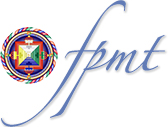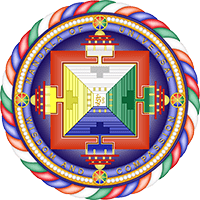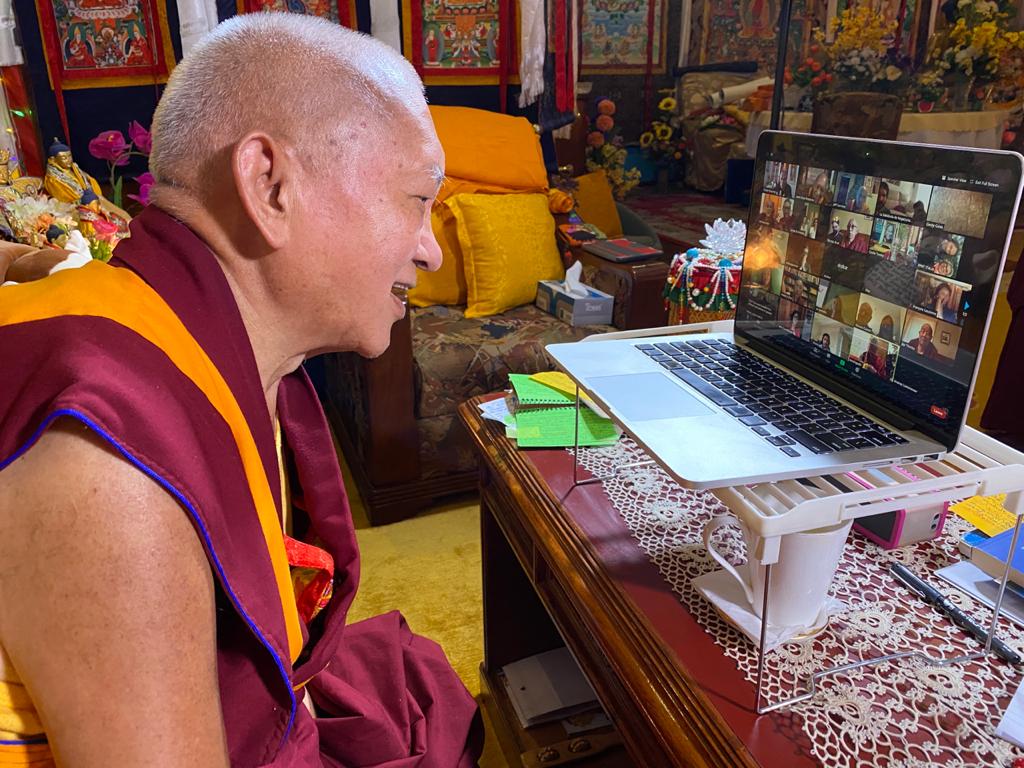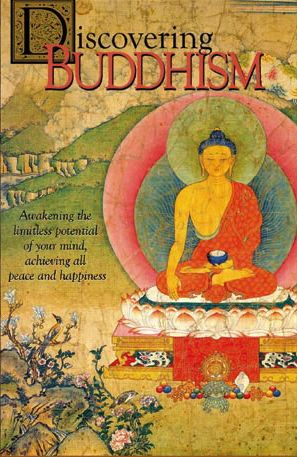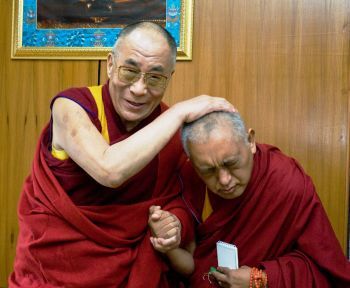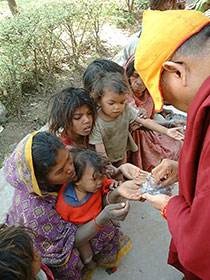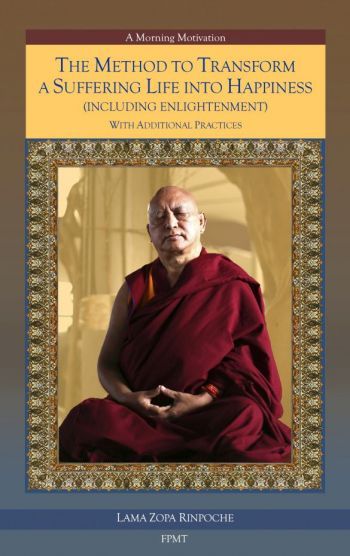- Home
- FPMT Homepage
Foundation for the Preservation of the Mahayana Tradition
The FPMT is an organization devoted to preserving and spreading Mahayana Buddhism worldwide by creating opportunities to listen, reflect, meditate, practice and actualize the unmistaken teachings of the Buddha and based on that experience spreading the Dharma to sentient beings. We provide integrated education through which people’s minds and hearts can be transformed into their highest potential for the benefit of others, inspired by an attitude of universal responsibility and service. We are committed to creating harmonious environments and helping all beings develop their full potential of infinite wisdom and compassion. Our organization is based on the Buddhist tradition of Lama Tsongkhapa of Tibet as taught to us by our founders Lama Thubten Yeshe and Lama Thubten Zopa Rinpoche.
- Willkommen
Die Stiftung zur Erhaltung der Mahayana Tradition (FPMT) ist eine Organisation, die sich weltweit für die Erhaltung und Verbreitung des Mahayana-Buddhismus einsetzt, indem sie Möglichkeiten schafft, den makellosen Lehren des Buddha zuzuhören, über sie zur reflektieren und zu meditieren und auf der Grundlage dieser Erfahrung das Dharma unter den Lebewesen zu verbreiten.
Wir bieten integrierte Schulungswege an, durch denen der Geist und das Herz der Menschen in ihr höchstes Potential verwandelt werden zum Wohl der anderen – inspiriert durch eine Haltung der universellen Verantwortung und dem Wunsch zu dienen. Wir haben uns verpflichtet, harmonische Umgebungen zu schaffen und allen Wesen zu helfen, ihr volles Potenzial unendlicher Weisheit und grenzenlosen Mitgefühls zu verwirklichen.
Unsere Organisation basiert auf der buddhistischen Tradition von Lama Tsongkhapa von Tibet, so wie sie uns von unseren Gründern Lama Thubten Yeshe und Lama Thubten Zopa Rinpoche gelehrt wird.
- Bienvenidos
La Fundación para la preservación de la tradición Mahayana (FPMT) es una organización que se dedica a preservar y difundir el budismo Mahayana en todo el mundo, creando oportunidades para escuchar, reflexionar, meditar, practicar y actualizar las enseñanzas inconfundibles de Buda y en base a esa experiencia difundir el Dharma a los seres.
Proporcionamos una educación integrada a través de la cual las mentes y los corazones de las personas se pueden transformar en su mayor potencial para el beneficio de los demás, inspirados por una actitud de responsabilidad y servicio universales. Estamos comprometidos a crear ambientes armoniosos y ayudar a todos los seres a desarrollar todo su potencial de infinita sabiduría y compasión.
Nuestra organización se basa en la tradición budista de Lama Tsongkhapa del Tíbet como nos lo enseñaron nuestros fundadores Lama Thubten Yeshe y Lama Zopa Rinpoche.
A continuación puede ver una lista de los centros y sus páginas web en su lengua preferida.
- Bienvenue
L’organisation de la FPMT a pour vocation la préservation et la diffusion du bouddhisme du mahayana dans le monde entier. Elle offre l’opportunité d’écouter, de réfléchir, de méditer, de pratiquer et de réaliser les enseignements excellents du Bouddha, pour ensuite transmettre le Dharma à tous les êtres. Nous proposons une formation intégrée grâce à laquelle le cœur et l’esprit de chacun peuvent accomplir leur potentiel le plus élevé pour le bien d’autrui, inspirés par le sens du service et une responsabilité universelle. Nous nous engageons à créer un environnement harmonieux et à aider tous les êtres à épanouir leur potentiel illimité de compassion et de sagesse. Notre organisation s’appuie sur la tradition guéloukpa de Lama Tsongkhapa du Tibet, telle qu’elle a été enseignée par nos fondateurs Lama Thoubtèn Yéshé et Lama Zopa Rinpoché.
Visitez le site de notre Editions Mahayana pour les traductions, conseils et nouvelles du Bureau international en français.
Voici une liste de centres et de leurs sites dans votre langue préférée
- Benvenuto
L’FPMT è un organizzazione il cui scopo è preservare e diffondere il Buddhismo Mahayana nel mondo, creando occasioni di ascolto, riflessione, meditazione e pratica dei perfetti insegnamenti del Buddha, al fine di attualizzare e diffondere il Dharma fra tutti gli esseri senzienti.
Offriamo un’educazione integrata, che può trasformare la mente e i cuori delle persone nel loro massimo potenziale, per il beneficio di tutti gli esseri, ispirati da un’attitudine di responsabilità universale e di servizio.
Il nostro obiettivo è quello di creare contesti armoniosi e aiutare tutti gli esseri a sviluppare in modo completo le proprie potenzialità di infinita saggezza e compassione.
La nostra organizzazione si basa sulla tradizione buddhista di Lama Tsongkhapa del Tibet, così come ci è stata insegnata dai nostri fondatori Lama Thubten Yeshe e Lama Zopa Rinpoche.
Di seguito potete trovare un elenco dei centri e dei loro siti nella lingua da voi prescelta.
- 欢迎 / 歡迎
简体中文
“护持大乘法脉基金会”( 英文简称:FPMT。全名:Foundation for the Preservation of the Mahayana Tradition) 是一个致力于护持和弘扬大乘佛法的国际佛教组织。我们提供听闻,思维,禅修,修行和实证佛陀无误教法的机会,以便让一切众生都能够享受佛法的指引和滋润。
我们全力创造和谐融洽的环境, 为人们提供解行并重的完整佛法教育,以便启发内在的环宇悲心及责任心,并开发内心所蕴藏的巨大潜能 — 无限的智慧与悲心 — 以便利益和服务一切有情。
FPMT的创办人是图腾耶喜喇嘛和喇嘛梭巴仁波切。我们所修习的是由两位上师所教导的,西藏喀巴大师的佛法传承。
繁體中文
護持大乘法脈基金會”( 英文簡稱:FPMT。全名:Found
ation for the Preservation of the Mahayana Tradition ) 是一個致力於護持和弘揚大乘佛法的國際佛教組織。我們提供聽聞, 思維,禪修,修行和實證佛陀無誤教法的機會,以便讓一切眾生都能 夠享受佛法的指引和滋潤。 我們全力創造和諧融洽的環境,
為人們提供解行並重的完整佛法教育,以便啟發內在的環宇悲心及責 任心,並開發內心所蘊藏的巨大潛能 — 無限的智慧與悲心 – – 以便利益和服務一切有情。 FPMT的創辦人是圖騰耶喜喇嘛和喇嘛梭巴仁波切。
我們所修習的是由兩位上師所教導的,西藏喀巴大師的佛法傳承。 察看道场信息:
- FPMT Homepage
- News/Media
-
- Study & Practice
-
-
- About FPMT Education Services
- Latest News
- Programs
- New to Buddhism?
- Buddhist Mind Science: Activating Your Potential
- Heart Advice for Death and Dying
- Discovering Buddhism
- Living in the Path
- Exploring Buddhism
- FPMT Basic Program
- FPMT Masters Program
- FPMT In-Depth Meditation Training
- Maitripa College
- Lotsawa Rinchen Zangpo Translator Program
- Universal Education for Compassion & Wisdom
- Online Learning Center
-
- Prayers & Practice Materials
- Overview of Prayers & Practices
- Full Catalogue of Prayers & Practice Materials
- Explore Popular Topics
- Benefiting Animals
- Chenrezig Resources
- Death & Dying Resources
- Lama Chopa (Guru Puja)
- Lama Zopa Rinpoche: Compendium of Precious Instructions
- Lama Zopa Rinpoche: Life Practice Advice
- Lama Zopa Rinpoche Practice Series
- Lamrim Resources
- Mantras
- Prayer Book Updates
- Purification Practices
- Sutras
- Thought Transformation (Lojong)
- Audio Materials
- Dharma Dates - Tibetan Calendar
- Translation Services
- Publishing Services
- Ways to Offer Support
- Prayers & Practice Materials
-
- Teachings and Advice
- Find Teachings and Advice
- Lama Zopa Rinpoche Advice Page
- Lama Zopa Rinpoche: Compendium of Precious Instructions
- Lama Zopa Rinpoche Video Teachings
- ༧སྐྱབས་རྗེ་བཟོད་པ་རིན་པོ་ཆེ་མཆོག་ནས་སྩལ་བའི་བཀའ་སློབ་བརྙན་འཕྲིན།
- Podcasts
- Lama Yeshe Wisdom Archive
- Buddhism FAQ
- Dharma for Young People
- Resources on Holy Objects
- Teachings and Advice
-
-
*If a menu item has a submenu clicking once will expand the menu clicking twice will open the page.
-
-
- Centers
-
- Teachers
-
- Projects
-
-
-
-
*If a menu item has a submenu clicking once will expand the menu clicking twice will open the page.
-
-
- FPMT
-
-
-
-
-
We can transform any problem, even death, into happiness. The point is not to stop the experience of problems but to stop the conditions that we call ‘problems’ from disturbing our mind, and instead use them to support the spiritual path that we practice.
Lama Zopa Rinpoche
-
-
-
- Shop
-
-
-
The Foundation Store is FPMT’s online shop and features a vast selection of Buddhist study and practice materials written or recommended by our lineage gurus. These items include homestudy programs, prayers and practices in PDF or eBook format, materials for children, and other resources to support practitioners.
Items displayed in the shop are made available for Dharma practice and educational purposes, and never for the purpose of profiting from their sale. Please read FPMT Foundation Store Policy Regarding Dharma Items for more information.
-
-
In-depth Stories
16

Lama Zopa Rinpoche with Khen Rinpoche Geshe Chonyi at Kopan Monastery, May 2020. Photo by Ven. Lobsang Sherab.
Khen Rinpoche Geshe Thubten Chonyi is abbot of Kopan Monastery and Kopan Nunnery, the FPMT monastic institutions in Kathmandu, Nepal, and resident geshe at Amitabha Buddhist Centre (ABC), the FPMT center in Singapore. This story is based on the July 2020 video “The Story of Khen Rinpoche Geshe Thubten Chonyi and the History of Kopan Monastery,” in which Khen Rinpoche shares his experiences from when he was a boy in the Solu Khumbu District of Nepal to being a monk at Kopan in the 1970s to becoming the abbot of Kopan Monastery.
Khen Rinpoche Geshe Thubten Chonyi was born in Solu Khumbu District, Nepal, in 1962, and was ordained by Lama Zopa Rinpoche at the age of twelve on Tibetan New Year.
His father, a carpenter, had developed a wish for one of his sons to become a monk after visiting Lawudo Gompa in Solu Khumbu—where Lama Zopa Rinpoche’s previous incarnation had meditated and where Rinpoche had established a monastery school called the Mount Everest Centre for Buddhist Studies in 1971—and seeing the little monks there. Lama Thubten Yeshe and Max Mathews (known as Mummy Max) visited their village in 1974, looking for young boys to join the Mount Everest Centre, which eventually moved year round to Kopan Monastery.
Khen Rinpoche’s father set out to meet Lama Yeshe, bringing along only Khen Rinpoche’s younger brother. But then before reaching Lama Yeshe, as Khen Rinpoche recounts, his father thought that he had better bring Khen Rinpoche, too, reasoning that if Lama Yeshe doesn’t accept both of his sons, he will accept one son. So his father returned home to get Khen Rinpoche.
“My mother told me that at that time I was washing my feet,” Khen Rinpoche says. “I was so excited to see Lama Yeshe. So I just completed washing one leg and had no time to wash the other leg. [As I left to go meet Lama Yeshe] I was wearing one shoe on my foot and carrying one shoe in my hand and rushing.” Happily, Lama Yeshe accepted Khen Rinpoche.
Four or five years after he began his monastic studies, Khen Rinpoche’s older brother, who was living in Kathmandu, advised Khen Rinpoche to leave the monastery and go to a school, thinking his brother wasn’t really studying at the monastery. When Khen Rinpoche consulted Khensur Rinpoche Lama Lhundrup, who was overseeing monastic education at Kopan, Khensur Rinpoche said, “If you go to a school what can you achieve? Just the basic knowledge, not much more than that. But then you are also creating so much negative karma in your life. So even if you don’t learn much, it is better to stay in the monastery. In this way every day you can collect merit all the time.”
Many teachers from Sera Je Monastery in South India, such as Geshe Doga and Geshe Jampa Gyatso, came to visit Kopan Monastery and teach philosophy. Scholastic monks from Sera Je Monastery also would sometimes stay at Kopan while on pilgrimage in Kathmandu. “Then we had to debate with them,” Khen Rinpoche explains. “Most of us were not good in debate at that time, so we were very nervous to debate with them. … I noticed that whatever questions were asked to the monks from Sera, they answered very well.” This inspired Khen Rinpoche to want to know everything about Buddhist philosophy.
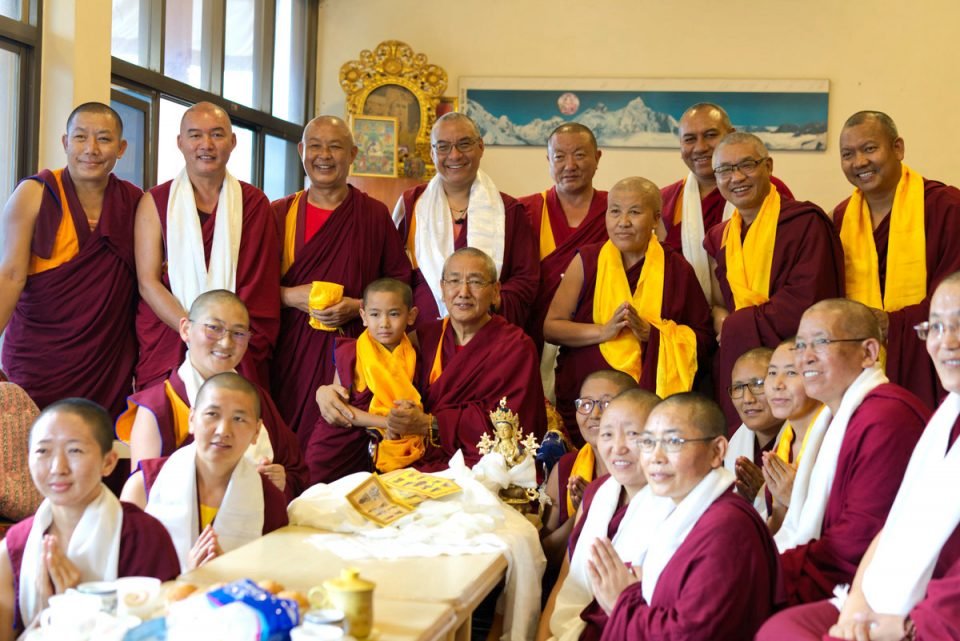
Khen Rinpoche Geshe Thubten Chonyi with Kopan monastics celebrating his birthday at Kopan Monastery, Kathmandu, Nepal, July 2020. Photo by Ven. Lobsang Sherab.
In 1980, Khensur Rinpoche Lama Lhundrup, Lama Yeshe, and Lama Zopa Rinpoche decided to send twelve Kopan monks to Sera Je Monastery to study. Lama Yeshe and Khensur Rinpoche asked Khen Rinpoche if he would want to go to Sera, which he did.
Khensur Rinpoche then accompanied the group of Kopan monks to Sera Je Monastery and stayed with them for the first month. Feeling discouraged after the first month, Khen Rinpoche told Khensur Rinpoche that he didn’t understand anything and wanted to return to Kopan. Khensur Rinpoche said, “One month is too short. So you must stay longer and try.”
Three or four months later, still feeling discouraged, Khen Rinpoche thought to return to Kopan. “But,” he said, “I didn’t have contact with my parents or my brother. At the same time I didn’t have money. So I couldn’t go back because there was no money for me to go back.”
After one year things improved. He understood more of what was being taught so he could debate with others. And Merry Colony, a long-time FPMT American student, began helping him at the request of Lama Zopa Rinpoche. Merry sponsored Khen Rinpoche until he graduated, about twenty years. He said, “Because of her support, I had a deep interest to study. Because of that, I was able to complete my studies.”
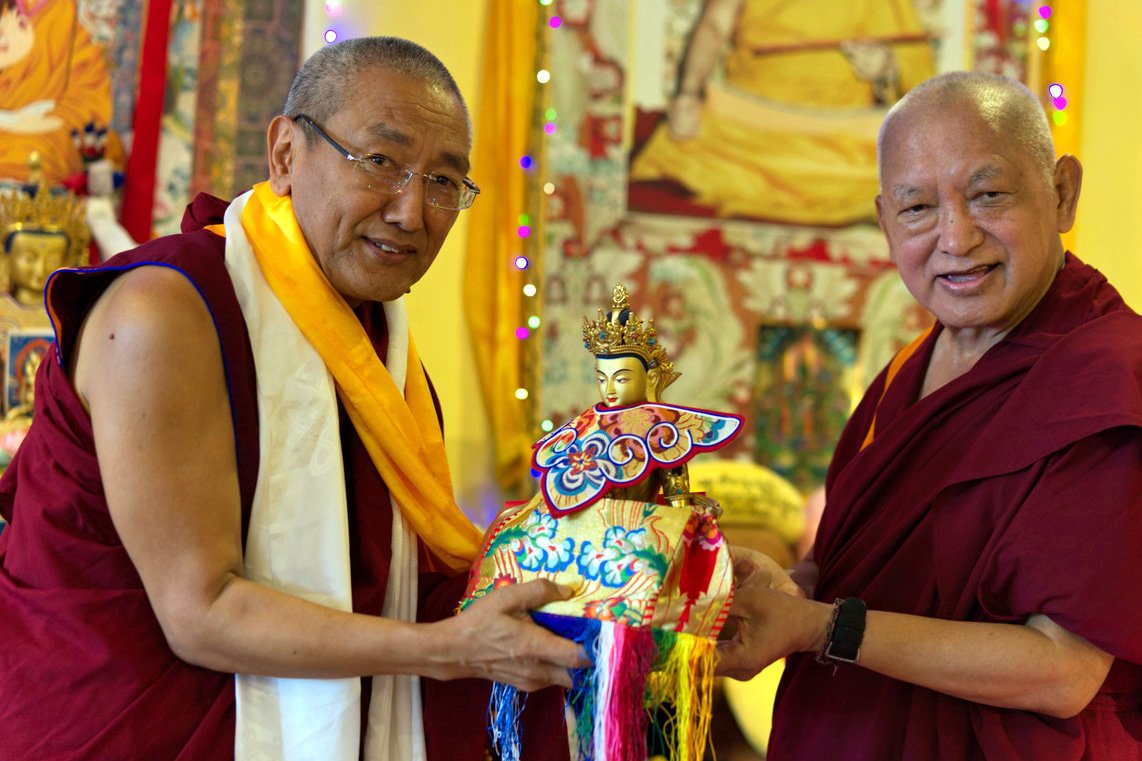
Khen Rinpoche Geshe Thubten Chonyi and Lama Zopa Rinpoche celebrating Khen Rinpoche’s birthday at Kopan Monastery, Kathmandu, Nepal, July 2020. Photo by Ven. Lobsang Sherab.
Khen Rinpoche received the geshe lamrampa degree in 1997 and then completed a year of study at Gyudmed Tantric College. After he completed his studies, his mother told him a story he had never heard before.
When he was three years old, she and his father decided to go to India and leave Khen Rinpoche with his grandparents in Nepal. One week after leaving Khen Rinpoche with his grandparents, she had a dream that he was requesting to her, “Please don’t go.” Feeling uneasy and worried something might happen to him if she went to India, she set out the next morning to bring him home. His father, unhappy, went to India alone. Shortly afterwards Khen Rinpoche became very sick. If she had gone to India, she told him, then he probably would have died.
He says, “When I heard that, it really touched my heart and tears came to my eyes. If my mother didn’t protect me at that time, then there’s no way I can study, no way I can graduate, no way I can teach.”
After completing his studies Khen Rinpoche taught philosophy to the young monks at Kopan for nine or ten months. Then Lama Zopa Rinpoche decided to send Khen Rinpoche to teach at Amitabha Buddhist Centre, the FPMT center in Singapore, and the center invited him.
When he went to Singapore in October 1999 he thought he would just try it for one year, but has now been there twenty-one years. After Khen Rinpoche began to teach the FPMT Basic Program at ABC at Lama Zopa Rinpoche’s request, Khen Rinpoche says, “Many people showed a big interest, especially the senior students. All of them came to the class. At the same time, I saw that people were very interested in learning Buddhist philosophy. They had very busy lives. They were at their jobs from morning until evening. Then they would have a quick dinner and come to class from 7:30-9:30 p.m. twice per week. When I saw that, it really encouraged me to teach more and share with them what I learned.”
About Lama Zopa Rinpoche’s visit to ABC in 2019, Khen Rinpoche says, “Rinpoche expressed that he was extremely happy about the center. He said that his wish is fulfilled. When Rinpoche expressed his happiness it really touched my heart. I am able to make a little contribution to fulfill Rinpoche’s wishes.”
In 2011, when Khensur Rinpoche Lama Lhundrup’s sickness got worse, Lama Zopa Rinpoche asked Khen Rinpoche to become abbot of Kopan. He advised Khen Rinpoche to spend eight months each year teaching at ABC and four months looking after Kopan.
“Who I am now is truly due to the kindness of the teacher, the gurus who teach me, who guide me, who show me the true path,” Khen Rinpoche says. “The best way to repay the guru’s kindness is to follow the guru’s advice as much as possible and fulfill the guru’s wishes. This way we make our lives meaningful.”
Watch “The Story of Khen Rinpoche Geshe Thubten Chonyi and the History of Kopan Monastery” on YouTube:
https://youtu.be/-4GMJ-68xI8
You can find more information about Kopan Monastery and Kopan Nunnery online.
For information about Amitabha Buddhist Centre, please visit their website.
- Tagged: amitabha buddhist centre, fpmt history, geshe doga, geshe jampa gyatso, geshe thubten chonyi, in-depth stories, khen rinpoche geshe chonyi, khensur rinpoche lama lhundrup, kopan monastery, lama yeshe, merry colony, sera je monastery, sera je monastic university, ven max mathews
27
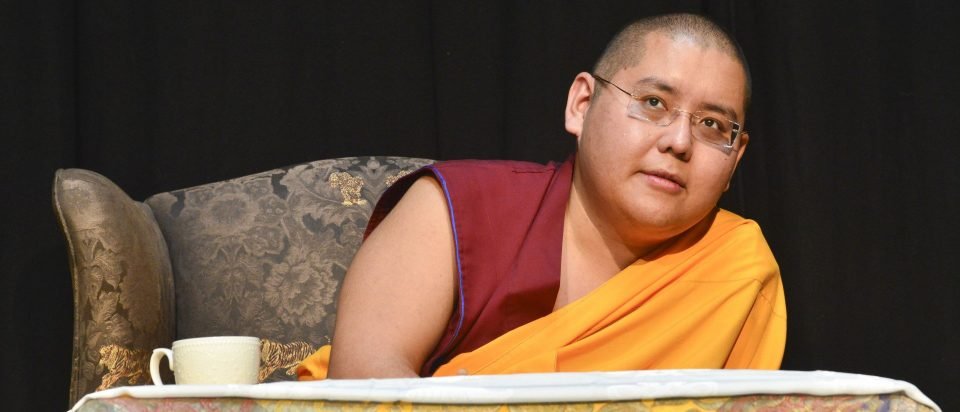
His Eminence Ling Rinpoche, Avondale College Theatre, Auckland, New Zealand, March 2020. Photo by Peter Tram.
His Eminence the 7th Kyabje Yongzin Ling Rinpoche visited New Zealand during the Fifteen Days of Miracles from February 26 to March 21, 2020. Rinpoche visited FPMT centers Dorje Chang Institute for Wisdom Culture on February 29–March 2, Amitabha Hospice Service on March 3, Mahamudra Centre on March 6–8, and Chandrakirti Tibetan Buddhist Meditation Centre on March 10–15.
Dorje Chang Institute spiritual program coordinator Gyalten Wangmo, Mahamudra trustees Ven. Tenzin Nangsel and Katrina Robertson, Amitabha Hospice operations manager Anjalee Pieries, and Chanrakirti spiritual program coordinator Jennifer Coyne share the story.
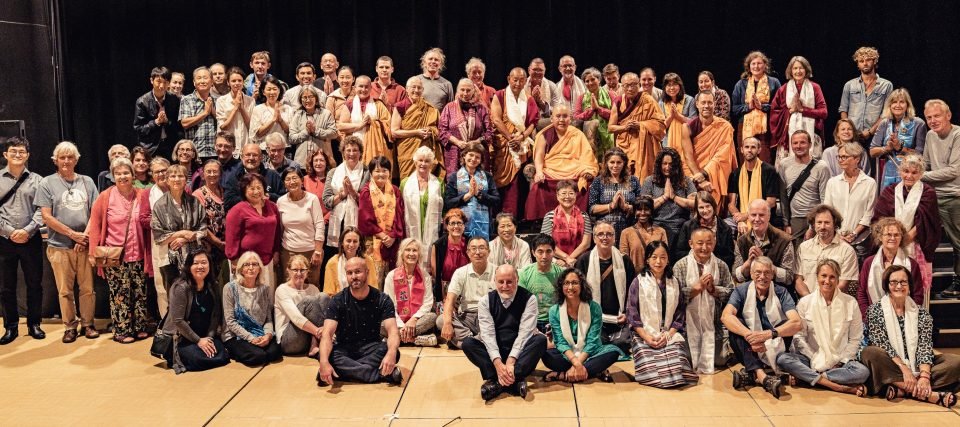
His Eminence Ling Rinpoche, Avalon College Theatre, Auckland, New Zealand, March 2020. Photo by Dirk Jutzas.
His Eminence the 7th Kyabje Yongzin Ling Rinpoche’s delightful and meaningful first visit to New Zealand started in Auckland at Dorje Chang Institute for Wisdom Culture (DCI).
During the visit, His Eminence Ling Rinpoche’s presence showed the aspect of relaxedness, acute precise awareness, warm friendliness, and a deep happiness and joyfulness. His Eminence offered such clear, precise, accessible, and practical teachings about how to get the experience of Dharma, emphasizing how to have realistic expectations about our practice. His Eminence taught on “Transforming Problems into Happiness: The Eight Verses of Thought Transformation,” “Compassion and Loving Kindness Meditation,” “Public Talk: A Peaceful Mind in a Turbulent World,” and “An Introduction to the Secret, Profound Practice of Tonglen.”
We hired an outside venue, Avondale College Theatre, to allow for greater attendance. In total we had approximately 428 attendees. This visit was supported by the generosity of volunteers and benefactors, big and small, who took responsibility to make meaningful contributions so that everyone could benefit.
Geshe Wangchen, our FPMT resident teacher, welcomed the opportunity to offer His Eminence Ling Rinpoche and his entourage—Ven. Kartsön (Yaki Platt), Ven. Tenzin Khentse, and Geshe Lobsang Yonten—outings to a variety of beaches and other places in Auckland. Geshe-la said that especially when they went for walks and swimming, it was an unforgettable time.
His Eminence Ling Rinpoche expressed, during a thank you tea with core visit volunteers, that His Eminence enjoyed the time at DCI, commenting that it is a beautiful center with so much green land—including jungle—and yet is so centrally located for people. The center was nourished by His Eminence showing the aspect of enjoying and appreciating DCI’s environment and center.
We sincerely thanked His Eminence Ling Rinpoche for all of the blessings and believe much benefit was offered through the visit through the precious teachings people received, the service they offered, and the connections they made for the future.
While in Auckland, His Eminence Ling Rinpoche also met with and gave advice to the local Tibetan community in Auckland, and visited Tashi Gomang Centre and the Kagyu Buddhist Centre.
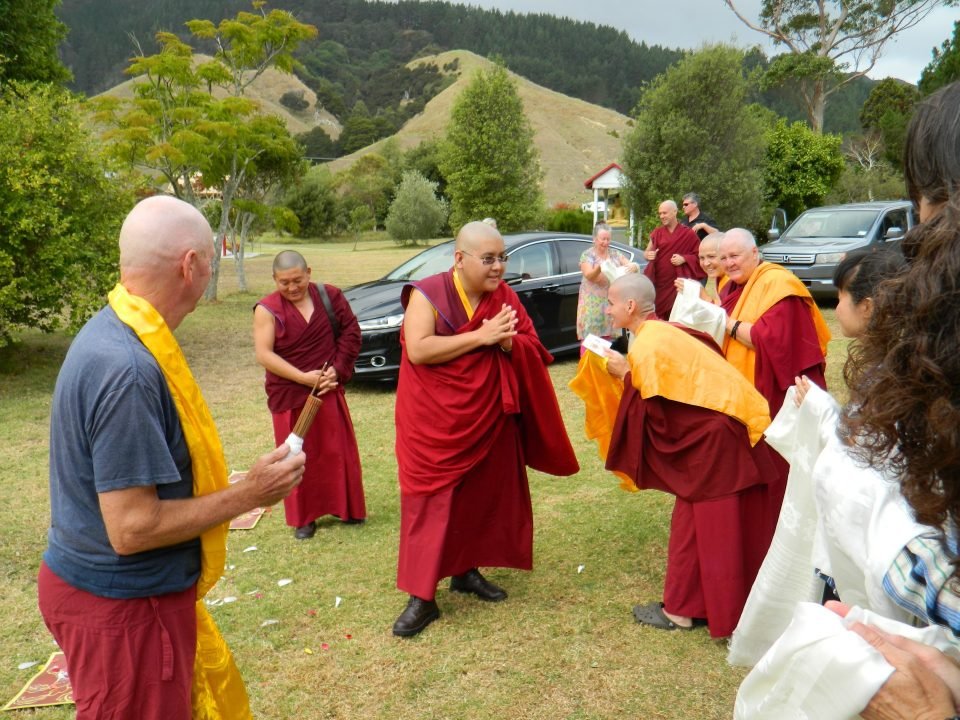
His Eminence Ling Rinpoche, Mahamudra Centre, Colville, New Zealand, March 2020. Photo by Niki Arends.
For many weeks Mahamudra Centre was filled with hustle and bustle akin to preparing for a royal visit. We were fortunate to have several experienced and enthusiastic Sangha members staying at the center at the time to assist with preparations.
The trip from Auckland was not a smooth one. The brand new car’s air-conditioning unit decided not to work and for no apparent reason would only blow hot air on the four passengers on what was an unusually hot and humid day.
After stopping the car in desperation twenty minutes into the trip, thinking His Eminence Ling Rinpoche would need to be transferred to the vehicle transporting Ven. Kartsön and the luggage, the air conditioning proceeded to work perfectly. Rinpoche showed his sense of humor by advising the driver that she would be recorded in his biography as “the woman who tried to cook the Lama.”
The Mahamudra Centre community welcomed His Eminence Ling Rinpoche into our very New Zealand rainbow decorated gompa, where we did the traditional welcome. Rinpoche, humble and gentle, was beautifully attended to by his team. Their soft and gentle manner settled the most nervous among us, and we couldn’t help but beam radiant smiles.
The center is located on eight acres of land on the remote Coromandel Peninsula. In true rural Kiwi style one of the center’s founders, Roy Fraser, organized a road trip. Heading north on the dirt roads, Hi Eminence Ling Rinpoche was shown the rugged beauty of the coast and mountains on the tip of the peninsula.
His Eminence Ling Rinpoche’s daily walks included a search for sheep, an encounter with the local goat, a pat for a lucky horse, and blessings given to calves being readied for transport.
The weekend program included “An Introduction to White Tara Practice,” teachings on The 37 Practices of a Bodhisattva, and an Orange Manjushri initiation. The teachings were pertinent for our center, where many personalities work together and the path is not always easy. These teachings provided a solid foundation to fall back on when things are not smooth.
After the Mahamudra Centre events concluded, His Eminence Ling Rinpoche visited and met with students at the local Chinese Buddhist Centre.
We are grateful for His Eminence Ling Rinpoche’s willingness to travel far distances to reach students of the Dharma. We pray for Rinpoche’s long life, the spreading of Rinpoche’s teachings throughout the world, and that we will meet Rinpoche in New Zealand again.

His Eminence Ling Rinpoche with patients, volunteers, staff, and trustees, Amitabha Hospice Service, Auckland, New Zealand, March 2020. Photo by Rinchen Dhondup.
Amitabha Hospice Service staff, patients, and volunteers had the opportunity to meet and greet His Eminence Ling Rinpoche when he visited Amitabha Hospice Service, the only Buddhist hospice in New Zealand, on March 3. Rinpoche was very impressed by the hospice’s work and commended all of the staff and volunteers for all they do to help the elderly and vulnerable people in our community. We were very much honored by this visit and Rinpoche’s blessings.
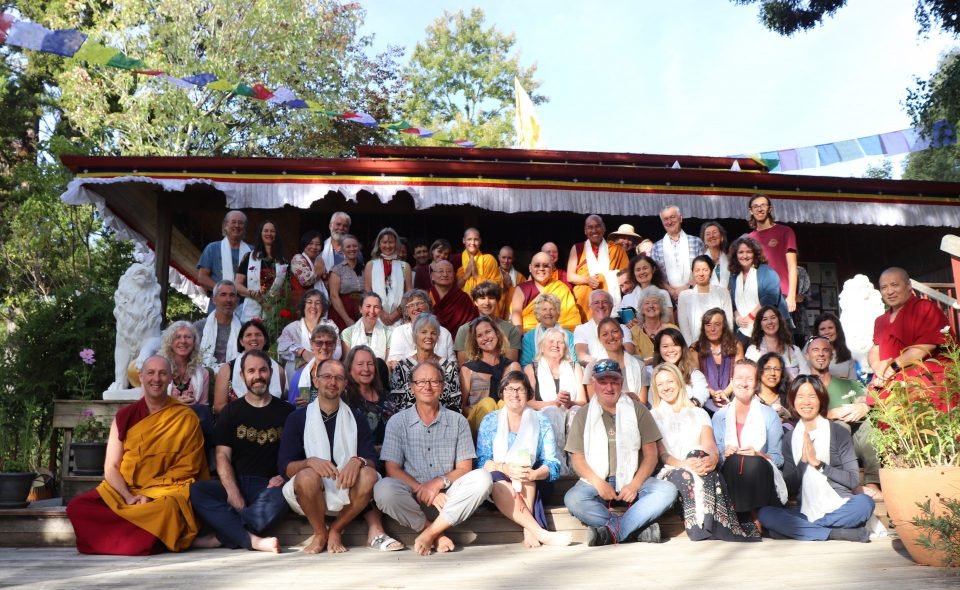
His Eminence Ling Rinpoche, Chandrakirti Centre, Nelson, New Zealand, March 2020. Photo by Seija Brogi.
His Eminence Ling Rinpoche’s visit to Chandrakirti Centre was wish-fulfilling for the whole community. On March 10 Rinpoche was welcomed at the airport by center FPMT resident teacher Geshe Jampa Tharchin, director Phillipa Rutherford, and students. Rinpoche came directly to Chandrakirti Centre, where after the traditional welcome Phillipa gave a short speech, observing the auspiciousness of Rinpoche’s arrival day as it was also the day Maitreya is predicted to arrive. Rinpoche chuckled on hearing this.
The following day His Eminence Ling Rinpoche took a short tour of the center and blessed the stupa, the prayer wheel house under construction, and the giant Buddha statue. Geshe-la introduced Rinpoche to the Chandrakirti resident ducks, and Rinpoche paused to feed the ducks!
The following day His Eminence Ling Rinpoche toured the new retreat land project, Wish Fulfilling Land. Rinpoche admired the earth bricks we had been making. Phillipa and Geshe-la shared Lama Zopa Rinpoche’s vision for the retreat land. His Eminence Ling Rinpoche led prayers and blessed the land, then tied a khata to a tree.
On Friday evening His Eminence Ling Rinpoche gave a public talk in a packed Nalanda Hall on “Overcoming Anxiety.” Rinpoche took questions at the end and everyone left with a warm, happy, peaceful feeling.
On Saturday and Sunday His Eminence Ling Rinpoche very kindly gave us the oral transmission and commentary on The Three Principal Aspects of the Path, reminding us to make life meaningful by developing a stable foundation in renunciation, bodhichitta, and emptiness. On Sunday afternoon Rinpoche gave a White Tara initiation, which was a very auspicious and moving occasion for everyone.
Following the events at Chandrakirti Centre, His Eminence Ling Rinpoche continued his New Zealand tour in Dunedin and Christchurch, before returning to India.
His Eminence Ling Rinpoche’s visit to New Zealand was a very special and memorable experience. We all hope that we have the merit for Rinpoche to return to New Zealand very soon!
For more information about the FPMT centers in New Zealand, please see their listing in the FPMT directory.
- Tagged: amitabha hospice service, chandrakirti centre, dorje chang institute, in-depth stories, kyabje ling rinpoche, mahamudra centre
6
Geshe Tenzin Zopa Welcomed to Broome, Western Australia
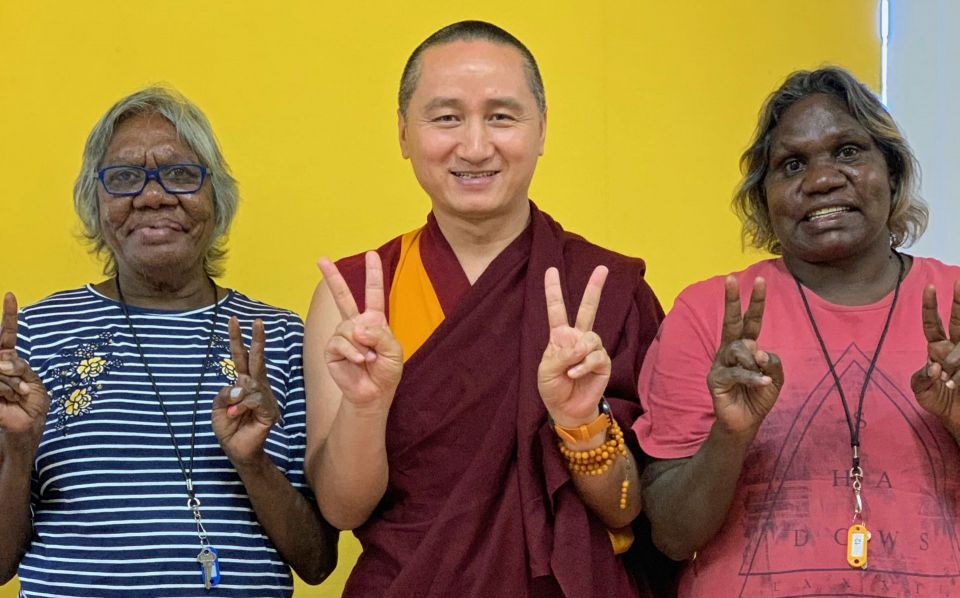
Geshe Tenzin Zopa with Kathleen Everett and Jemma Galova, Women’s Healthy Relationships Group at Broome Recovery Centre, Broome, Western Australia, March 2019. Photo by Sandy Faber.
Geshe Tenzin Zopa, an FPMT touring teacher, visited the Gyalwa Ensapa Broome Buddhist Study Group, an FPMT study group located in a coastal town in northern Western Australia. The week spent together left lasting impressions on everyone involved. Sandy Faber, Gyalwa Ensapa Broome Buddhist Study Group coordinator, shares the story.
In March 2019, Gyalwa Ensapa Broome Buddhist Study Group was fortunate to have Geshe Tenzin Zopa visit Broome and engage with a variety local of First Nation, health, and community groups, forming connections with people and discussing various topics from a Buddhist psychology perspective.
Broome is a small town on the northwest coast of Western Australia, on traditional Djugun Yawuru lands, where the red Great Sandy Desert meets the blue tropical Indian Ocean. The hot and humid wet season weather was in force during Geshe-la’s visit. Broome’s population of 14,500 is a wonderful mixture of Indigenous Aboriginal First Nations people along with (due to a history of pearl-hunting in the area) Japanese, Malay, and Indonesian intermixed families, as well as more recent western European arrivals.

Geshe Tenzin Zopa with local First Nations Yawuru and Karajarri Elder Jimmy Edgar, Broome, Western Australia, March 2019. Photo by Sandy Faber.
Geshe-la’s visit began on March 21, 2019, with a Welcome to Country ritual by local First Nations Yawuru and Karajarri elder, Jimmy Edgar. Geshe-la and Jimmy connected immediately as they shared, compared, and exchanged cultural knowledge. Jimmy accompanied Geshe-la to an afternoon Harmony Day event held at Broome CIRCLE, where Geshe-la had been invited to speak by the HelpingMinds group. Everyone at this event was Welcomed to Country by Yawuru representative Natalie Dean. Most appropriately and fortuitously, Geshe-la spoke about receiving the 2019 Global Peace Leadership and Excellence Award and the importance of practicing harmony.
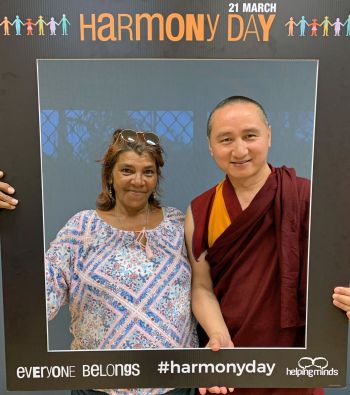
Geshe Tenzin Zopa with Yawuru representative Natalie Dean at Broome CIRCLE, Broome, Western Australia, March 2019. Photo courtesy of Sandy Faber.
Geshe-la said harmony is the basis for all positive achievements on an individual, community, state, national, and international level. Harmony is practiced through love, kindness, compassion, and respect. We can practice by seeing and respectfully acknowledging qualities in others, and expressing our respect through the actions of our body, speech, and mind. He told us harmony is also present in the practice of “the wisdom of understanding the interdependence among all of the different cultures, ethnicities, beliefs, and not only humans but also nature, including oceans, space, and plants.”
Geshe-la expressed that if we are first able to practice harmony perfectly towards ourselves, then we will also be able to practice it towards our loved ones, family members, and further within our community at the local, state, national, and international levels. He said, “Even within a small family of two people if you are able to practice respect, compassion, and loving kindness for each other then this will bring success, happiness, joy, fulfillment, and the meaning of life to that family.”
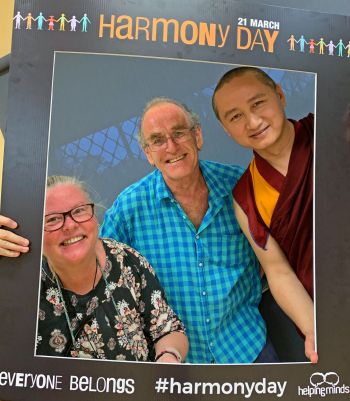
Geshe Tenzin Zopa with Sandy Faber and Neil Turner at Broome CIRCLE, Broome, Western Australia, March 2019. Photo courtesy of Sandy Faber.
“My belief and understanding is that the best solution, the best antidote to overcoming violence, depression, misunderstandings, disrespect, self-centeredness, or greediness is harmony expressed through love, kindness, compassion, and respect,” Geshe-la said. Harmony is a simple practice that everyone is able to engage in. “It doesn’t require money or someone else’s approval to practice,” Geshe-la told us. “It can be practiced by anybody: young and old, poor and rich, the powerful and less powerful.” Harmony can be practiced by people from any belief system or way of thinking.
Geshe-la shared, “Harmony doesn’t mean you have to go shake hands with someone or smile all of the time. The first move is to start within, by harmonizing one’s positive energy with oneself: loving oneself correctly, practicing compassion for oneself, offering respect to oneself. Then take that energy, that practice, that attitude and share it, beginning with the person nearest to you. This could be your children or your spouse.”
Geshe-la concluded by saying, “May we all be able to practice this practice of harmony perfectly to the best of our ability. May the world be completely actualized in the practice of harmony.”
Watch Geshe Tenzin Zopa’s twelve-minute Harmony Day talk on YouTube:
https://youtu.be/QsmSfQWNbmE
The following day Geshe-la was invited to speak about mental health at a Mental Health Luncheon at Mabu Liyan, a government-run mental health rehabilitation center with locations in Broome and East Kimberley Kununurra. This was well attended by the local Broome mental health team as well as the East Kimberley Kununurra team who work at another center 1,000 kilometers (621 miles) away and attended the luncheon via video conference!
The next morning, Saturday, March 23, Geshe-la gave a two-hour public talk kindly hosted and sponsored by the Broome Convention Centre. Geshe-la spoke to a small gathering about the hardships of growing up and overcoming challenges. He also spoke about the making of the film Unmistaken Child, which had been screened as a fundraiser prior to Geshe-la’s visit.
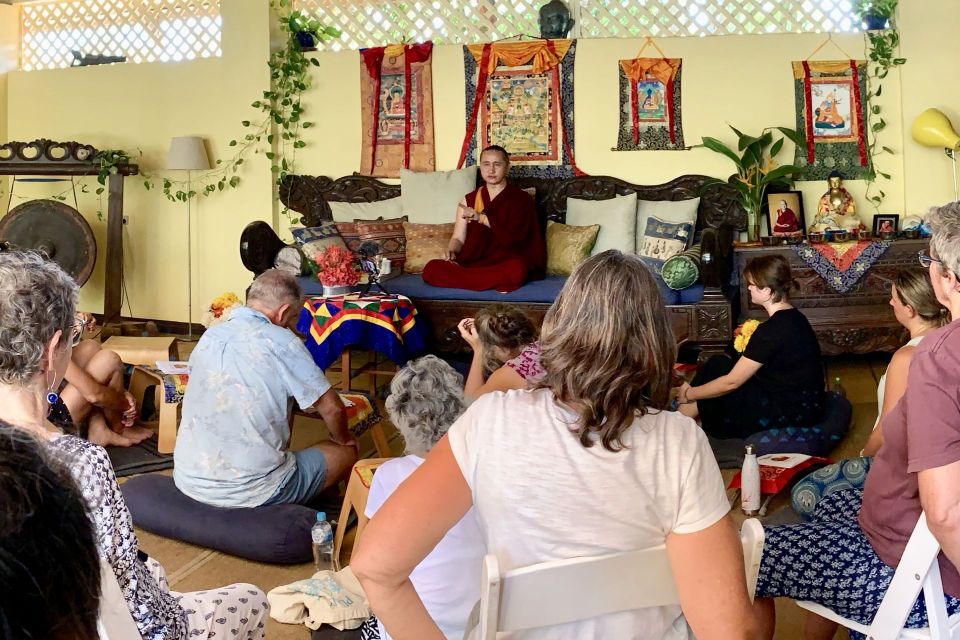
Geshe Tenzin Zopa, Blue Body Spiritual Centre’s Buddha Sanctuary, Broome, Western Australia, March 2019. Photo by Sandy Faber.
That afternoon Geshe-la spoke on “How to Find Serenity in Difficult Times: How can we work on ourselves and our minds to become a positive force in the world” for two hours at a well-attended event. The venue, Buddha Sanctuary, was generously offered by Broome Blue Body Spiritual Centre.
On Sunday morning, March 24, Geshe Tenzin Zopa presented a special talk “Self Care and Managing Stress” for people working in the health sector. The event took place at the government-run Broome Recovery Centre, which provides programs, support, training, and employment opportunities for people recovering from mental health issues. This talk attracted many of the people in our community who are caring for and working with clients in a health role. Geshe-la discussed ways of maintaining one’s own health and well-being and avoiding burnout.
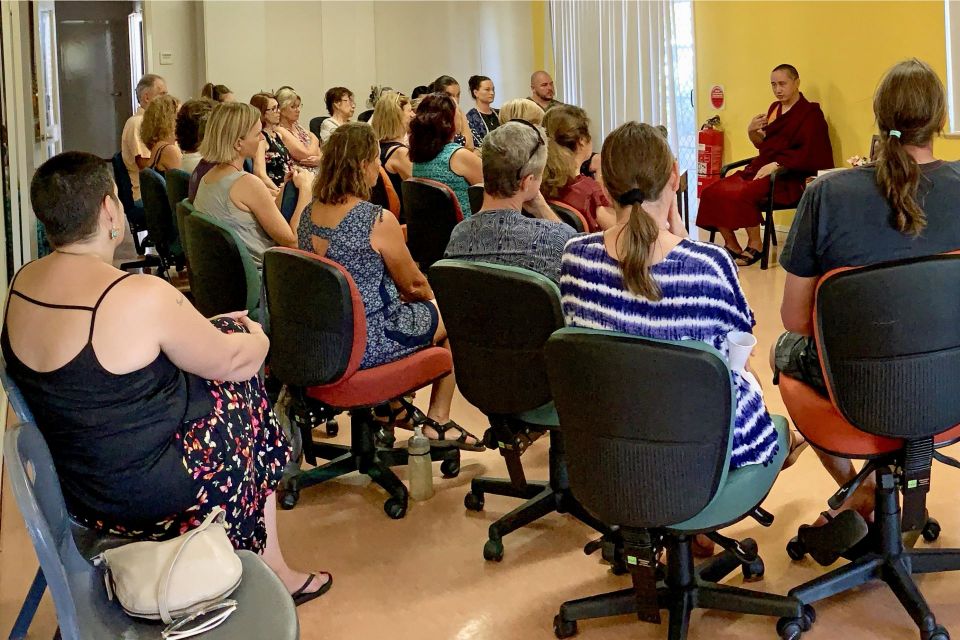
Geshe Tenzin Zopa, Broome Recovery Centre, Broome, Western Australia, March 2019. Photo by Sandy Faber.
Many attendees expressed their gratitude by sharing the positive effects that Geshe-la had on their minds and the way his talk benefitted their carer situations.
“I am grateful to have had the opportunity to meet this Buddhist master here in my very own hometown of Broome,” one carer said. “I have learned so much from the two hours spent sitting with you: having an unstructured friendly conversation around self-care while caring for others, and hearing your stories of challenge with a positive viewpoint was very powerful and inspiring.”
Another carer said, “My biggest take-home message from today is that we can find the strength to keep going if what we do is based on compassion, and we are genuinely doing the best we can to help ourselves and others as individuals.”
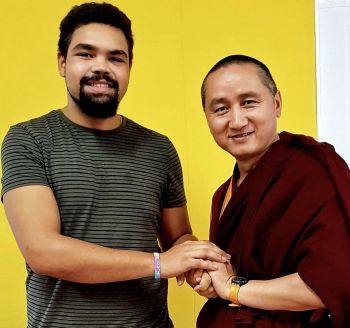
Geshe Tenzin Zopa with Jacob Corpus-Smith, Broome Recovery Centre, Broome, Western Australia, March 2019. Photo by Sandy Faber.
One of the attendees was Jacob Corpus-Smith, age 22, who works in a full-time position in social and emotional well-being at Kimberley Aboriginal Medical Services. Jacob is also involved in youth suicide prevention as a youth ambassador, organizing leadership forums to give Kimberley youth a greater voice in the national youth suicide prevention conversation.
After hearing from Geshe-la Jacob said, “All the small things we do in our role as carers, whether it be as parents, partners, family members, friends, community members, and even pet owners, need to be celebrated within ourselves and with the people we care about!”
A person who cared full-time for her mother in the end of her life expressed, “Many thanks to my Inspiring Buddhist Monk. Geshe appeared for me at the right time, and I was at the right place to be inspired by his powerful words of wisdom. These words have helped me see and move through my years of trauma with positive healing energy. Moving forward has become an easier process for me. Thank you, Geshe Tenzin Zopa.”
That afternoon Geshe-la presented about “Letting Go: A Buddhist Perspective: How do we acknowledge our past hurts, grief, and anger, and begin to let go of our disturbing emotions” at Buddha Sanctuary. He investigated and discussed ways to heal our minds and past mental experiences from a Buddhist perspective. Geshe-la also gave the Broome Buddhists instructions and explanations on prostrations.
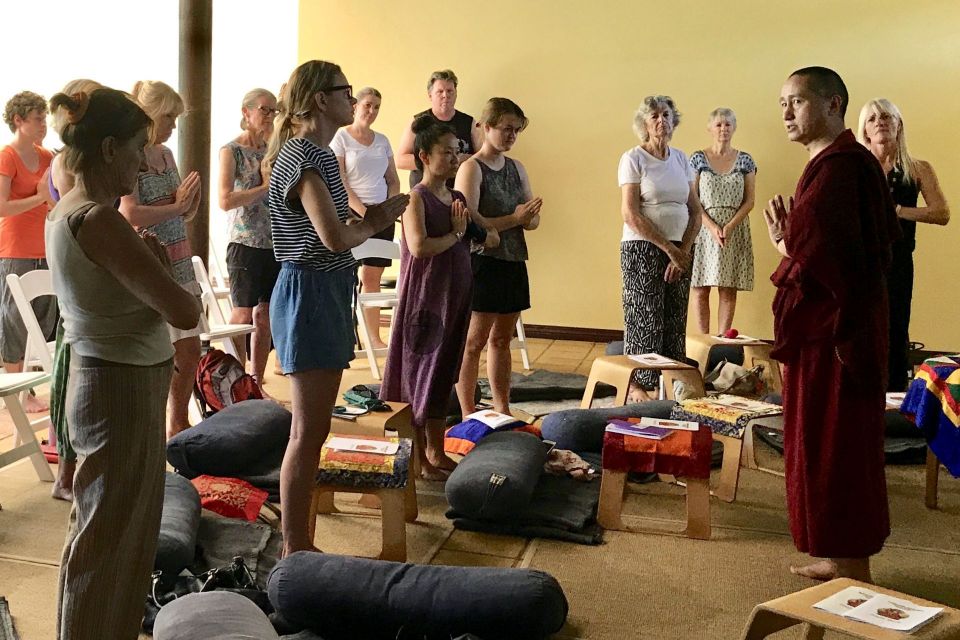
Geshe Tenzin Zopa, Blue Body Spiritual Centre’s Buddha Sanctuary, Broome, Western Australia, March 2019. Photo by Sandy Faber.
Next, on Monday morning, March 25, Geshe Tenzin Zopa visited the Broome Recovery Centre again, this time to meet with the Women’s Healthy Relationship Group, a collaboration between nonprofit Broome Youth and Families Hub and Kimberley Mental Health and Drug Service Team, led by Women’s Healthy Relationship Group facilitator Jasmine Phillips.
The Women’s Healthy Relationship Group participants were really impressed with Geshe-la and later sat with drug and alcohol rehabilitation counselor, Lesley Baxter, to reflect on the session.
One participant said, “[He talked] about his upbringing and what his country was like, how he became a monk and went to school. He had to wait a long time to become a monk. He never gave up. He made me feel sorry because of his stories. I felt sorry for his early life … how he used to get picked on when he was small.”
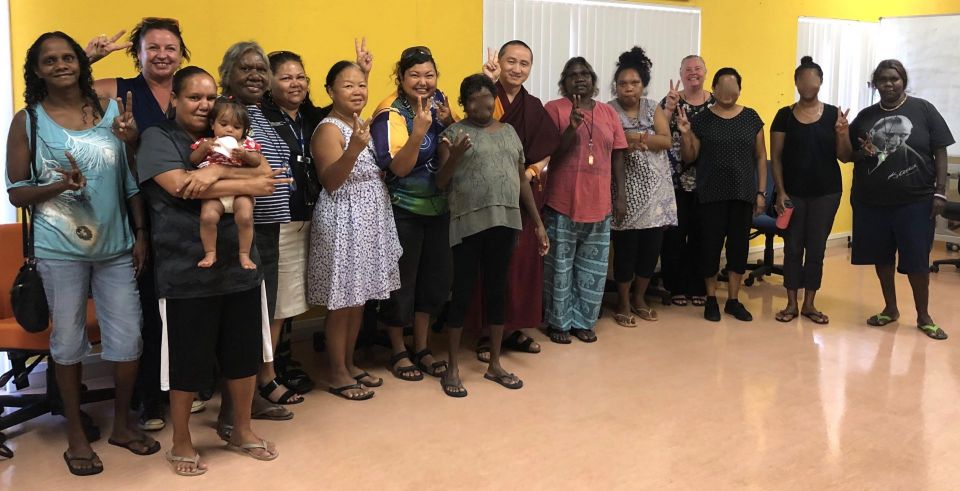
Lizzie, Bee, Shayna with baby, Kathleen, Cheryl, Mali, Jasmine (Jazzi), unnamed, Geshe Tenzin Zopa, Jemma, Melody, Sandy, unnamed, unnamed, and Jermaica, Women’s Healthy Relationship Group at Broome Recovery Centre, Broome, Western Australia, March 2019. Photo by Lesley Baxter.
“He made me feel calm and happy inside,” another participant said. “I still think about him and how he talked. He looked so calm when he talked and that made me calm.” Someone else shared, “He was warm and friendly. He loved meeting Aboriginal people. I was happy to meet him.”
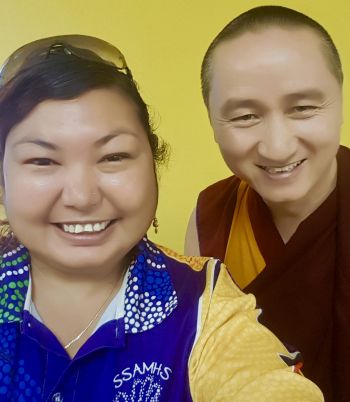
Geshe Tenzin Zopa with Jasmine (Jazzi) Phillips, Broome Recovery Centre, Broome, Western Australia, March 2019. Photo by Jasmine Phillips.
Someone else commented, “I thought he was inspiring. He talked about looking at things in different ways.” Another participant said, “He came with a very positive way of looking at life.” Another group participant noted, “I found that he was calming. He helped us look at the beauty of things.”
Someone shared, “He said that he thought that Tibetans and Aboriginal people have the same sort of beliefs. They are people of the earth. He talked about the belief systems of Aboriginal people, like reincarnation.”
Another person said, “He talked about valuing women: that women give birth, they look after the children, that women are very loving and caring. We didn’t know that they were valued like that.” Someone else said, “It was very easy to understand what he was saying.”
That same day Broome radio station Radio Goolarri (99.7 FM) Indigenous station manager and presenter Matty J (Matthew Francis) invited Geshe Tenzin Zopa to the station to pre-record a radio interview. Geshe-la articulated a very thoughtful message to the global community about Buddhist practice and the requirements for world peace and harmony.
Listen to Geshe Tenzin Zopa’s March 25, 2019, Radio Goolarri interview on YouTube:
Part 1: https://youtu.be/V9FDgB9ae6k
Part 2: https://youtu.be/2zMlcdEV_yg
Geshe Tenzin Zopa presented an interactive discussion session on “Dealing with Addictions” at Broome’s non-governmental Milliya Rumurra Drug and Alcohol Rehabilitation Centre. Millya Rumarra’s program coordinator, Phoebe McGuiness Morich, commented, “People were most receptive to Geshe-la’s wisdom and sharing stories concerning addiction, the pure mind and the ability to change, and the ability to reach one’s own desired potential.”
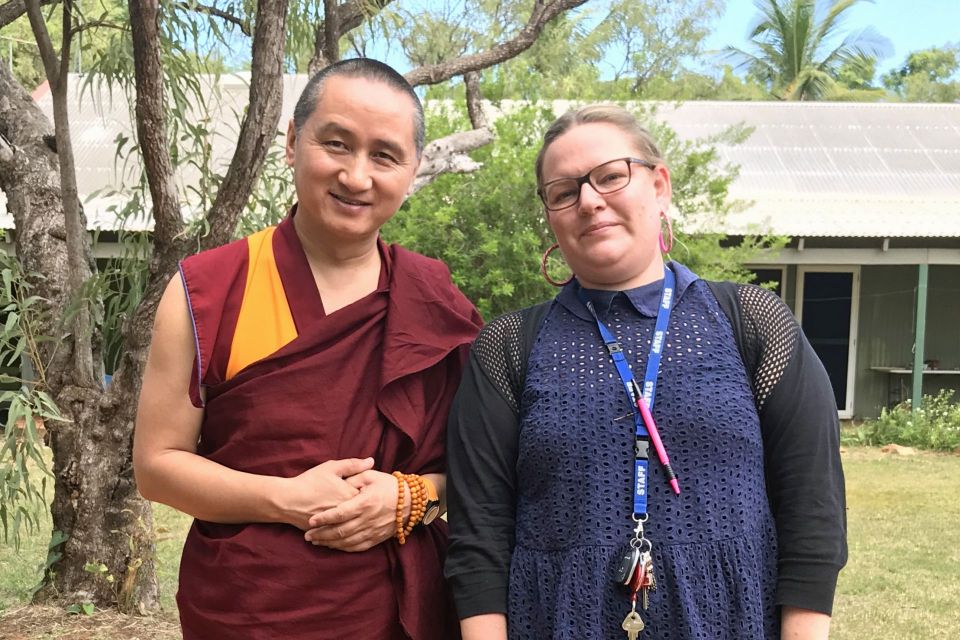
Geshe Tenzin Zopa and Phoebe McGuiness Morich, Milliya Rumurra Drug and Alcohol Rehabilitation Centre, Broome, Western Australia, March 2019. Photo by Sandy Faber.
Geshe-la also enjoyed a most interesting outing to Reddell Beach with Dianne Bennett of Broome’s Dinosaur Coast Management Group, a nonprofit organization protecting and promoting dinosaur tracks of Dampier Peninsula, to check out the huge and impressive sauropod dinosaur track imprints visible at low tide.
Geshe-la enjoyed his time in Broome, connecting with a myriad of locals, including many canine friends such as Didj.
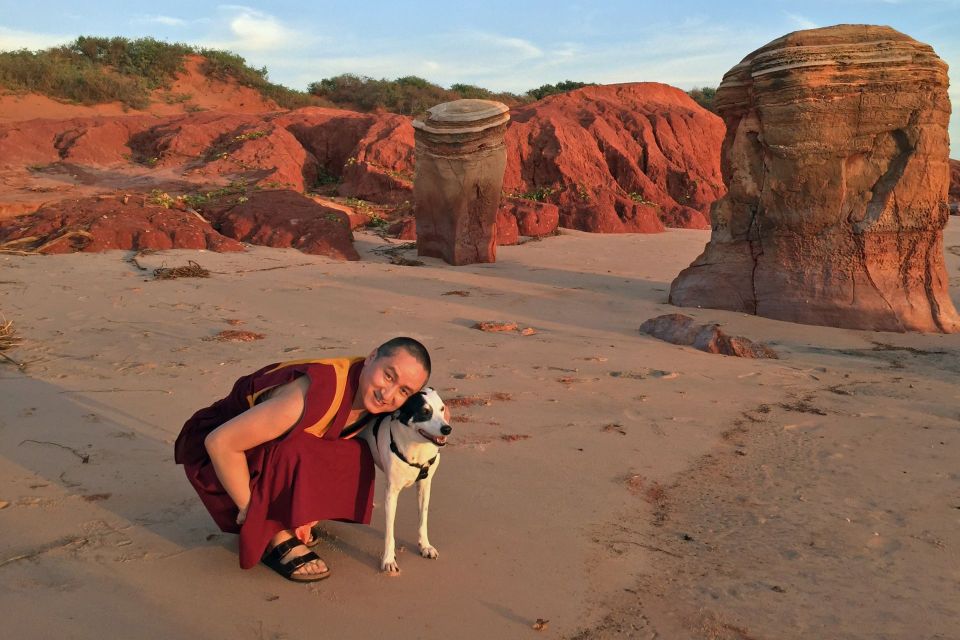
Geshe Tenzin Zopa with Didj, Reddell Beach, Broome, Western Australia, March 2019. Photo by Lily Chin.
It was so wonderful to have Geshe Tenzin Zopa visit Broome. Everything easily fell into place, and a wonderful and interactive program naturally unfolded. Individuals and groups continue to ask when Geshe-la will return. Community members are eager to continue to engage in the above types of presentations and discussions, and would like to further extend discussions into the topic of suicide prevention and coping with suicides in a community and family context. A thousand loving thanks to Geshe-la, and please, please, please visit us again!
For more information about Gyalwa Ensapa Broome Buddhist Study Group, visit their website:
http://gebbsg.org.au/
12
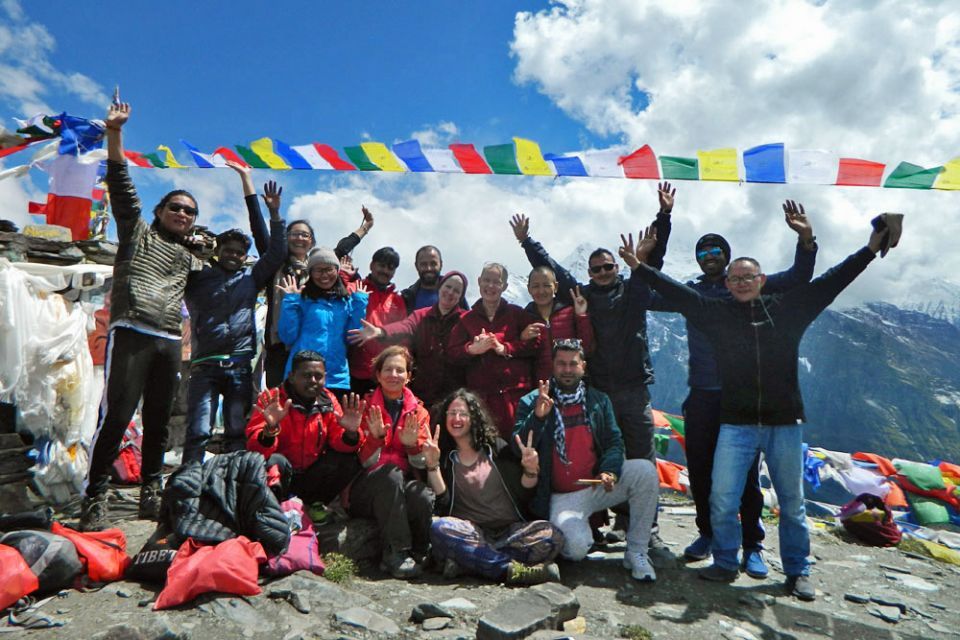
Drilbu Ri, Lahaul Spiti district, Himachal Pradesh, India, August 2019. Photo courtesy of Tushita Meditation Centre.
The FPMT resident teacher, staff members, and volunteers from Tushita Meditation Centre, the FPMT center in Dharamsala, Himachal Pradesh, India, went on pilgrimage to Lahaul (Garsha) in August 2019. The group traveled together in the Tushita bus and two additional vehicles on a route which included crossing the Rohtang Pass on the Leh-Manali Highway from Kullu district to the Lahaul Spiti district in Himachal Pradesh. Ven. Tenzin Kunphen, spiritual program coordinator, and Maria Nobuko Corrales, creative project assistant, share the story.
In August 2019, the Tushita staff did something remarkable following Lama Zopa Rinpoche’s advice. We closed our doors for a week and went on pilgrimage together! Our destination was Garsha, the Land of Dakinis (also known as Lahaul), in northern Himachal Pradesh, India. This spiritual adventure was filled with both trying and recurring obstacles that threatened our safety and caused some to turn back, but it was also filled with powerful blessings for those who endured!
This wasn’t the first time Tushita staff had traveled to Lahaul. In 2013, we were blessed to be invited by Lama Zopa Rinpoche to visit Lahaul, where Rinpoche did a private retreat in Triloknath together with Tsenshap Serkong Rinpoche and Khadro-la (Rangjung Neljorma Khadro Namsel Drönme). Tushita staff traveled with Rinpoche for two weeks. Then in 2015, following Rinpoche’s advice, the Tushita team went on pilgrimage for the first time, making a one-week pilgrimage to Lahaul.
In August 2019, our primary pilgrimage destinations were:
- Drilbu Ri Mountain—revered Chakrasamvara mountain, Palace of the Buddha’s Enlightened Body
- Phakpa Temple in Triloknath—revered Chenrezig statue and the Milky Chenrezig Lake (Omay Tso), Palace of the Buddha’s Enlightened Speech
- Markula Temple in Udaipur—revered Vajravarahi temple, Palace of the Buddha’s Enlightened Mind
On the way we visited:
- Sangam—the spot where the Chandra and Bhaga Rivers meet and unite together as Chandrabhaga River
- Tara Temple and Palden Lhamo waterfall near Sissu
- Padmasambhava caves and statue in Rewalsar (Tso Pema)
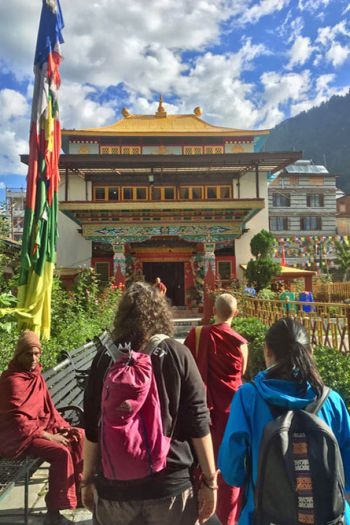
Manali, Kullu district, Himachal Pradesh, India, August 2019. Photo courtesy of Tushita Meditation Centre.
Through the Bardos
At 10 P.M. on August 18, nineteen of Tushita’s staff and volunteers loaded up into a bus and two additional vehicles to begin our long overnight drive to our first waypoint: Manali. Ginger tablets and Dramamine were washed down, strategically timed, along with prayers for effectiveness by those pilgrims susceptible to the destabilizing effect of the twists and turns promised by the road ahead. The hours of winding roads lived up to their reputation as a few meals reversed course, never completing their digestion, and others barely held on.
In the early still-dark hours of the next morning, just outside of Manali, we came to a halt. We were faced with a two-lane road that had crumbled to less than one, washed away by the heavy rains into the river below. Vinod, Tushita’s trusted driver who manned one of the vehicles, assessed the situation, uncertain if we could make it across. With a nagging feeling telling him “no” he reluctantly backed off, allowing the car that had come up behind us to make their choice.
As this new vehicle asserted its confidence in forging ahead, we all felt a wave of both relief and empathy as the car became stuck precisely where Vinod had a bad feeling. Reversing and attempting two hour-long detours before finally finding an alternate way through, all three Tushita cars reconvened in the light of a new day in Manali.
Before we could continue our ascent, we were required to obtain permits to go through Rohtang Pass, a high mountain pass at an elevation of 3,978 meters (13,050 feet), connecting the mostly Hindu Kullu valley below with the predominantly Buddhist Lahaul and Spiti high-altitude valleys above. With a history of dangerous conditions, Rohtang Pass literally translates to “corpse field.” Fortunately, most of the pilgrims were ignorant of that specific charming detail, and when our permit was denied that day due to landslides, we happily embraced a day to explore Manali.
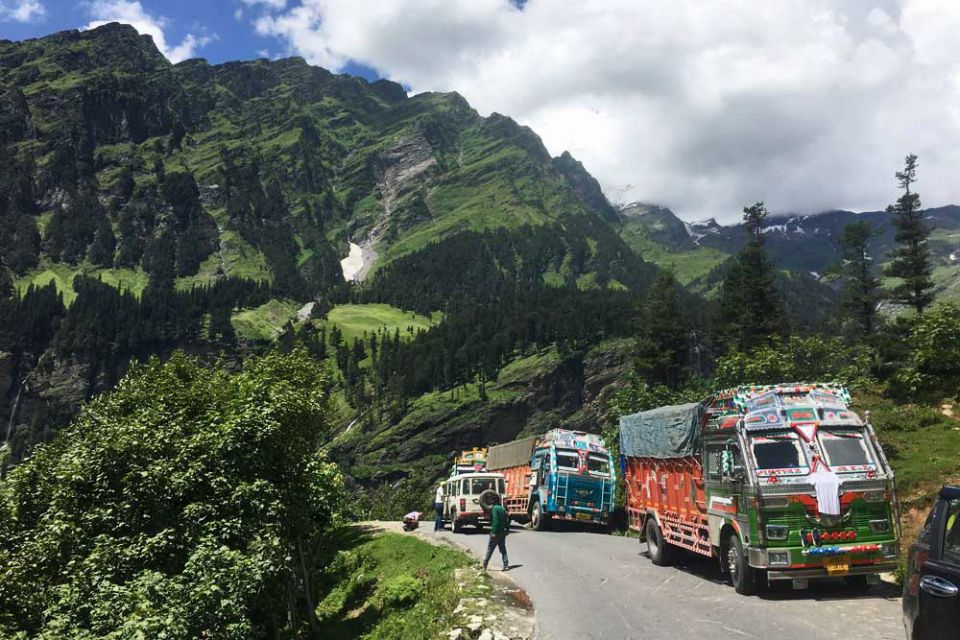
On the road from Manali to Rohtang Pass, Kullu district, Himachal Pradesh, India, August 2019. Photo courtesy of Tushita Meditation Centre.
With a good night’s sleep in comfortable hotel beds, breakfast in our bellies, and permits in hand, we piled back into the cars on August 20 to continue towards Rohtang Pass and beyond.
Now we were moving! Up and up we climbed, the air getting cleaner and thinner, and the mountains surrounding us becoming more majestic. With each turn of the road the views became more spectacular. Waterfalls decorated the green soaring mountains covered in a multitude of wildflowers.
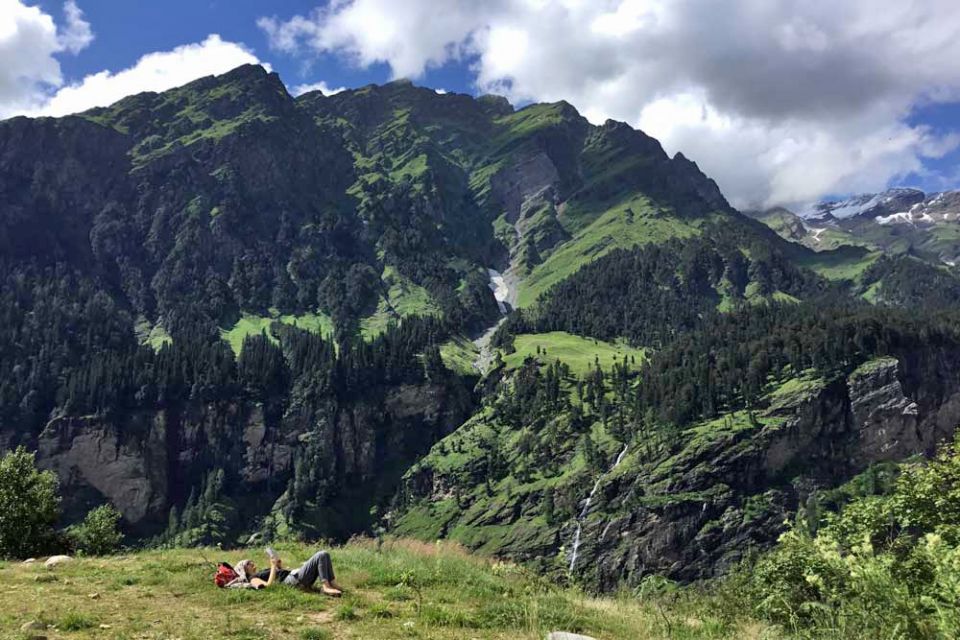
Outside of Manali on the way to Rohtang Pass, Kullu district, Himachal Pradesh, India, August 2019. Photo courtesy of Tushita Meditation Centre.
We turned a corner at 3,000 meters (10,000 feet) and hit the breaks. A long line of vehicles were at rest. Close inspection revealed that our predecessors had already been here for quite some time, stopped by a landslide far ahead. Our progress was halted!
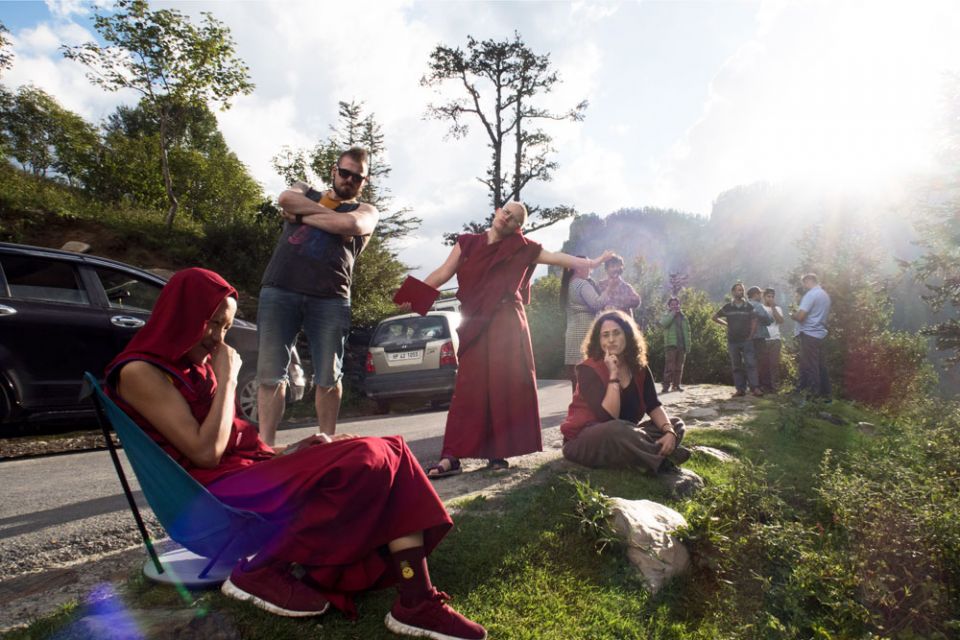
Progress halted on the road between Manali and Rohtang Pass, Kullu district, Himachal Pradesh, India, August 2019. Photo courtesy of Tushita Meditation Centre.
Camping on the alpine mountainside was not on the itinerary, yet I think we all embraced it as a marvelous gift. The sun shone (particularly precious after the monsoon we left behind), the view (again) was spectacular, and some astute entrepreneurs threw up tents and started selling chai, instant noodles, and omelets for the stranded hungry masses. All our needs were met!
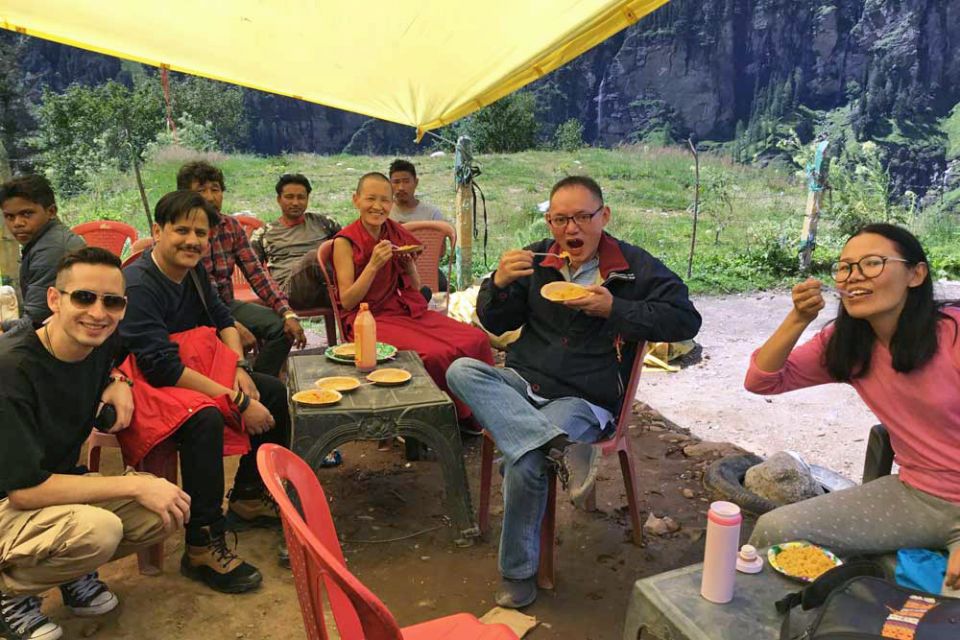
Chai, instant noodles, and omelets outside of Manali on the way towards Rohtang Pass, Kullu district, Himachal Pradesh, India, August 2019. Photo courtesy of Tushita Meditation Centre.
As the sweetness of the day began to fade with the setting sun and the chai shops disappeared just as they had miraculous appeared earlier, engines started and wheels began to roll. We were off again!
We climbed another 305 meters (1,000 feet) and passed through a dhaba [roadside restaurant] shanty town called Marhi. Its dhabas promised warm dinner with an indulgent array of options that extended beyond two items, but no, we were going to push on! Cover ground! Get. Through. That. Pass!
Onward we went, now in the darkness. Climbing, climbing, following the train of cars. As we were busy calculating what time we would now arrive at our next waypoint, we came to a temporary stop … which gradually revealed itself to be a temporary stop of the longer nature. Just as quickly as the wind of movement had filled our sails, it dropped out, and we were again sitting totally still on the mountainside. Another landslide.
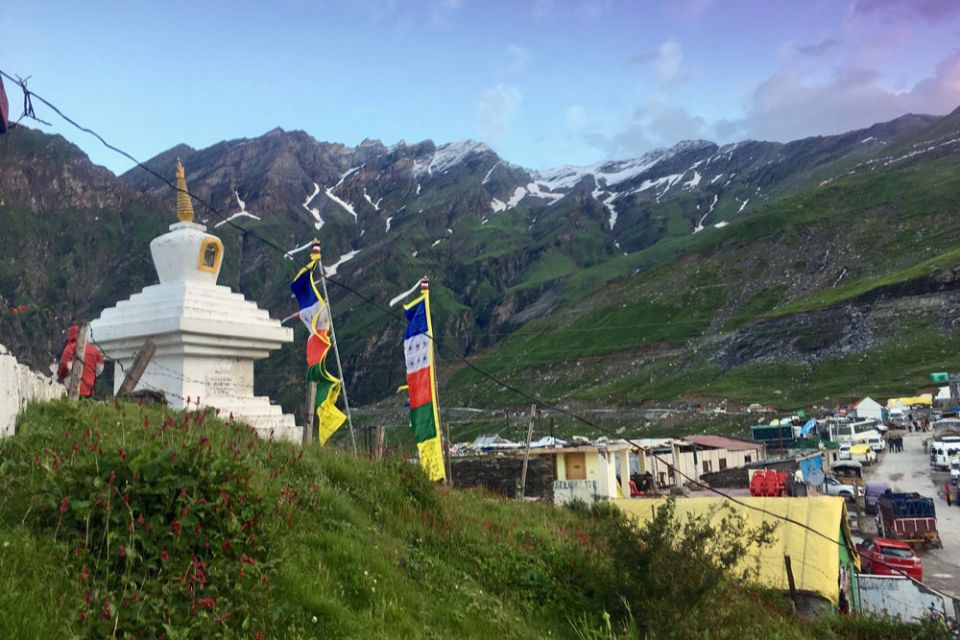
Marhi, Kullu district, Himachal Pradesh, India, August 2019. Photo courtesy of Tushita Meditation Centre.
Somewhat crestfallen, we surveyed the situation and decided to head back down the hill to Marhi where we could enjoy a late dinner and hopefully find some rooms to rent. The food renewed our spirits and bellies, and helped the news of “no rooms available” land a little softer. We all spent a night in a variety of contortions, with varying temperature regulation success in our respective vehicles. Those on the Tushita bus surely purified the most karma that night.
The morning of August 21 we reverse Tetris-ed ourselves out of our vehicles to see the snow-topped mountains that held us in their midst. At 3,360 meters (11,020 feet), we were fortunate for this extra time to acclimate our bodies to the lower oxygen levels, and some of us capitalized on this by hiking around to see more of the beautiful scenery and stimulate red blood cell production.
When the unmoving line of cars on the mountainside above finally began to move just before lunchtime, we jumped into the cars and sped up the hill to join the queue. We passed the point we had stopped at the night before and felt the satisfaction of gaining ground before turning the bend and finding ourselves stopped once again. The culprit? You guessed it. Another landslide.
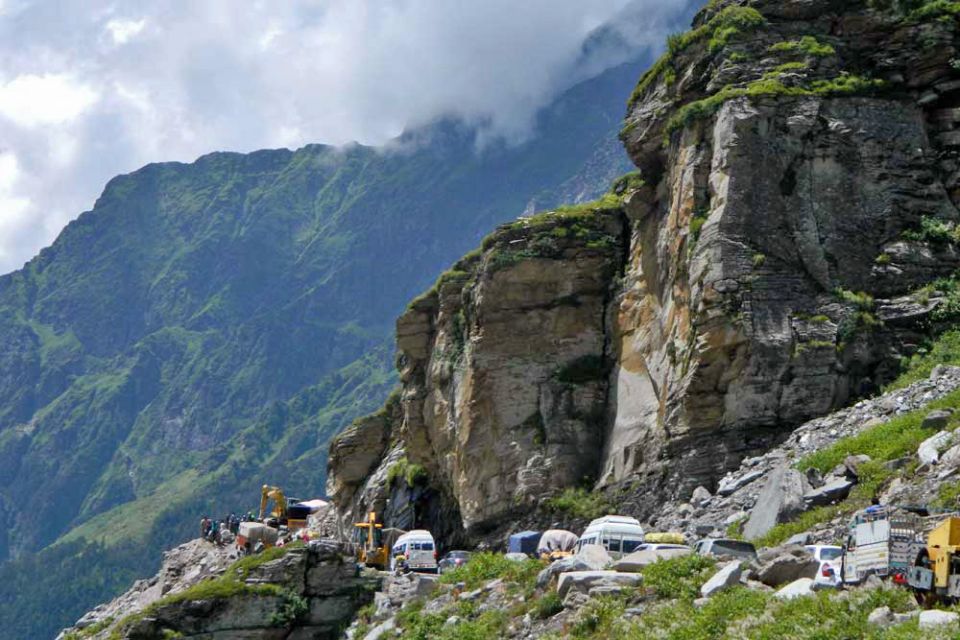
Traffic between Marhi and Rohtang Pass, Kullu district, Himachal Pradesh, India, August 2019. Photo courtesy of Tushita Meditation Centre.
We found ourselves in a bardo state: having left but not yet having arrived. Just as we were in an in-between we realized the mountain itself was in its own bardo state—transitioning, changing, becoming something new—no longer the mountain it was, but not yet settled into the mountain it would become. We had no option but to honor the mountain’s process and use the time to honor our own.
Making the most of our bardo experience, we spent another day perched on the mountainside sharing snacks and soaking up the expansive views and warm rays of the sun. This time we weren’t far behind the slide. As the road looped back on the mountain above us we could see where the disruption had occurred; an enormous boulder obstructed the road.
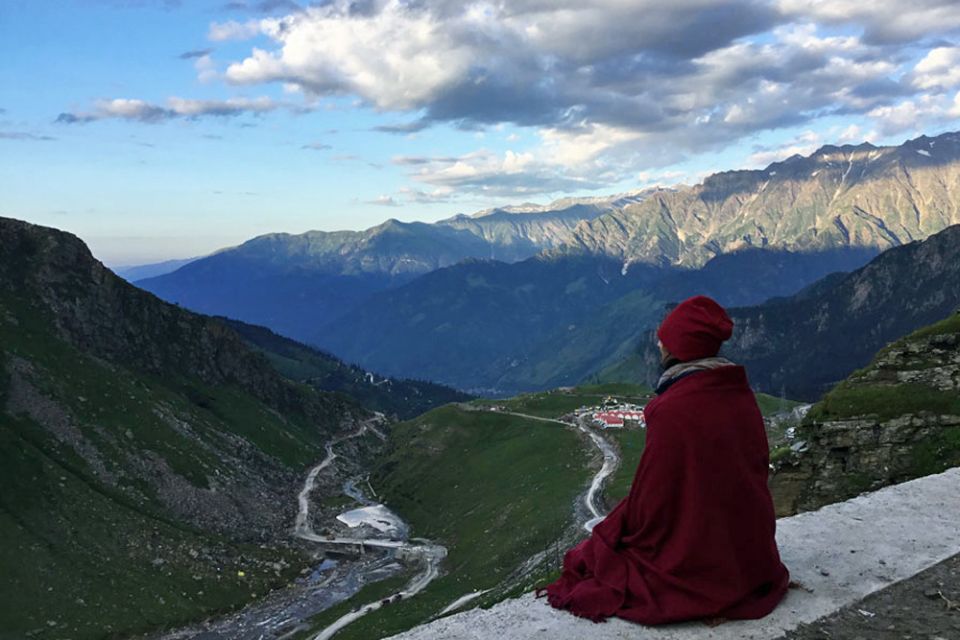
Taking in the view between Marhi and Rohtang Pass, Kullu district, Himachal Pradesh, India, August 2019. Photo courtesy of Tushita Meditation Centre.
Eventually we heard the startling boom of dynamite, and some time later we began to see the trucks that had been halted on their way down resume their journey through a one-lane pass that had been created. For well-over an hour these trucks rumbled past us in a seemingly unending stream as we awaited our turn with varying appearances of patience.
At some point, the unseen decision-maker deemed it was time to switch directions and allow those of us going up the mountain to have a turn. We were ecstatic! Engines started, gears were engaged, and we rolled forward the length of five cars before stopping again. What’s going on? Why aren’t we moving anymore? Say it with me now: “landslide.”
This continued in stops and starts until we made our way just behind the thwarting segment of road as darkness took hold. All movement halted. It was too dangerous to proceed. We would not get through that night. The promise of a real bed and warm meal dissolved as we realized we had no option but to sleep (once again) in our vehicles. Turning back to Marhi was not an option either.
It was at this point that a few stalwart pilgrims felt they could not continue. Four took their bags and headed back down the mountain on foot to catch buses back to Manali and then home. Other brave (and fit) members hiked down to Marhi, loaded up on fresh paranthas, and selflessly hiked back up the mountain in the darkness. Dinner arrived near midnight to our exhausted and hungry group trying to find a more comfortable arrangement of body parts for another night of car sleeping.
With the dawn came the tractor operators and renewed energy. Before too long, hardly trusting the reality of it, we drove through the troublesome tract and made our way finally up to Rohtang Pass on August 22.
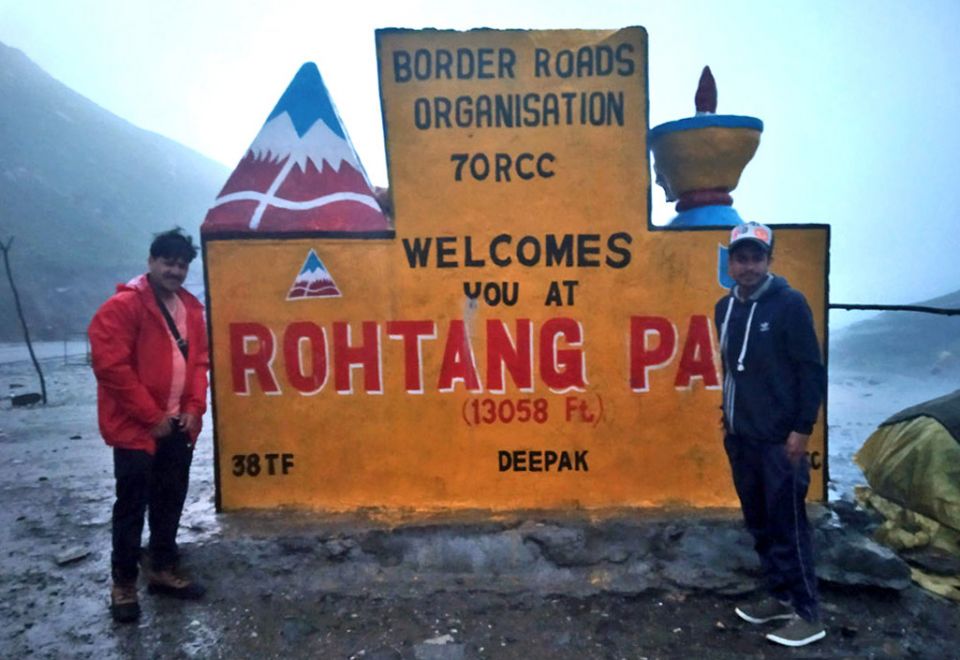
Rohtang Pass, connecting Kullu and Lahaul Spiti districts, Himachal Pradesh, August 2019. Photo courtesy of Tushita Meditation Centre.
After crossing Rohtang Pass and stopping to share our epic triumph with the local yaks and enjoy some snow, we went down, down, down the winding road into Lahaul Valley. Following the Chandra River, near the village of Sissu, we could see on the opposite side of the river the impressive Palden Lhamo waterfall, which is said to be a self-arisen manifestation of the Dharma protectress.
Not long after, another grand view greeted us: Sangam, a natural triangle that forms where the Chandra and Bhagra Rivers meet and become the Chandrabhaga (Chenab) River. The rivers Chandra and Bhaga first branch from the two sides of the Baralacha high mountain pass, then flow in opposite directions forming a circle, before finally meeting here again. This confluence is regarded as a holy place for Buddhists and Hindus alike.
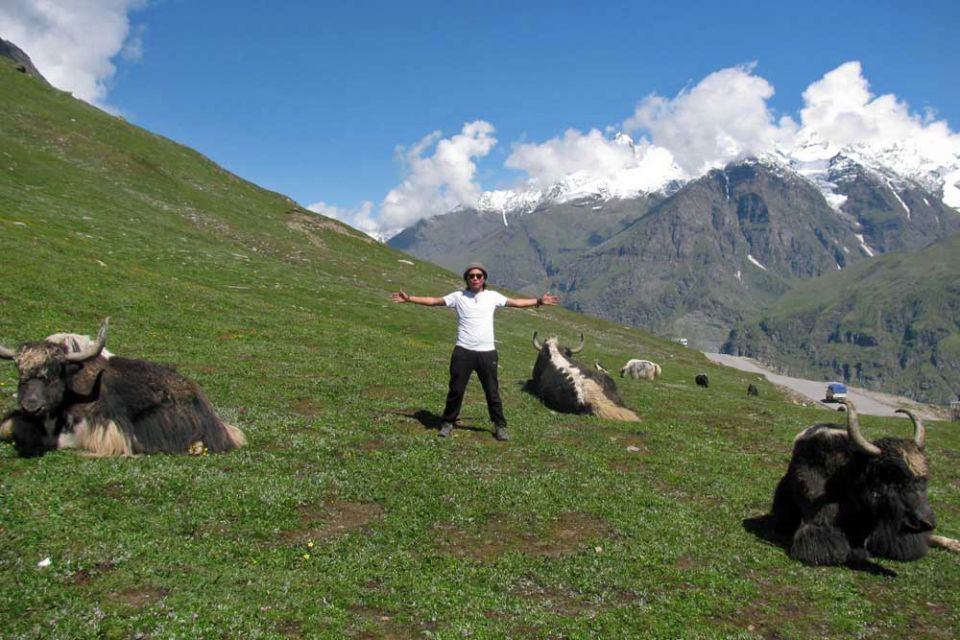
Celebrating with yaks on the opposite side of Rohtang Pass, Lahaul Spiti district, Himachal Pradesh, India, August 2019. Photo courtesy of Tushita Meditation Centre.
We were now standing right at the foot of Drilbu Ri, or Heruka Mountain, our first pilgrimage destination. But before starting the climb the next morning, we were yearning to spend the night not in our car or bus, but in real beds again! Finding a hotel in Keylong, a small administrative town at the base of the mountain, we collapsed on our beds. We delighted in the sweetness of bathing, and rediscovered the alternate clothing items we vaguely remembered packing days earlier.
Drilbu Ri Mountain: The Palace of the Buddha’s Enlightened Body
Early on August 23, we headed to the sacred Drilbu Ri, the Mountain of Spontaneous Union, associated with Chakrasamvara. Traditionally said to be “the Palace of the Buddha’s Enlightened Body,” many realized practitioners have come here to meditate and receive its powerful blessings. These practitioners include the great master Nagarjuna and the legendary Mahasiddha Ghantapa.
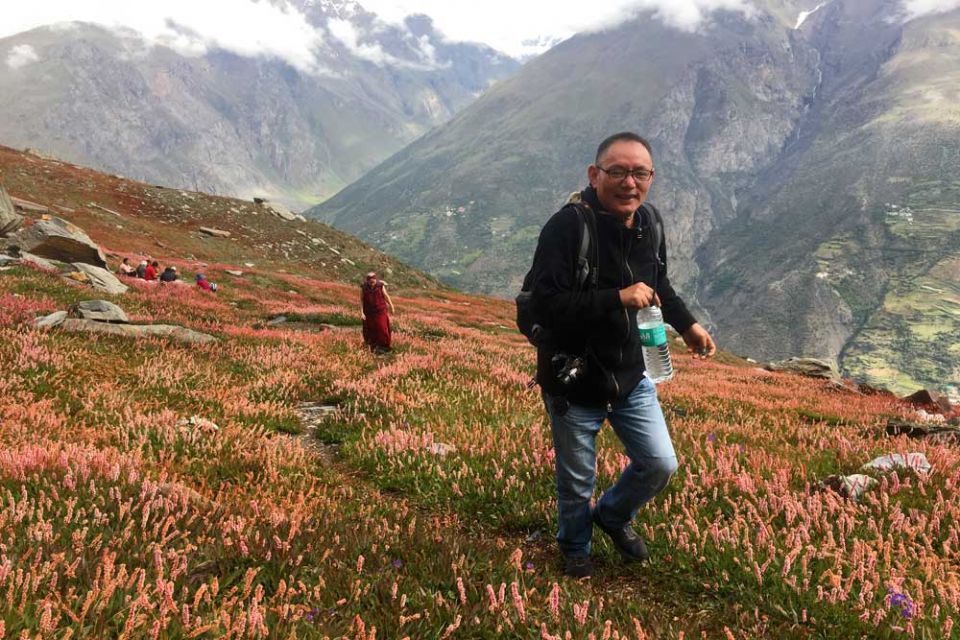
Drilbu Ri, Lahaul Spiti district, Himachal Pradesh, India, August 2019. Photo courtesy of Tushita Meditation Centre.
Starting near Kardang Gompa, we passed through fields of medicinal pink and red flowers as we climbed ever higher in the thin air, working our way with much effort toward the peak. Under the cover of the misty morning, the fifteen of us (along with a group of Spanish pilgrims led by our former co-director Kiko Llopis) began our slow but steady circumambulation (or kora) of the sacred mountain, basking in its purifying and wish-fulfilling vibrations.
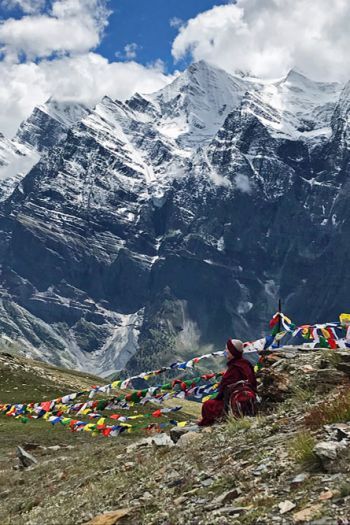
Drilbu Ri, Lahaul Spiti district, Himachal Pradesh, India, August 2019. Photo courtesy of Tushita Meditation Centre.
One could easily imagine the times when villagers, as mentioned in pilgrimage guide book Garsha, Heart Land of Dakinis, would regularly tell of hearing “music emanating miraculously from the mountainside, as if divine beings were engaging in sacred rituals.”
After five hours we reached the summit at 4,420 meters (14,500 feet), exhausted and happy, following in the footsteps of many great modern masters such as His Holiness the Dalai Lama, His Holiness the Sakya Trizin, and His Holiness the Gyalwang Drukpa. We offered incense, prayer flags, and prayers from our heart, said to definitely be fulfilled in such a powerful place as this.
We completed our kora with the inevitable descent, testing the vitality of our knees while feeling deeply satisfied. One could almost imagine the sky around us filled with dakinis offering their blessings. We felt that deep purification had surely taken place in making pilgrimage and kora at such a holy mountain, described by His Holiness the Gyalwang Drukpa as having three times the merit as a kora of Mount Kailash in Tibet!
A good night’s sleep in Keylong helped restore our bodies after climbing the equivalent of 255 flights of stairs. Refreshed, we were ready to continue to our next destination: Phakpa, the Unequalled Abode of Compassion, in Triloknath.
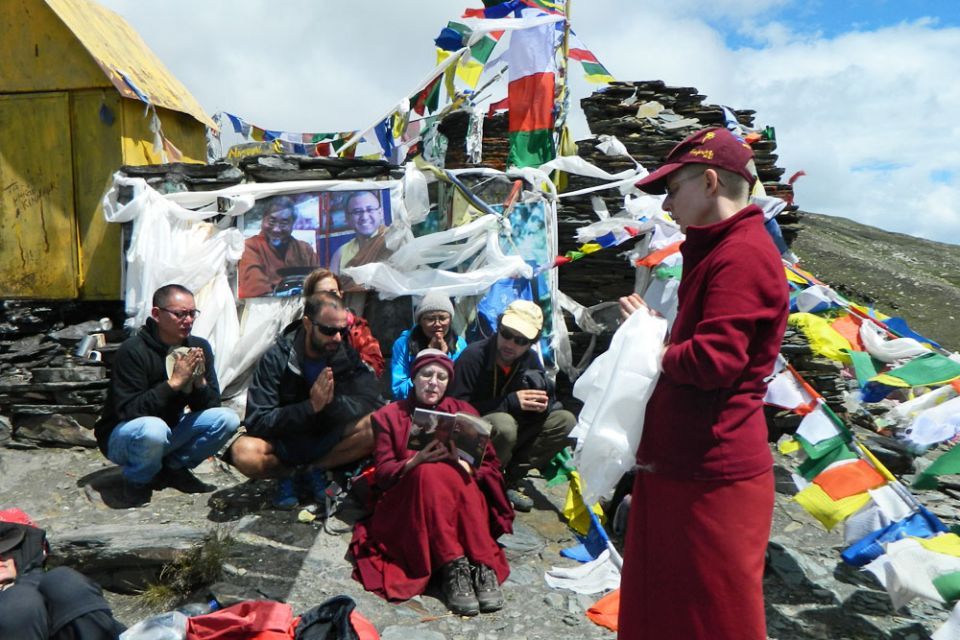
Drilbu Ri, Lahaul Spiti district, Himachal Pradesh, India, August 2019. Photo courtesy of Tushita Meditation Centre.
However, first we had to overcome a few more obstacles. Due to the landslides there was no gasoline available for our vehicles and the only public bus was hopelessly full to the brim. But as we know, the more hardships on a pilgrimage, the more merit! Somehow, we overcame the challenges of the morning and could finally continue on.
Phakpa Temple: The Palace of the Buddha’s Enlightened Speech
Triloknath is a tiny village in the Chandrabhaga valley. Archaic structures with low ceilings and full of character line the two brief paths that make up the town. One easily feels transported to another century. Locals say the relatively large building in the center, the former residence of the local king, is 1,000 years old. The original settlement is thought to have been founded by Nagarjuna himself. Archaeological evidence suggests Buddhism has been flourishing here since the second century C.E.
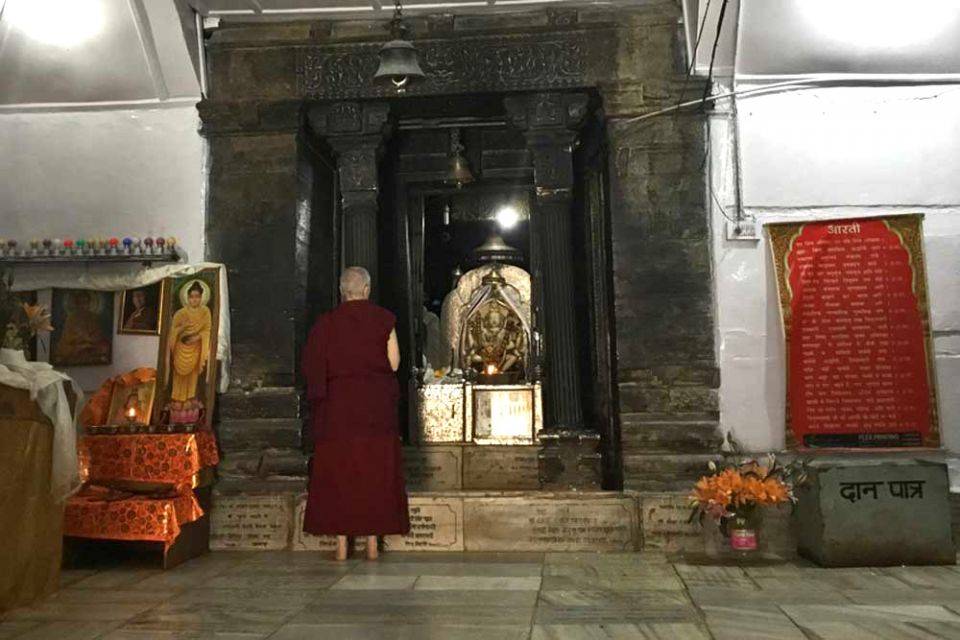
Phakpa Temple, Triloknath, Lahaul Spiti district, Himachal Pradesh, India, August 2019. Photo courtesy of Tushita Meditation Centre.
We now headed to the Phakpa Temple, which is dedicated to Chenrezig. The temple was built in the late ninth or early tenth century C.E. after the miraculous appearance of a white marble statute of Chenrezig with Amitabha Buddha at his crown.
Lama Zopa Rinpoche explained the importance of Phakpa and this Chenrezig statue to Ven. Sarah Thresher and others. Read Rinpoche’s explanation in Continuous Light Offered to Chenrezig.
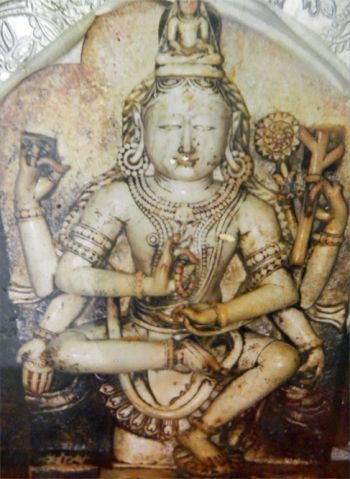
Phakpa Chenrezig in the Phakpa Temple, Triloknath, Lahaul Spiti district, Himachal Pradesh, India, August 2019. Photo courtesy of Tushita Meditation Centre.
The statue is believed to be imbued with extraordinary blessings, renowned for miraculously seeping nectar in the late 1930s and again in 1964. It is also known for its power of fertility, for which pilgrims come from afar. As we gathered in the cool refuge of this ancient temple, making offerings and heartfelt prayers, the power of this place resonated deeply. One felt that prayers made here with sincere motivation, devotion, and universal compassion had unmistakable power. How fortunate we were to receive such active and vibrant blessings from Phakpa Chenrezig! It is no wonder it is known as the Unequalled Abode of Compassion!
Walking around the tiny village and the temple, we could still see and feel the blessings of Lama Zopa Rinpoche from his visit in 2013. Villagers greeted our driver, Vinod, like an old friend. They showed us were Rinpoche, together with Tsenshap Serkong Rinpoche and Khadro-la, had stayed back then in a private retreat. When we visited the temple we saw Chenrezig praises written by Rinpoche, framed and hung up in Tibetan, Hindi, and English. These brought up memories of long days spent translating and framing the praises, and several trips to have them hung up by the temple management.
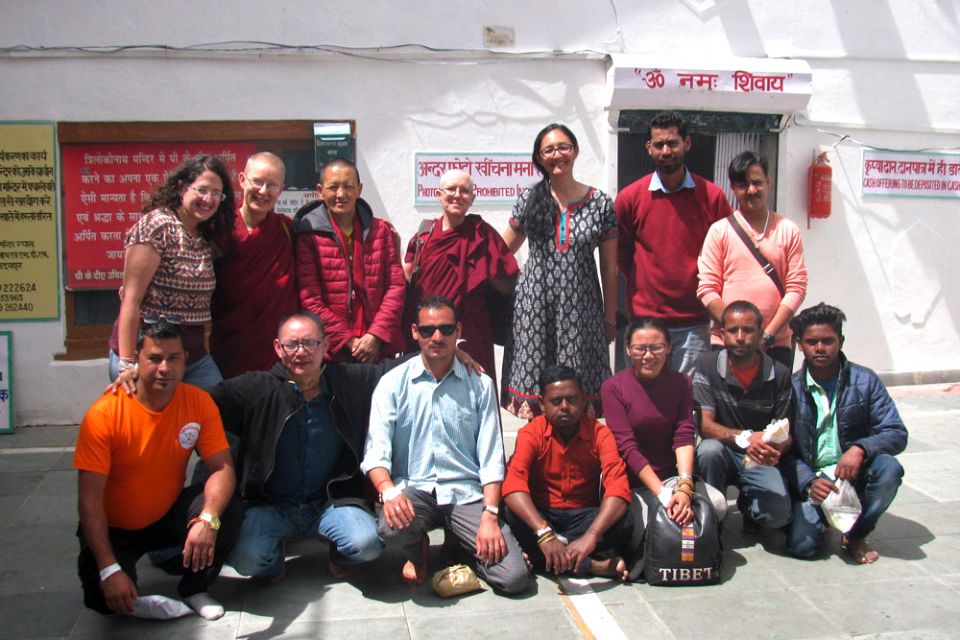
Triloknath, Lahaul Spiti district, Himachal Pradesh, India, August 2019. Photo courtesy of Tushita Meditation Centre.
Visitors entering the village of Triloknath are greeted by a golden rock covered in mantras painted by Lama Zopa Rinpoche.
We would have loved to have stayed in Triloknath longer and visited Omay Tso (the Milky Chenrezig Lake), a challenging but very rewarding day trip into the mountains. The white water from the lake is said to be blessed and can be enjoyed in many places around the area and the temple. However, this time we had to hurry on.
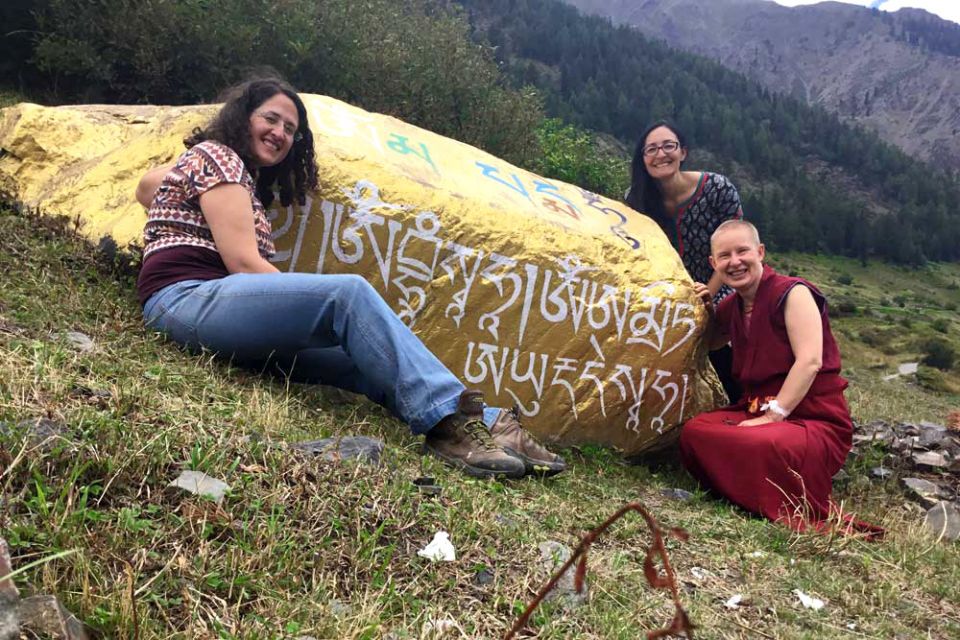
Amitayus mantra-covered rock painted by Lama Zopa Rinpoche, Triloknath, Lahaul Spiti district, Himachal Pradesh, India, August 2019. Photo courtesy of Tushita Meditation Centre.
Markula Temple: The Palace of the Buddha’s Enlightened Mind
Continuing on, we drove to Udaipur, in ancient times called Maru/Markula/Margul. Markula Temple, the “Great Tantric Site of the Underground Dakinis,” is in Udaipur. This is one of the twenty-four abodes of dakinis in our world as described in many tantras. Each abode is associated with a part of the human body. They are places of divine power, profound blessings for pilgrims, and swift enlightenment for yogis. Markula is connected to the big toes of the Vajra Kaya. This is the realm of the Underground Dakinis presided over by Vajrayogini.
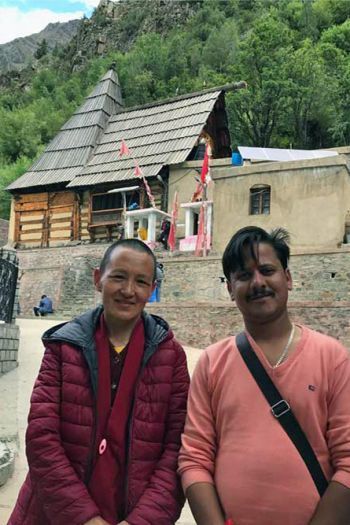
Markula Temple, Udaipur, Lahaul Spiti district, Himachal Pradesh, India, August 2019. Photo courtesy of Tushita Meditation Centre.
To our great disappointment the “cable-way” over the river, which we had so much enjoyed and feared from our previous visit in 2015, had been replace by a solid bridge. Passing the dakini footprint embedded in solid rock and the “heavy stone” of the Buddha’s toe outside, we entered the ancient shrine, allowing our eyes to adjust to the darkness of the room.
The temple is carved from darkened wood, the air filled with incense. We knelt, making heart-felt prayers, encouraged by Naropa’s message that this place, like the other twenty-three power places, is one of particular support to the liberation of spiritually immature practitioners such as ourselves. The pilgrimage guide book Garsha, Heart Land of Dakinis mentions that by visiting these sites and worshiping properly, practitioners can have their “unhappiness, delusions, and obstacles … supremely dispelled.”
Following in the footsteps of several of the eighty-four Indian mahasiddas who meditated here in the eighth to eleventh centuries C.E. and countless advance tantric practitioners who followed them, we made our offerings and prayers. This was a particularly auspicious time to invoke the protection and blessings of Tara and other feminine Buddhas inseparable from Vajrayogini, and we did our best before the temple steward made clear he wanted us to leave! Some of us finished our prayers on the bench outside, hoping to have our subtle energies blessed by the countless dakas and dakinis in residence here.
Filled to the brim and beyond with blessings, we happily piled back into the vehicles to begin our journey back to Manali. This time, all the obstacles were removed. We made it up and over Rohtang Pass with only the slightest delay to quickly clear rocks out of the road in the rain. We slept at a hotel in Manali that night, with one final destination awaiting us the following day.
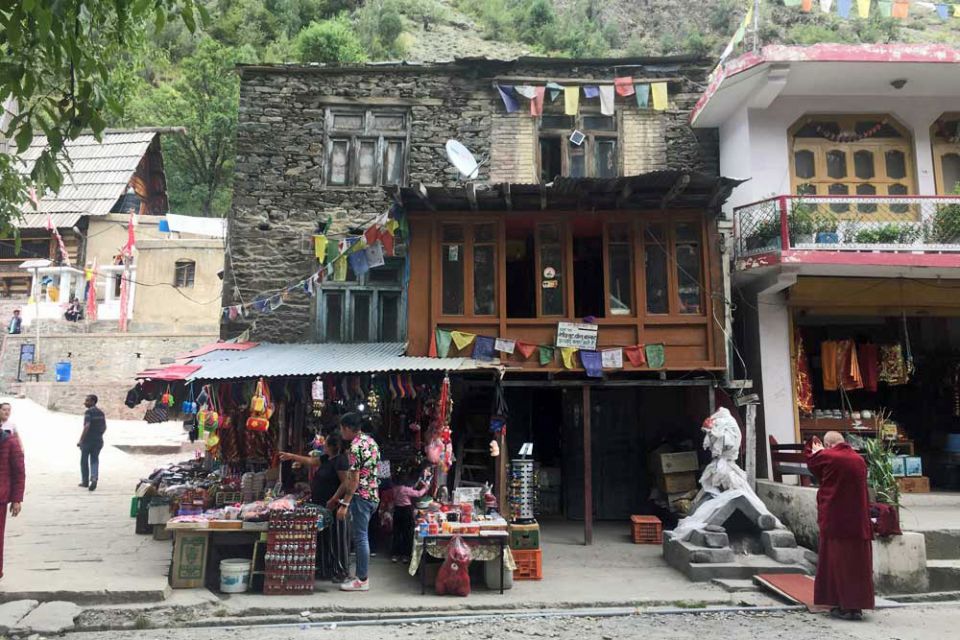
Markula Temple is on the far left, Udaipur, Lahaul Spiti district, Himachal Pradesh, India, August 2019. Photo courtesy of Tushita Meditation Centre.
Tso Pema
On August 25, we made one final stop on our return trip home. About a five-hour drive from Tushita, in Mandi district, Tso Pema is a small mountain town centered around Rewalsar Lake. It is famous for being the place where Padmasambhava spent months in a cave practicing long life practices with the royal princess. The king, angered by this, tied the two of them to a funeral pyre and set them ablaze. But rather than being burned, Padmasambhava miraculously transformed the fire into a lake in which he was found sitting atop a lotus in the center with the princess, unharmed.
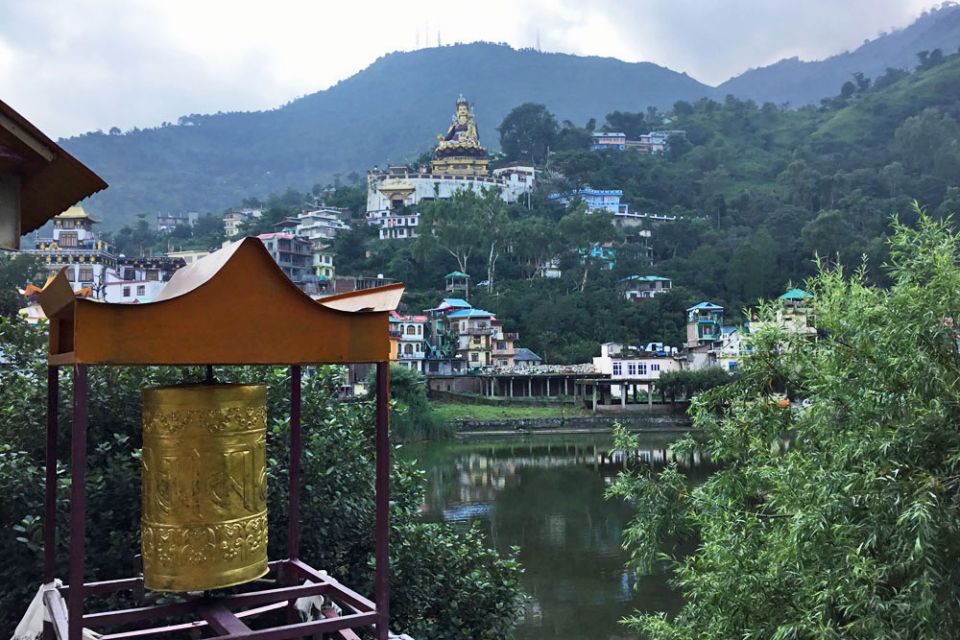
Tso Pema, Mandi district, Himachal Pradesh, India, August 2019. Photo courtesy of Tushita Meditation Centre.
Today, pilgrims circumambulate Rewalsar Lake beneath an enormous statue of Padmasambhava and visit the caves in which he meditated. We gathered in the main cave, where we made a special tsog offering and prayers. It was a joyful culmination of our incredible journey together.
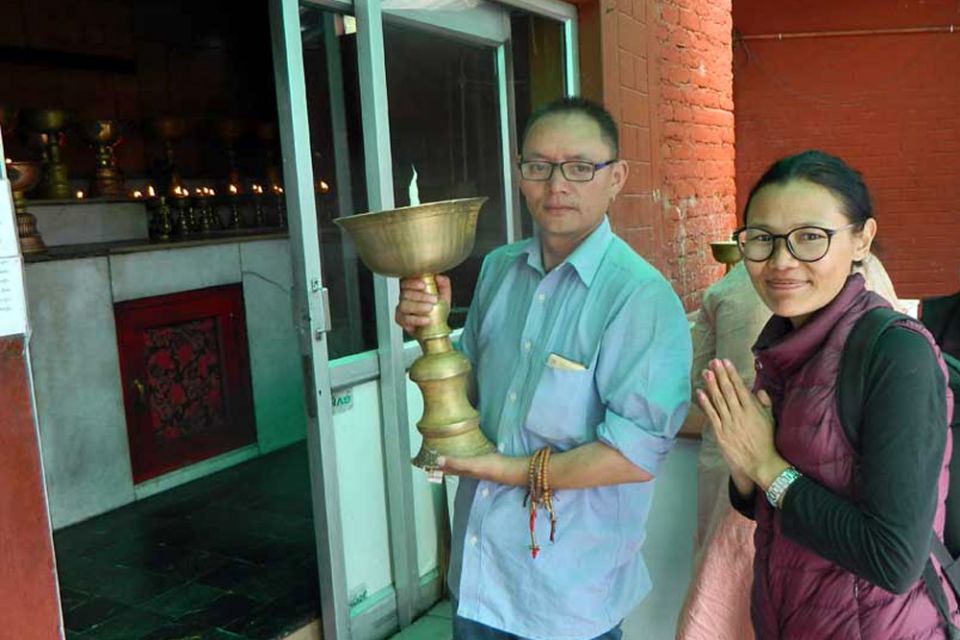
Tso Pema, Mandi district, Himachal Pradesh, India, August 2019. Photo courtesy of Tushita Meditation Centre.
We are deeply deeply grateful to all who made it possible for us to take this profound pilgrimage together. We dedicate all the merit we received that the Dharma wishes of our teachers, such as His Holiness the Dalai Lama and Lama Zopa Rinpoche, may succeed immediately, and that we may fully develop our positive qualities to be of greatest benefit to all beings in this and all future lives.
First published on Tushita Meditation Centre’s website: http://tushita.info/news/pilgrimage2019/
Written by Tushita Meditation Centre staff and referring to Garsha, Heart Land of Dakinis published by Garsha Young Drukpa Association, Keylong, 2011.
In 2014, Lama Zopa Rinpoche wrote a letter to an international Buddhist organization concerning care of the Chenrezig statue in the Phakpa Temple in Triloknath, published on the Lama Yeshe Wisdom Archive website: https://www.lamayeshe.com/advice/care-chenrezig-statue-garsha-india
For more information about Tushita Meditation Centre, visit their website:
http://tushita.info/
- Tagged: drilbu ri, francisco llopis, in-depth stories, khandro kunga bhuma, lahaul spiti, lama zopa rinpoche, manali, maria nobuko corrales, pema wangmo, pilgrimage, rohtang pass, serkong tsenshab rinpoche, triloknath, tso pema, tushita meditation centre, udaipur, ven. sarah thresher, ven. tenzin drolma, ven. tenzin kunphen
15
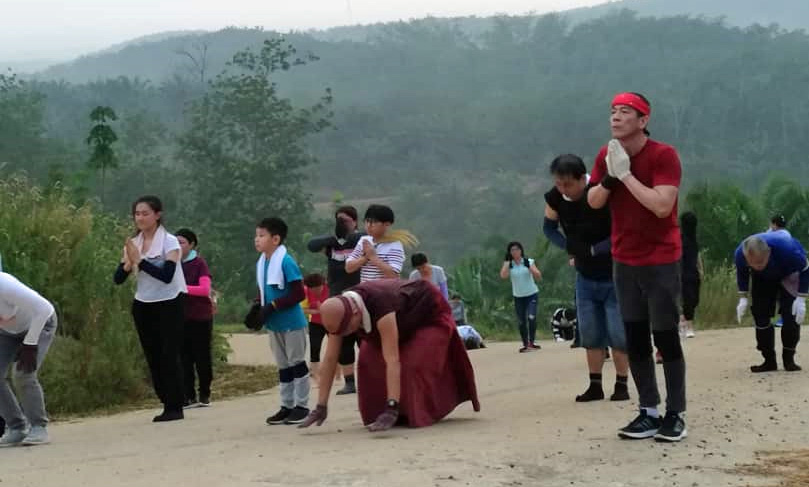
Prostrations at Rinchen Jangsem Ling Retreat Centre, Triang, Malaysia, August 2019. Photo courtesy of Rinchen Jangsem Ling Retreat Centre.
On August 25, 2019, a large prostration event took place at Rinchen Jangsem Ling Retreat Centre, the FPMT center in Triang, Malaysia. FPMT Southeast Asia regional coordinator, Selina Foong, shares the story.
I’ve made countless trips to beautiful Rinchen Jangsem Ling over the years. On previous trips the highlight was the arrival, not the journey. We’d be in our car chatting away, typically heading to an executive committee meeting or a retreat. The scenery would zip by, familiar but fleeting. A recent trip, however, could not have been any more different!
A few months earlier I had been pleasantly shocked to learn that a tour group from out of town had visited Rinchen Jangsem Ling and decided to organize an impromptu prostration event. (Often large groups of friends and acquaintances will visit Rinchen Jangsem Ling in large tour buses.) For every three steps they took they would prostrate once. And not just over a short distance, but all the way from the bottom of the hill up to the Rinchen Jangsem Ling gompa!
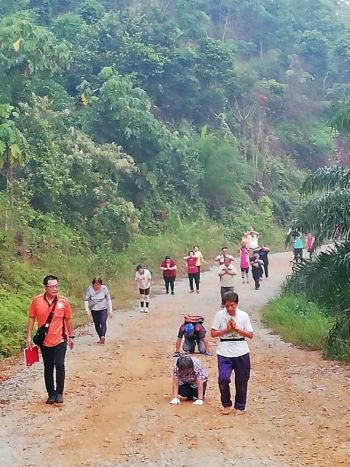
Prostrations at Rinchen Jangsem Ling Retreat Centre, Triang, Malaysia, August 2019. Photo courtesy of Rinchen Jangsem Ling Retreat Centre.
“Wow!” I marveled. That’s more than 1.2 kilometers (three quarters of a mile) on a variety of purification-inducing surfaces, including red dirt, sharp loose gravel, and knee-punishing concrete! Throw in regular whiffs (not to mention actual patches) of cow dung. Add in the relentless tropical heat and high humidity. And top it off with the fact that many of these visitors were new to Rinchen Jangsem Ling and had not done even one prostration before, let alone 1.2 kilometers worth!
Incredibly, this impromptu prostration event turned out to be a huge hit. So much so that there were immediate calls for a repeat event. “Yes!” I thought. ”Here comes my own chance to burn off eons and eons of negative karma!” After all, Lama Zopa Rinpoche has taught us time and again about the effectiveness of doing prostrations with body, speech, and mind. And the more atoms of our bodies that are in contact with the ground when we prostrate, the better. What’s more, the higher the location of our prostrations, the better that would be too. (All the more atoms below us!)
Keen to take Rinpoche’s advice to heart, I had to nonetheless concede that my chances of prostrating all the way up to Mount Everest were rather slim. I could indeed, however, try to prostrate all the way up to Rinchen Jangsem Ling! And that was how I found myself at the base of the Rinchen Jangsem Ling hill one Sunday morning, standing in pitch darkness among the trees with Oi Loon Lee and several hundred others. Already sweating and tingling with anticipation, we were at the back of the huge crowd but could easily hear Rinchen Jangsem Ling’s center director, Ven. Sonam Yeshe, who was at the front leading the motivation and prayers on a loudspeaker. It all felt quite surreal. Then very slowly everyone started moving forward and the prostrating began.
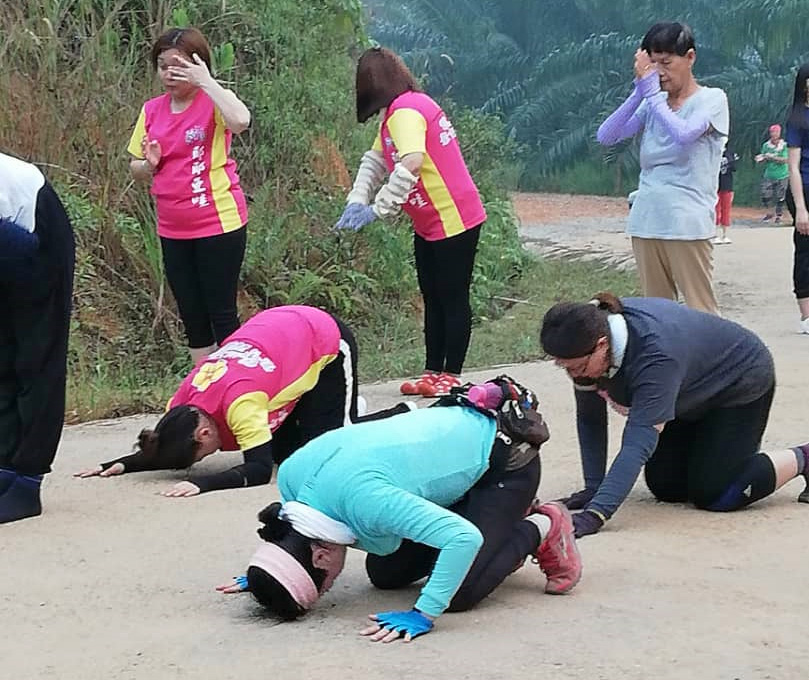
Prostrations at Rinchen Jangsem Ling Retreat Centre, Triang, Malaysia, August 2019. Photo courtesy of Rinchen Jangsem Ling Retreat Centre.
In my enthusiasm I had already decided to do full prostrations all the way in order to maximize my purification on this “little” outing. As you can probably guess “little” turned out to be a gross understatement. In fact, “MAMMOTH” came more to mind when my delight at what I thought were already numberless prostrations was quickly erased upon daybreak. I looked around at the familiar dirt roads. Huh?!?! I was not even halfway to Rinchen Jangsem Ling! Then I caught myself: silly me, since when was intense purification ever going to be a walk in the park, pardon the pun?
I decided to change tack: instead of fretting about how much further there was to go, I retreated inwards. What a rare and amazing opportunity this event truly was. Every second presented us all with another chance to amass much merit and purify negativities. What a gift; what a blessing!
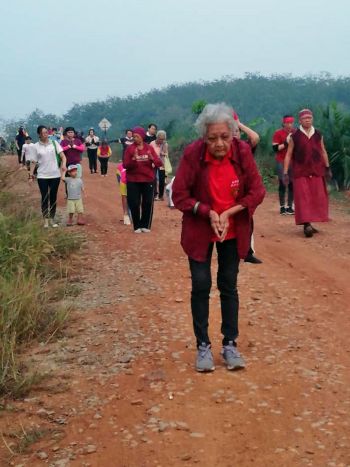
Prostrations at Rinchen Jangsem Ling Retreat Centre, Triang, Malaysia, August 2019. Photo courtesy of Rinchen Jangsem Ling Retreat Centre.
As time slowed down into fragments of moments my prostrations developed a gentle rhythm. I became aware of how the different parts of my body were feeling. (Or rather, how they were aching). I grew familiar with how the various terrains looked, felt, and smelled, and decided that concrete was the most challenging surface to prostrate on. (Red dirt and cow dung any day please!) I enjoyed the ever-so-gradual change in light—from pitch black to a subtle blue—which eventually mixed with the pink of sunrise. I felt the pull of Rinchen Jangsem Ling, its blessed energy looming ever closer.
All around me others were enveloped in their own thoughts, each traveling their own journeys. Some were walking, others were doing half-prostrations. A few, incredibly, were barefoot. Many elderly folk, some children, too. Thinking of all sentient beings, marveling at this precious opportunity, rejoicing for my fellow prostration mates, spilling with gratitude towards my holy gurus and dear Rinchen Jangsem Ling … many thoughts went through my head as my increasingly weary body hit the red dirt … then gravel … then concrete … then grass … then tiles, over and over and over again.
By the time I arrived at the top where I did my final prostration, the Rinchen Jangsem Ling gompa was already packed with participants and it was past 8:30 A.M. What a joy it was to complete this special event! (And what a relief, too!) It didn’t matter that I ended up a muddy mess, with bruises on my knees for weeks afterwards (despite wearing knee pads), and was so unrecognizable that none of my friends at Rinchen Jangsem Ling were very conversational at all. I only understood this when I looked in the mirror much later that morning … no wonder they had no idea who I was!
In any case, our gurus as well as all the buddhas and bodhisattvas must have been looking after us that morning. The weather remained cool and dry for almost the entire time. A very gentle rain started to fall just as the last of us were approaching Rinchen Jangsem Ling, lasting for an hour or so before clearing up again for the rest of the day. How wonderful it was, how wonderful it was!
For more information about Rinchen Jangsem Ling Center, visit their website:
http://www.jangsemling.com/
- Tagged: in-depth stories, oi loon lee, prostrations, rinchen jangsem ling, selina foong, ven. sonam yeshe
25
Nalanda Monastery’s New Project: Maitreya Pure Land
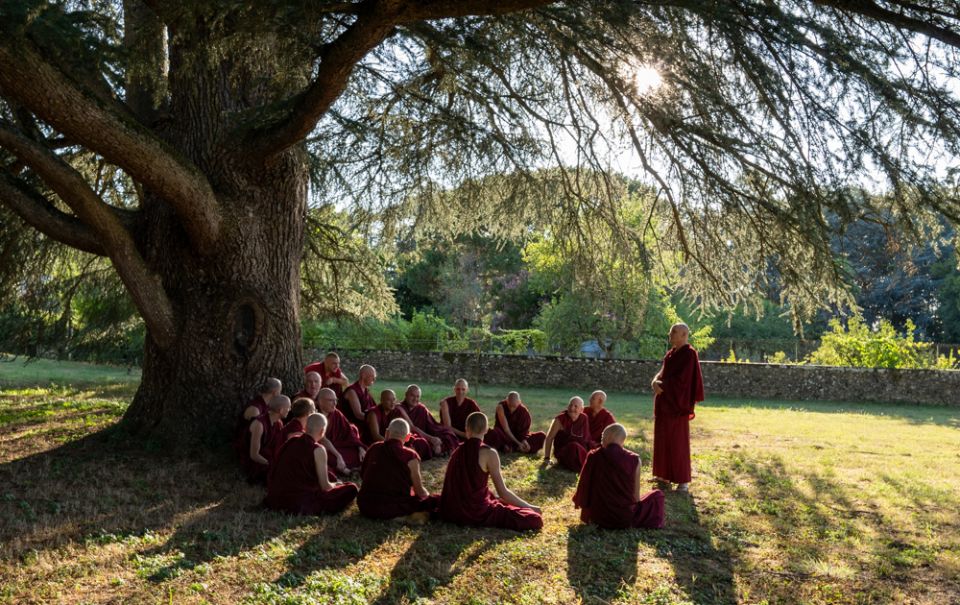
Nalanda Monastery monks on the property they are seeking to purchase to create Maitreya Pure Land, Lavaur, France, August 2019. Photo courtesy of Nalanda Monastery.
Nalanda Monastery is a community for Western Gelug monks located in a peaceful rural setting in the South of France about 25 miles (40 kilometers) from Toulouse. The monastery, which is affiliated with FPMT, offers monastic students, as well as lay students, a place for ongoing in-depth Buddhist study and practice. The monastery is excited to announce a new expansion project. Ven. Gyaltsen, Nalanda’s director, shares the story:
Nalanda Monastery has been offered the opportunity to purchase the neighboring property, called Gachepel. During his visit to the South of France in May 2019, Lama Zopa Rinpoche met and spoke with the owner of the property. Rinpoche took the opportunity to pray and bless the grounds. He gave the property a name—Maitreya Pure Land. Rinpoche then auspiciously made the first donation to our purchase fund.
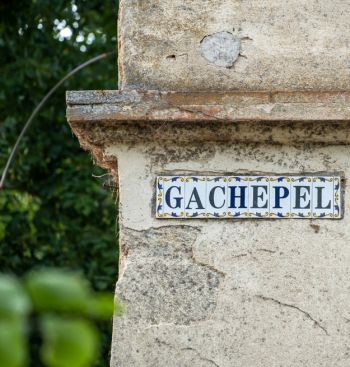
Detail from a building at Gachepel, the property neighboring Nalanda Monastery, Lavaur, France, August 2019. Photo courtesy of Nalanda Monastery.
In October 2018, the owner of the property informed us of his intention to sell. As a friend of Nalanda, he offered us the opportunity to purchase it, without putting it on the open market. The property has been a family home for approximately 200 years. Purchasing it is a rare opportunity and is full of potential for Nalanda. It would enable the monastery to expand and offer further services to both the monastic and lay communities and the wider FPMT family.
In early November 2018, we had a constructive meeting with the owner. Following that, we requested Lama Zopa Rinpoche to check the karmic potential of the property. Two weeks later we received an email informing us that Rinpoche had checked and advised that this property has the best (most beneficial) karmic relationship with Nalanda.
Coincidence or not, Rinpoche was scheduled to come to the South of France for the Vajrayogini retreat at the nearby Institut Vajra Yogini in May. During the retreat, he took the time to visit the property and to explain his vision for retreat huts to be built at Gachepel. He suggested that it would be an excellent place for Nalanda students and Buddhists from around the world, both monastics and lay people, to do semi-isolated lamrim retreats in order to realize the teachings.
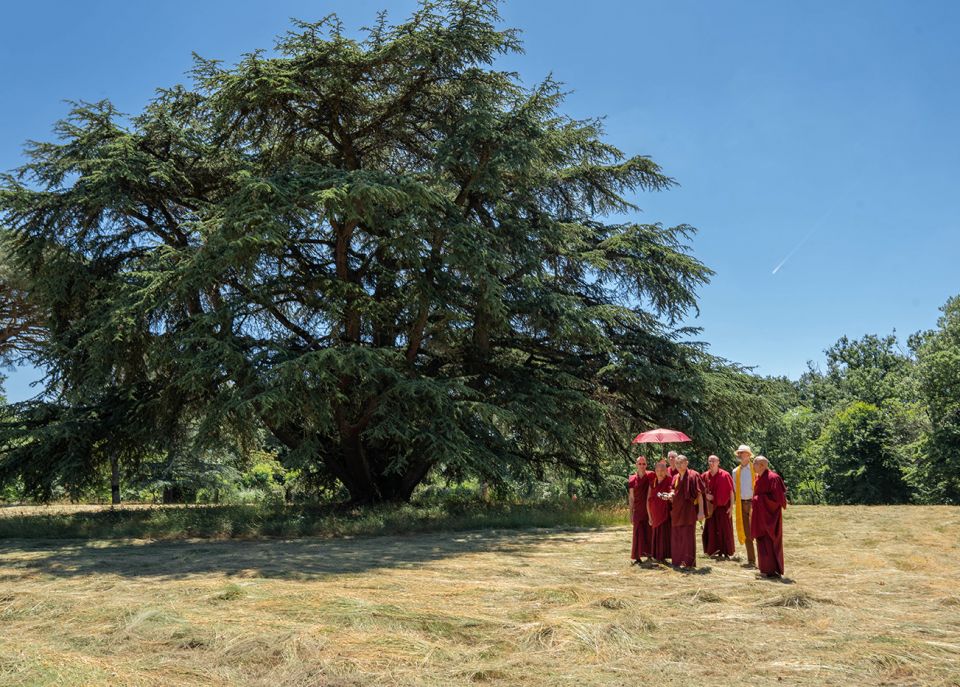
Lama Zopa Rinpoche visiting the property, Lavaur, France, May 2019. Photo courtesy of Nalanda Monastery.
“Monasteries and gompas where there are holy objects of the Buddha, Dharma, and Sangha—statues, stupas, and scriptures—are called ‘abiding places’—nä-khang in Tibetan,” Rinpoche said. “What is abiding is the Buddha, Dharma, and Sangha. So an ‘abiding place’ is a great, great place to subdue the mind, collect extensive merits, and achieve enlightenment. Even the name nä-khang is incredible.” In this way, Rinpoche emphasized, monastic communities benefit everyone, lay and ordained.
Ven. Gendun is one of the eldest monks at Nalanda in terms of seniority. He is a board member and has lived at Nalanda since 2000. “Some years ago we were attending a funeral for the mother of one of the volunteers in the church in Lavaur. After the service, we went up to meet the service leader, and he turned out to be our neighbor. He later attended the inauguration of our newest monks’ accommodation building in 2016, and we kept in touch after that. I was surprised when he said he was planning to sell his property. It seems that none of his children were interested in keeping it and maintaining it was costly and time consuming,” Ven. Gendun explained.
The property, adjacent to Nalanda, is quiet and encompasses 5.5 hectares (13.59 acres) of beautiful parkland and includes two large residences.
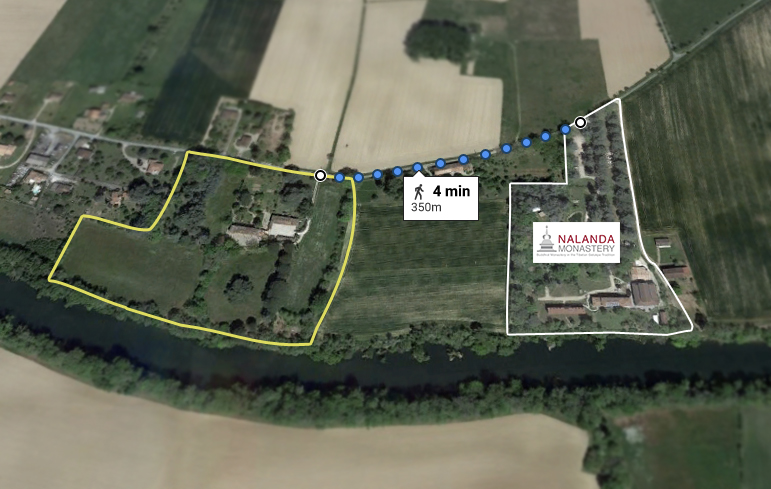
View of Nalanda Monastery and the neighboring property, Gachepel. Image courtesy of Nalanda Monastery.
German monk Ven. Tharchin has lived at Nalanda since 1999 with an interruption of three years when he joined FPMT’s Lotsawa Richen Zangpo Translator Program. He has served as a translator at Nalanda ever since and is also a board member.
“When I came to Nalanda, there were only about six monks living here in one building,” said Ven. Tharchin. “Ever since, there has been a continuous and very organic growth in the community and in the monastery’s Dharma activities. It is especially important to note that Nalanda has achieved an ever-increasing standard of studies of the vast Dharma scriptures. Although there was no formal study program when I joined Nalanda, Geshe Jamphel taught us Dharma for many years. As the community grew, the then director Ven. Tendar worked towards establishing a Basic Program at Nalanda. This was a great step forward for us and we didn‘t know if we were up to the task. It turned out, fortunately, that we were, and we are now running the third Basic Program in a row. The number of monks has steadily increased and many lay followers have joined the study program. Furthermore, we have embarked on our first Masters Program, which is still running.”
“The monastery now hosts these two major study programs, which are led by two geshes with two translators,” Ven. Tharchin explained. “Both programs are attended by monks, nuns, and lay students. I can say that the development of the study programs was a terrific initiative and the benefits coming out of these studies are huge. More and more monks are going out to other centers to share the Dharma they have learned here at Nalanda. All of this also has led to a growth in the facilities at Nalanda. When I joined, there was only an old manor house. We have added two new buildings, and all three buildings are now being fully used. Nalanda definitely needs more space so that it can continue to welcome more monks and to extend the range of Dharma activities it can offer.”
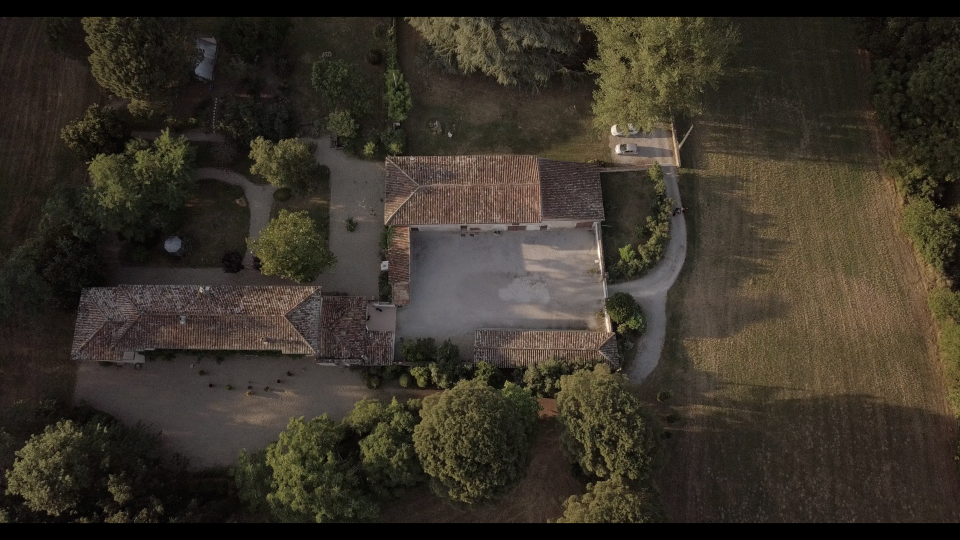
Aerial view of the buildings at Gachepel, which would house students doing lamrim retreat. Photo courtesy of Nalanda Monastery.
In “Benefits of Building Monasteries,” Lama Zopa Rinpoche said, “Many lineage lamas of the lamrim built monasteries. I understand that business people who are not Buddhist may not understand the benefits of building monasteries, but if you are saying it has no meaning to build a monastery, then all those lineage lamas, Buddha himself, the Kadampa masters, those who actualized the path, including Lama Tsongkhapa’s disciples, who established monasteries, made big mistakes.”
Nalanda Monastery has been doing the bi-monthly sojong ritual and the yearly yarne and gayay (rains retreats) since 2009. These rituals and retreats distinguish Nalanda from other Western Buddhist centers. Without them, Nalanda would not be able to call itself a monastery. The monks of Nalanda feel committed to preserving the essential vinaya tradition and organize annual vinaya teachings for the fully ordained monks.
Nalanda Monastery has an increasing potential to be instrumental in preserving the vinaya tradition in the West. All Nalanda monks participate in daily prayers and in the large pujas, such as the Tara puja, the Sixteen Arhats puja, and the Medicine Buddha puja. All these pujas are held weekly. Rinpoche would like some of our Nalanda monks to go to Kopan in 2020 to participate in the Monlam prayer festival, and he would like to see the prayers for the festival translated into English. Perhaps this is an indication that Rinpoche would like Nalanda to organize prayer festivals in the future? It would be another landmark for us.
“When we are studying, a monastery or nunnery offers us the opportunity to study with more supportive conditions and fewer obstacles. Mundane tasks like shopping, cooking, cleaning, and maintenance, etc., are shared by all, freeing up much time and mental space. By studying the Dharma in a large community, we are exposed to more well qualified teachers and students with a broad range of ideas and perspectives, deepening and enriching the quality of our learning. The greater our wisdom of hearing, the greater our wisdom of contemplation will become, and accordingly the greater will be our wisdom gained through meditation. Recognizing such benefits, monastic scholars of the past naturally formed major communities of study and practice, like Nalanda and Vikramashila in India, and the ‘Three Great Seats’ [Ganden Monastery, Sera Monastery, and Drepung Monastery] in Tibet.”
— from “The Benefits of Monasteries and Nunneries,” by Ven. Tenzin Legtsok
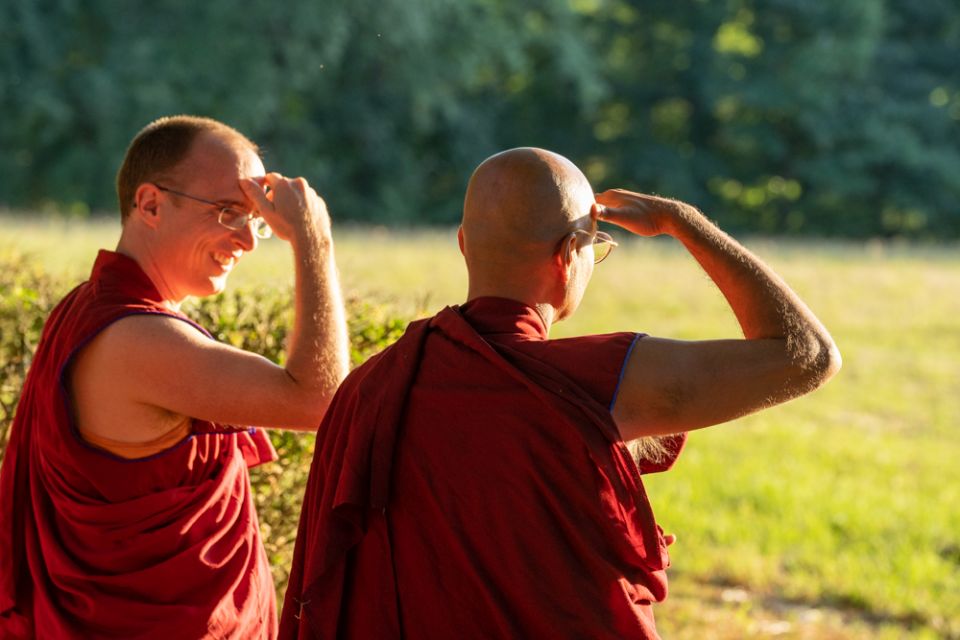
Monks viewing land to become Maitreya Pure Land, Lavaur, France, August 2019. Photo courtesy of Nalanda Monastery.
Purchasing the Property
The realization of this project to purchase the neighboring property, which will help to fulfill Rinpoche’s wishes, relies entirely on the kindness and generosity of sponsors. All donations, regardless of size, will be most welcome and greatly appreciated.
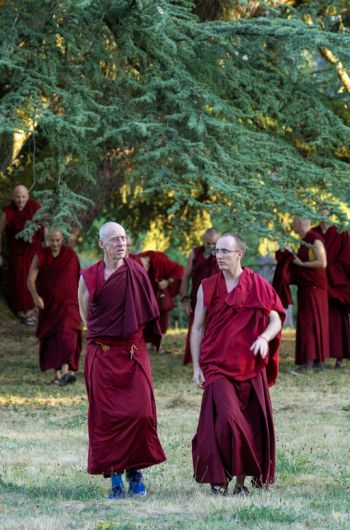
Geshe Graham Woodhouse, Nalanda director Ven. Gyaltsen, and Nalanda Monastery monks on the property they are seeking to purchase to create Maitreya Pure Land, France, August 2019. Photo courtesy of Nalanda Monastery.
The original asking price was US$1,650,000. However, due to the good will on both sides, the owner will accept US$1,340,000. Our deadline to secure the funding to purchase the property is the end of December 2019. Additionally, we shall need to renovate and adapt the buildings to suit our monastic community, and for this we estimate that a further US$100,000 will be required.
Two Nalanda monks are visiting North America for a promotion and fundraising tour from October to December 2019. They are visiting FPMT centers where they will talk about the benefits of monastic community and the plans to expand Nalanda. As they travel, they are documenting their journey on a Facebook page.
The positive karma generated by making offerings to the monastic community is beyond measure in this and future lives. The Buddha said in the Mindfulness Sutra, “Whoever has built the support [statue] and supporting [temple] well and arranged a place and for the needs of the Sangha will always have more and more happiness and virtue. The virtue can never be wasted or lost, even for millions of eons. One who has built the holy body of Buddha (statue), the holy speech of Buddha (scripture), the holy mind of Buddha (stupa), the kungarawa (temple or shelf for Dharma texts), and establishes the monastery (Sangha), gains very extensive merit, which is never lost and always increases.”
Monastic communities do not just preserve the Dharma and provide a place for monastics, but also help lay people directly and immediately. In this regard, those outside the monasteries are able to collect merit by coming to the monasteries, getting inspired and making offerings. By building monasteries, Buddhist practitioners collected so much merit in the past.
The acquisition of this property will provide benefit for the Dharma and the Sangha in the West for now and for the future. It will also give an opportunity to many lay students to not only develop their Dharma knowledge through our extensive study programs, but to integrate these teachings through intensive meditation practice. This will create the foundation for training more qualified Western teachers in order to benefit all sentient beings.
To give you an idea of the project, Harald Weichhart has made an inspiring video that shows how we envisage the future of the monastery.
Watch the video on Maitreya Pure Land:
https://youtu.be/1RKwuywh-ww
If you want to follow the efforts of the Nalanda monks to raise funds for the Maitreya Pure Land Project, you can find information on their Facebook page, which is called “Nalanda’s North-America Merit Tour” or “NalandasTour.”
The Nalanda monks would be very happy to be invited to present their project directly at a center and to answer any questions. Contact Nalanda.tendar@gmail.com for possibilities.
Please see Nalanda’s website for more details on the project and to offer your support:
https://maitreya.nalanda-monastery.eu/
14
Training the Mind in Generosity
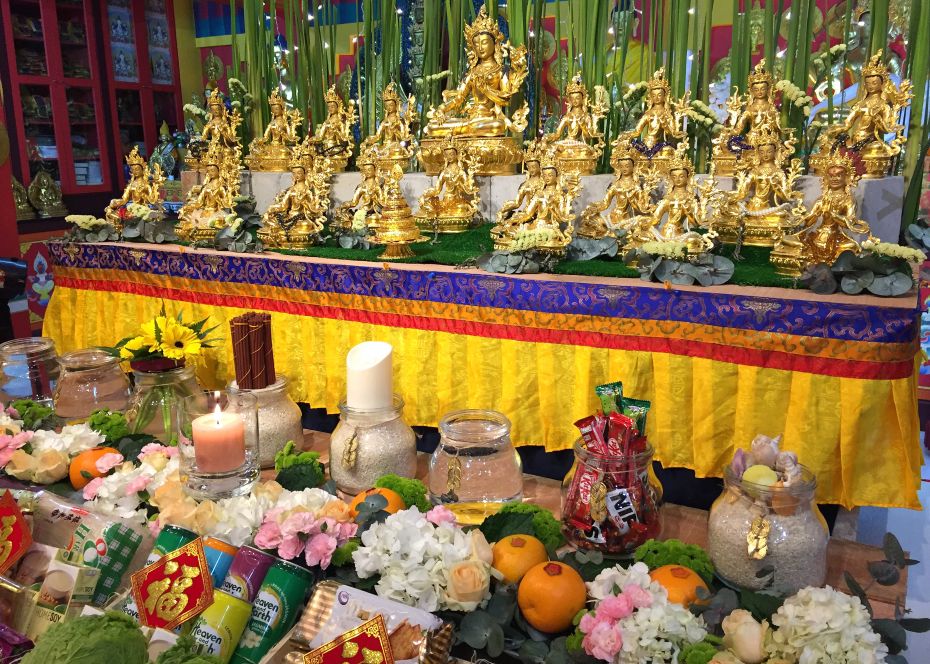
Overnight Praise to Tara at Losang Dragpa Centre, Selangor, Malaysia, January 2017. Photo by Gavyn Teh.
It is always a challenge for a Dharma center to balance the wish to benefit all sentient beings with the practical day-to-day needs associated with running a nonprofit organization. Funds are needed not only for the expenses of rent or a mortgage, utilities, and furnishings, but also for holy objects and offerings, practice materials, offerings to teachers, and so forth. Since it is FPMT policy that FPMT centers can charge students only a “facility fee” to cover the practical costs of organizing a teaching but cannot charge for the Dharma, FPMT centers have come up with creative solutions to keep their centers running.
The practice of generosity is fundamental to Buddhism, and it can take many forms. For most students of Dharma, offering money or belongings is a familiar way to practice generosity, or dana in Sanskrit. Many centers have developed methods to skillfully offer students opportunities for practicing generosity that support and align with the center’s efforts to share Dharma.
We invited several FPMT centers to reflect on how they sustain their centers while providing meaningful programs to the public.
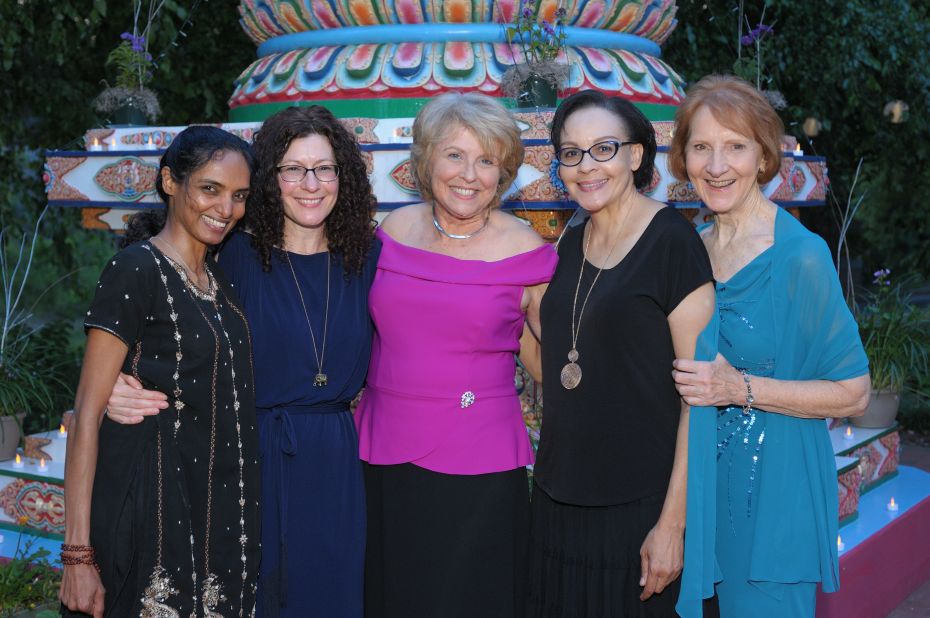
Jaya Reddy, Carol Laing, Kim Lillig, Siddhi Shonibare, and Carol Vogel at Kadampa Center’s 25th Anniversary Gala, Raleigh, North Carolina, US, June 10, 2017. Photo by Doug Pitts.
Kadampa Center
Raleigh, North Carolina, US
Jill Marie, center manager
“Generosity is the most natural outward expression of an inner attitude of compassion and loving-kindness.” This quote from His Holiness the Dalai Lama speaks volumes about the model of giving at Kadampa Center.
Twenty-seven years have passed since Lama Zopa Rinpoche formally named the fledgling study group “Kadampa Center.” In 2017, we celebrated our Twenty-fifth Anniversary with a festive, fancy gala, and after gathering “Stories from the Past,” it brought to mind how our generosity model began.
Our founder, Don Brown, when asked about how we charged for classes and other programs in the early days, said, “We started with fees, then suggested donations. Since there weren’t many people to begin with, a few individuals supported the teachings because they wanted to make it happen.”
He explained, “We tried to charge for classes and visiting teachers, but it wasn’t very successful. People were way more generous than the suggested donations.”
When Bo Lozoft, a visiting teacher came in the early 1990s he suggested that if you value these teachings you vote with your pocketbook for what makes a difference for you. Joanna Smith, a founding member and first board of directors secretary commented, “Bo said he would not teach if we required a fee. He didn’t feel the Dharma should be charged for. We decided that that was a good policy and have been that way ever since.”
Gradually we moved from a “charging” culture to a “giving” culture. It didn’t happen overnight. Yes, we were apprehensive, but also optimistic. As Herb Cunningham, our first treasurer, said after we got settled, “We had packed houses all the time! More checks than I could put on a single deposit slip. We were flush. That took care of the worry about dana.”
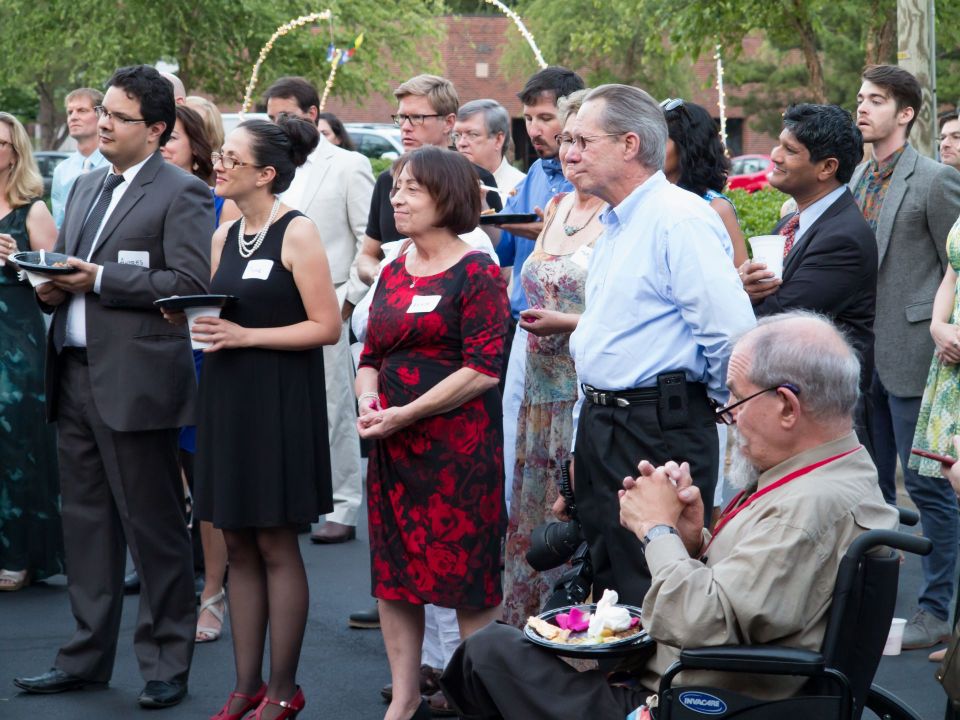
Kadampa Center’s 25th Anniversary Gala, Raleigh, North Carolina, US, June 10, 2017. Photo by David Strevel.
At one time we had gradations of membership. It didn’t work well and set a limit on giving. Eventually we created a monthly pledge plan, and that gave us confidence and reliability for continual funding.
As our center grew we needed a bigger space. To create connectivity for giving, we gathered in small groups for meals in folks’ homes to discuss our vision. We also used to show a visual pie chart of where the funds went every quarter on our wall. This seemed to help members have confidence in how their generosity was allocated.
Today we continue in our generosity model with our annual fundraising appeal that draws in sixty-five percent of our budget. The spiritual program brings in fifteen percent, and the bookstore plus the family program makes up the rest. We fundraise from time to time if we have any holes in our budget.
During our annual appeal we offer four ways of giving: financial, practice, service, and in-kind donations. This strategy helps everyone be able to practice generosity on some level, while our skits and heart talks inspire generosity on many levels. In fact, that is also the name of our financial committee, the Inspiring Generosity Committee.
To keep the generosity idea fresh during the year our center manager, Jill Marie, pops into the first night of every new class to say hello and talk about dana. Other members talk about sponsoring visiting teachers and pujas.
Many opportunities arise for inspiring generosity when specific charges are not required for classes, workshops, or retreats. While this takes more work on the side of providing information, funding categories, and creative campaigns, it keeps giving heart-based for the donors. They have options to make connections to visiting teachers, pujas, holy days, and more. The bookkeeping can become cumbersome and a little overwhelming at times, yet we love our model of generosity. We definitely challenge our “church software” technical support folks as they have never encountered as many fund codes that offer this many choices for giving. It makes tithing seem easy.
Our center thrives today: from the causes and conditions our founding members created by craving the teachings, and those who support us regularly, to our newest members who walk into the door and slip a five dollar bill into the donation box. It’s all inspiring.
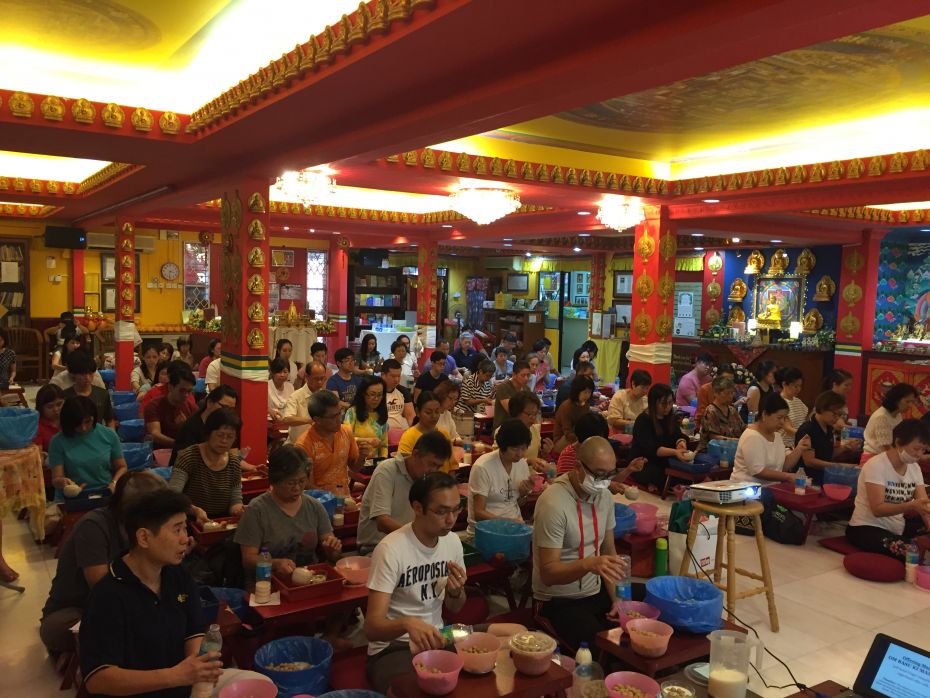
Naga Puja at Losang Dragpa Centre, Selangor, Malaysia, September 2018. Photo by Gavyn Teh.
Losang Dragpa Centre
Selangor, Malaysia
Candy Tan, spiritual program coordinator
We charge a minimal facility fee for retreats—just to cover the cost of food and utilities—but other than that Losang Dragpa Centre (LDC) has never charged for any program since the center was setup. Members know the value of Dharma, and charging a fee may not work in Asian culture.
So far our method of fundraising is working well. Members know we need funds to operate the center so they support in this way.
We do fundraising annually to achieve a certain amount to cover the center’s expenses. Proceeds (non-Dharma) from all fundraising goes to maintaining the center only.
We have a Dharma shop. We sell a variety of Dharma and non-Dharma items. The shop generates a consistent stream of income. We follow the FPMT guidelines for proceeds generated from Dharma and non-Dharma items sold in our shop. All proceeds from Dharma items goes to purchasing and the restoration of statues, printing Dharma books and materials, and more.
Asians are generally quite a generous bunch, and we find these individuals give towards and support their preferred Dharma centers. At LDC we combine the Asian culture of giving with the FPMT guidelines about how to use income from Dharma by offering sponsorship opportunities like light offerings, incense offerings, and altar and puja sponsorship to members as part of our fundraising program.
Candles are placed in the gompa for those who would like to make light offerings. We make arrangements so that members can pre-order lights and incense offerings for merit or multiplying days like Losar, Vesak, Saka Dawa, and Chinese New Year.
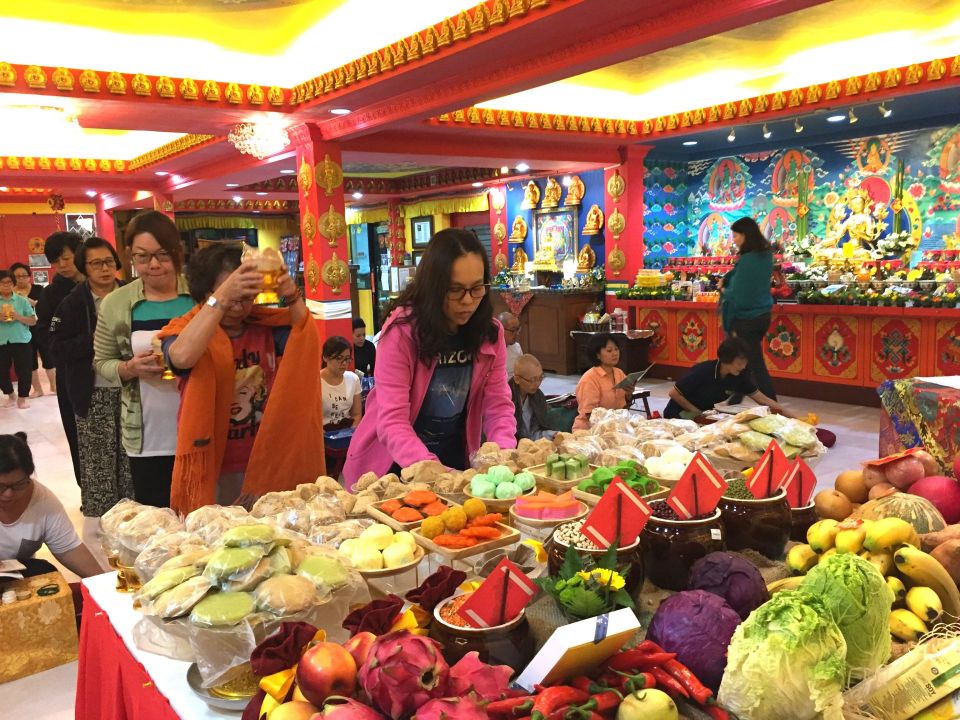
Overnight Praise to Tara at Losang Dragpa Centre, Selangor, Malaysia, February 2018. Photo by Gavyn Teh.
We offer monthly puja sponsorship opportunities. Members can make monthly or annual sponsorship contributions for Guru Pujas, Medicine Buddha Pujas, and Tara Pujas. We also offer opportunities to practice generosity by making offerings for big pujas like overnight Tara Pujas, Fire Pujas, Naga Pujas, and Jangwa Pujas.
We organize an Annual One Thousand Offering Event. It is a two-day event, conducted annually in a public hall and presided over by invited lamas. Khen Rinpoche Geshe Chonyi has been the presiding lama for the past few years. During the two-day event people can sponsor the altar and the Jangwa Puja for the deceased, and also make long life or light offerings. Additionally, people can sponsor pujas, or house or office blessings, conducted by Kopan Monastery monks.
We also make the following available for sponsorships: blessed malas, blessed mandala sets, prayer wheels, stupas, and more.
We place a list of items in our office that members can sponsor, and we also approach members for bigger items. This list can include flight tickets, hall rental and setup, flowers, and food expenses. Usually these items are incurred during big events or when a lama visits LDC.
Members also sometimes donate or sponsor items LDC needs, such as a water filter, refrigerator, or air conditioning unit for the center.
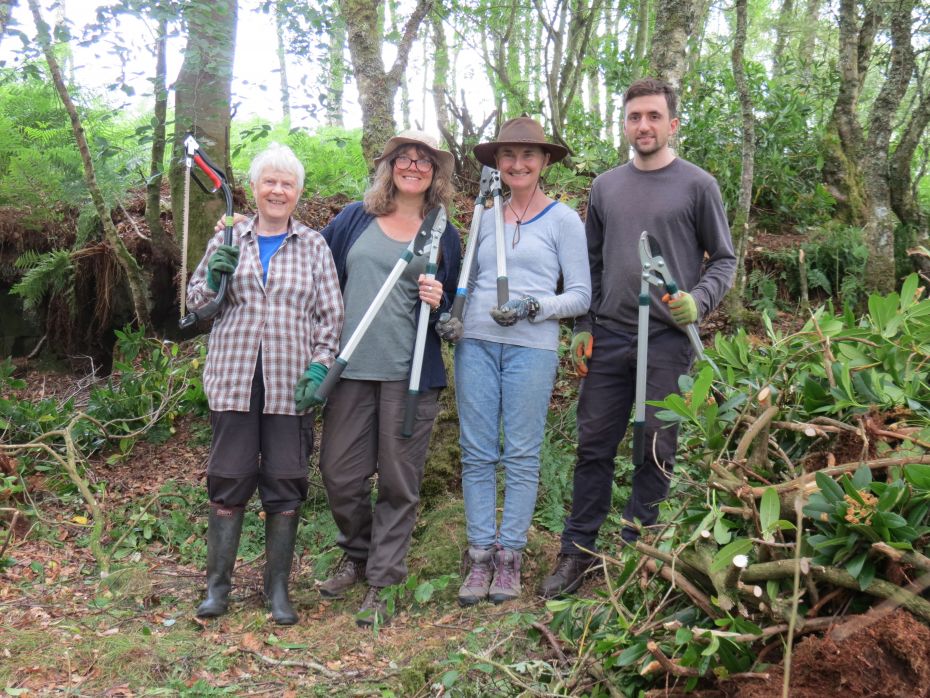
Pauline, woodland and wildlife manager, Caroline, Sally, and Michael at a woodland working party, Land of Joy, Greenhaugh, UK, July 2018. Photo courtesy of Land of Joy.
Land of Joy
Northumberland, UK
Jenny MacQueen, director
The desire to have an FPMT retreat center for the UK was a long-term vision of many people, and around ten years ago, a small group got together to make Land of Joy a reality.
We were hugely fortunate that one benefactor gave a very generous donation, sufficient for the outright purchase of a building, Greenhaugh Hall in Northumberland, a county in northeast England. This happened in September 2014. The first official retreat took place in May 2015.
Looking back at all that has happened in less than four years, it is quite amazing, culminating in a July 2018 event attended by more than seventy people—our coming of age, as it was described! Sometimes we can lose sight of our accomplishments—things seem to stand still, or even dip a bit—but “Wow, wow, wow,” as Lama Zopa Rinpoche would say.
And we all truly believe that one of the major reasons for the flourishing of this very special place is the generosity model we use, a total generosity model. Everyone connected with Land of Joy offers service as a volunteer—the live-in team, the board, the teachers—and all the other volunteers who work with us regularly or occasionally. We offer everything—teachings, accommodation, and food—freely and joyfully without expectation, as far as we are able! It’s not without its challenges, and it can be uncomfortable on both sides, but it is working and we are all totally committed to it.
The commitment and generosity of our volunteer team is an integral part of our generosity model; managing that team for the benefit of both the volunteer and the center is essential. Our live-in staff members are all volunteers, working six to eight hours a day, five days a week. We also have other regular volunteers, both local and non-local.
All live-in volunteers are provided with accommodation, meals, and basic personal toiletries. However, as an organization we are very conscious that volunteers may have additional financial needs, both short-term and long-term, and we make efforts to respond to this as far as resources and legal restrictions allow. We offer state pension contributions where applicable and contribute to attendance at teachings and retreats both at the center and elsewhere. Occasionally, we have a specific project that a volunteer can claim payment for (on a self-employed basis). In addition, retreatants often offer dana for the volunteers, and this is shared out among the whole team.
Many of our volunteers do have additional means of support such as from savings from employment, pension, or sponsorship from other sources. Some have done outside paid work via technology or very occasionally locally.
However, as the center has developed we have become aware of the need to move towards formal term agreements for both volunteer engagement and tenancy, in order that there are clear expectations and understanding of these agreements on both sides, and to encourage volunteers to be aware of the need to take personal responsibility for their situation.
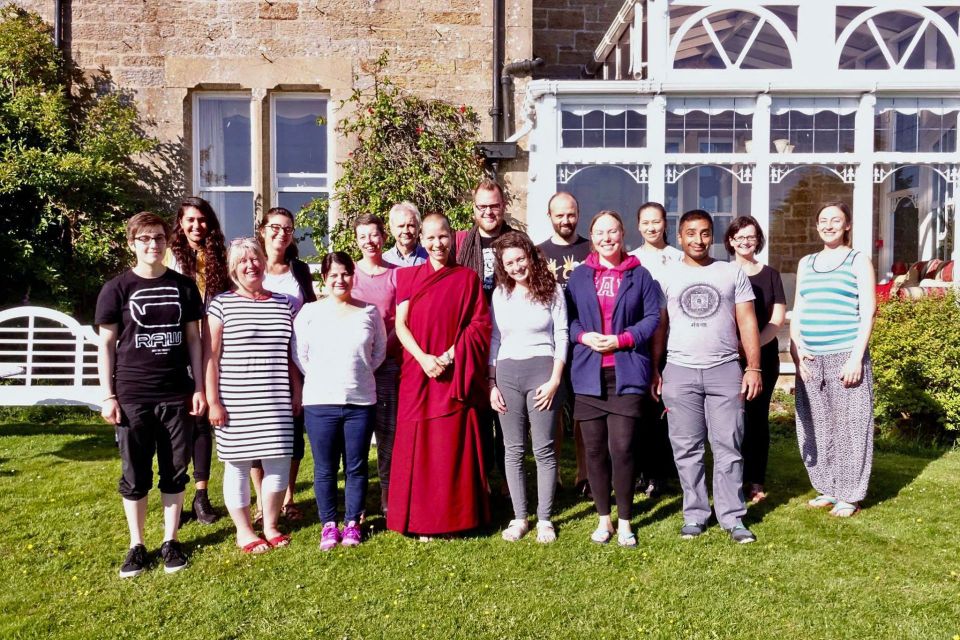
Ven. Amy Miller and students during the Meditation, Mindfulness, and Making Life Meaningful retreat at Land of Joy, Greenhaugh, UK, June 2017. Photo courtesy of Land of Joy.
Making the decision to go forward with the total generosity model did not come easily to the board. Strong arguments against it were expressed, particularly the aspect that staff were not paid. However, the board was persuaded to trial it as an experiment. The key to understanding that decision is the concept of service, so highly regarded in the FPMT organization, and the recognition that funding flows from positive spiritual potential, not the other way round.
It was helpful that the original business plan followed a traditional model of market research and used standard business model costings. This meant that the board had well-researched background information and was very aware of what funding was required for set-up and on-going costs.
We carefully monitor all income and expenditures on an on-going basis. Overall, the generosity model meets—and even exceeds—the targets of the standard business model, although every individual donation or retreat may not. That is the beauty, and challenge, of working in this way.
Our spiritual program coordinator, Beth, describes her experience of the model in the following way: “Implementing a generosity model requires open-heartedness and trust. It regularly challenges my thoughts and actions through redefining what I see as being sincerely generous. It gives me the chance to see how limited my ideas surrounding it are and the chance to go beyond them.
“It has enabled me to see how generosity can manifest in many different ways—not just through money but through kindness, time and effort, and compassion—and that these different forms of generosity are equally as generous and should be celebrated equally. It has given others and myself the precious chance to become more willing to give. It’s liberating and inspiring.”
Adopting a radical model as an organization is one thing. Convincing others to accept it is another. For many people in the West, the concept is totally alien.
We are frequently asked, “But what is the suggested donation?” or “How do I know how much to give?” The idea of giving too much appears to be as challenging as giving too little.
The reality is that it is very simple to come up with a realistic amount just by looking up the prices at other retreat centers. The much harder question is, “What does generosity mean to me?” That can be uncomfortable, but that is Dharma in action—mind transformation.
Ven. Mary Reavey, a regular teacher at Land of Joy who has been involved from the early stages, had her doubts as to how the model would work. Now she says, “I have seen this generosity model generate waves of altruism, directly combating selfishness. No wonder it’s the first step on the path of a Bodhisattva.”
Then again, there is a perception in the West that if something is not priced high, then it is not of much value. Andy Wistreich, a key member of the original founders expresses our response to that perception in this heart-warming way: “If there is a vestige of it in people’s minds before they come, this is quickly melted by the warm, welcoming, generous energy that greets them on arrival, and continues throughout their stay. This energy is in every meal, every cup of tea, and in every experience of walking in the woods, enjoying a hot shower, sitting by the fire in the sitting room, or helping in the garden.
“Simply Dharma is a joyful practice. Retreat from the ordinary world is retreat into Dharma, which transcends ordinary boundaries. We try to reflect that in the way we relate to people.” What about the future? Up until now, we have mainly offered group retreats. Now, we are moving into phase two of our long-term plan, offering facilities for personal retreat.
We have converted an old coach house, creating three modern, en-suite rooms plus a new meeting room, and a gompa where a fourteen-foot high high Kurukulla will dance as advised by Lama Zopa Rinpoche. We will also have three retreat huts in place on the grounds this year. We will offer all of these new facilities on that same generosity model.
Our income currently comes from retreat donations, supplemented by regular and one-off donations from supporters. These cover our overall outgoing costs and generate a small surplus. We also fundraise for specific projects—largely from individuals, but also from various funding bodies.
However, Greenhaugh Hall is an old building with high maintenance costs. Going forward we will have to consider developing income generation streams beyond our current methods.
Our commitment to the generosity model not only remains strong, it is gaining in strength. Working with the total generosity model creates an energy very different from normal transactions—a real and ongoing connection, that “pamily peeling” that FPMT founder Lama Yeshe often talked about. It also encompasses everything that we and our supporters give, way beyond money—time, practices, mantras, just being here and taking part, giving with a good heart, dedicating the merits to all sentient beings. This creates the merit and the causes and conditions for Land of Joy to flourish for eons to come.
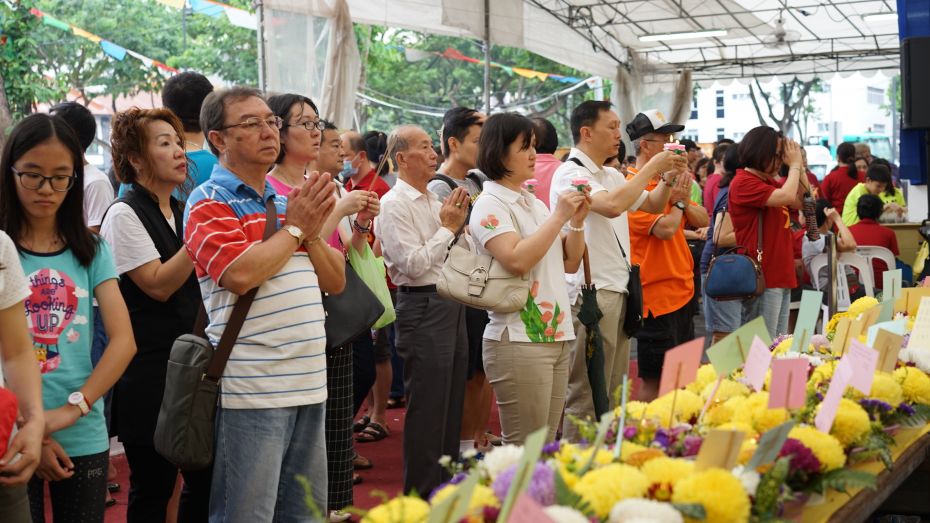
Vesak Celebration, Amitabha Buddhist Centre, Singapore, May 2017. Photo by Tan Seow Kheng.
Amitabha Buddhist Centre
Singapore
Cecilia Tsong, long-time student, active ABC member and volunteer
Amitabha Buddhist Centre (ABC)’s success in fundraising and Dharma propagation has its roots in the guidance and advice we receive from Kyabje Lama Zopa Rinpoche. We are also fortunate to have a long-serving, well-liked center director, Tan Hup Cheng, who seems to have the Midas touch when it comes to sourcing for financial support.
It helps too, that ABC is in a cultural environment where many have faith in the Triple Gem and believe in the benefit of making offerings to temples and Dharma centers, commissioning holy objects, as well as supporting Dharma publications and various Buddhist initiatives.
As part of their cultural values, Chinese people have a strong belief in the law of cause and effect, even though they may not necessarily be practicing Buddhists. Often, they will support temples, Dharma activities, and ordained Sangha with funds so that they may enjoy prosperity and happiness in this life.
Through a better understanding of the Dharma by attending teachings at ABC, students learn that generosity can be practiced in other ways: offering service to the center, participating in animal liberation activities to protect the lives of animals, and sharing their understanding of the Dharma with newer students.
ABC’s main fundraising drive takes place every year on Vesak Day, a public holiday in Singapore. This is a time when the general public is inclined to make offerings as a way of remembering the kindness of Shakyamuni Buddha and requesting his blessings for a life well-lived.
Mindful that Dharma is priceless, local Buddhist centers and temples offer Dharma teachings free of charge. However, ABC does levy a nominal charge for Nyung näs and one-day retreats to cover the costs of meals, refreshments, and altar offerings. ABC also organizes pilgrimages and retreats overseas, and every effort is made to keep prices low. For these activities, there is differential pricing for ABC and non-ABC members.
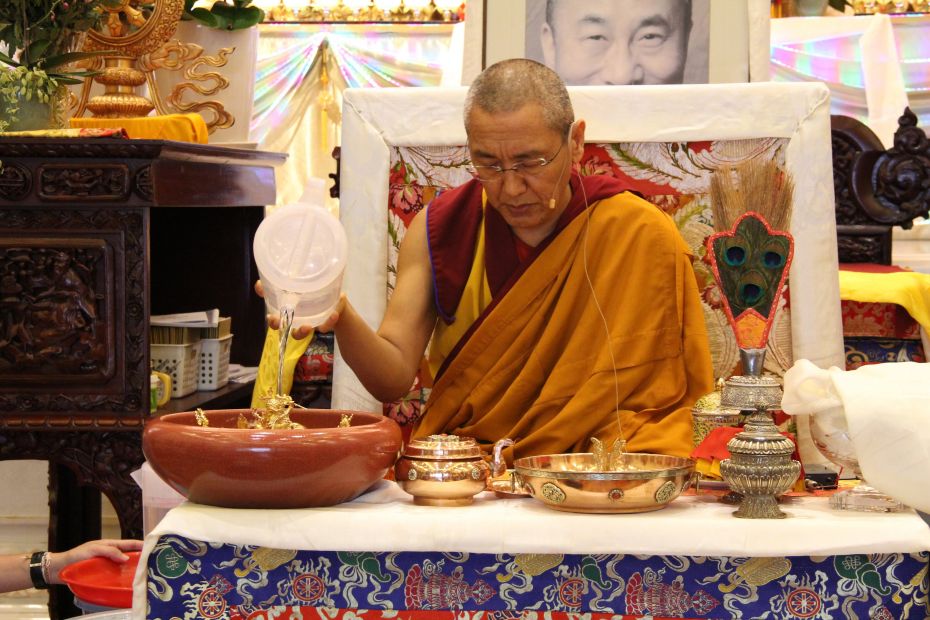
FPMT resident geshe Khen Rinpoche Geshe Chonyi during an Ullambana puja at Amitabha Buddhist Centre, Singapore, August 2014. Photo by Noelle Teoh.
Apart from Vesak Day programs, ABC has developed special Dharma events over the years to bring more people to the center. The Medicine Buddha Dharma celebration, Most Secret Hayagriva puja, and Ullambana puja are popular and have been attracting a growing group of participants each year. Corporate sponsorships are available for these pujas, an option that appeals greatly to local business people.
For those who love all things beautiful we have a well-curated collection of Dharma objects—statues, malas, offering bowls, prayer wheels, prayer flags, incense, thangkas, and so forth—that are available at our Tashi Delek retail store. This generates additional income that is pumped back into serving the center’s needs.
In its fundraising activities—including its Dharma shop—ABC is fastidious in making sure that these funds are used in accordance with the donors’ wishes. Also, when holy objects are sponsored from the Dharma shop, such income is directed to supporting the maintenance and building fund of the center, and not to the support of the Sangha as such.
Lastly, as an on-going fundraising drive, ABC runs a program of electronic debit sponsorships where people can choose to have regular deductions made from their bank accounts.
There are also donation boxes in the center for our building and maintenance fund, Sangha fund, publications, animal liberation, puja fund, and general funds. Visitors are free to drop their offerings—and say a silent prayer in the sacred ambiance of the merit-field—while recalling the words of Lama Zopa Rinpoche in The Four Noble Truths: A Guide for Everyday Life, “Be as generous as we can to benefit the poor and sick. Make offerings to holy objects and other living beings, and dedicate this generosity for the happiness and enlightenment of all beings. Doing so offers great release to our minds.”
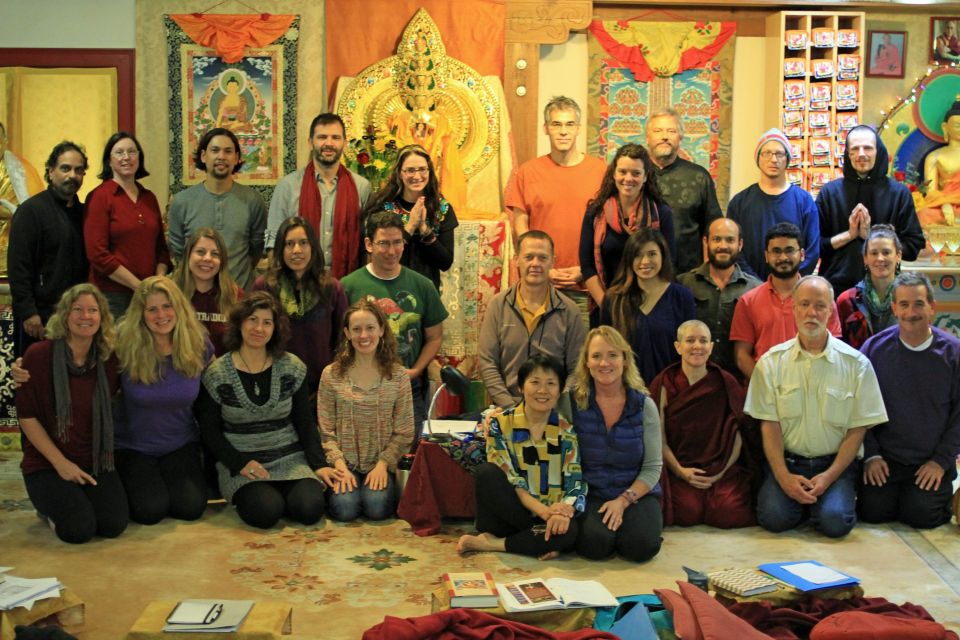
Pay-It-Forward Kopan West lamrim retreat led by Glen Svensson at Vajrapani Institute, Boulder Creek, California, US, November 2014. Photo by Glendon Papa.
Vajrapani Institute
Boulder Creek, California, US
Ven. Fabienne Pradelle, former director
For years we’ve been battling with ways to make our retreats financially accessible to all, so that money would not come in the way of people being able to experience retreat. In this quest we tried so many different things, such as sliding scales or making scholarships opportunities very visible on the retreat registration pages.
Our success was limited. While some people would apply for scholarships many didn’t, thinking they would take away from a Dharma center.
Then in 2013, we started exploring a different model, Pay-It-Forward. Pay-It-Forward is different from the dana model where people make a donation towards their retreat.
Retreats offered at Vajrapani Institute on the Pay-It-Forward model are free, totally free. There is a deposit—which is non-refundable if you don’t show up—just to minimize the amount of no-shows and empty beds.
Whatever people offer towards Pay-It-Forward goes towards sponsoring future retreats. People get to experience being here thanks to the kindness of strangers who offered money to make it possible for them to be here.
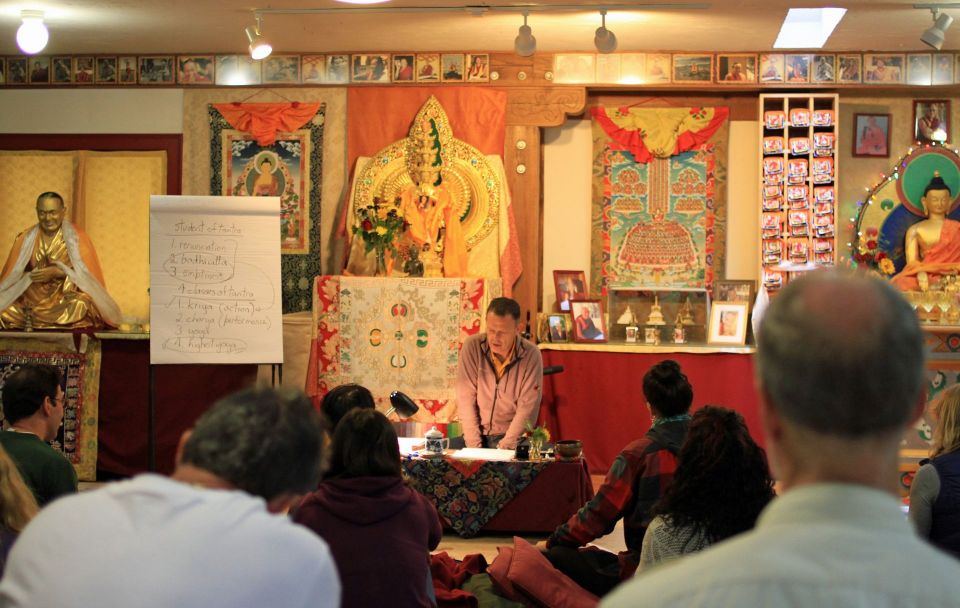
Pay-It-Forward Kopan West lamrim retreat led by Glen Svensson at Vajrapani Institute, Boulder Creek, California, US, November 2014. Photo by Glendon Papa.
This may sound like semantics. A cynic could ask, “Well, aren’t they really paying for what they receive?” The answer is it’s not semantics.
It’s extremely valuable for participants to experience being the recipient of other’s generosity. And out of that space, to have the wish to make it possible for others to have that experience—to sponsor not ourselves, but others who will never know who we are, and will never thank us. There is so much richness in those experiences.
We have found that this Pay-It-Forward model has increased the social diversity of participants. We see more people who are between jobs, single parents, students, and so forth. We see people who normally wouldn’t be able to access those retreats.
A quarter of our retreats are now offered on a Pay-It-Forward model. Our hope is to be able to offer more on this model in the coming years. Virtue begets virtue, and who knows who may be inspired to help us make this possible in the future!
For more information about Amitabha Buddhist Centre, visit their website:
http://www.fpmtabc.org/
For more information about Losang Dragpa Centre, visit their website:
http://www.fpmt-ldc.org/
For more information about Kadampa Center, visit their website:
https://kadampa-center.org/
For more information about Land of Joy, visit their website:
http://landofjoy.co.uk/
For more information about Vajrapani Institute, visit their website:
https://vajrapani.org/
- Tagged: amitabha buddhist centre, candy tan, cecilia tsong, fabienne pradelle, in-depth stories, jenny macqueen, jill marie, kadampa center, land of joy, losang dragpa centre, vajrapani institute
26
FPMT Students Experienced that FPMT Family Feeling in Nepal
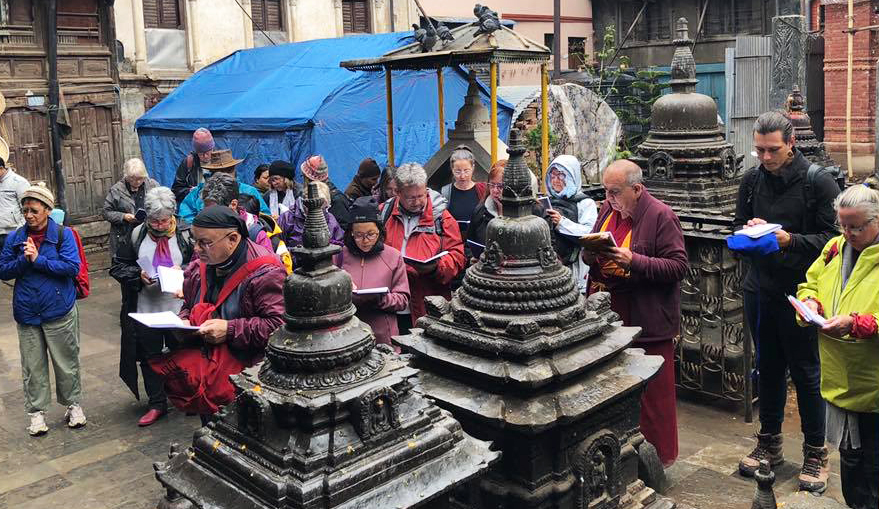
Gen Dondrub and FPMT Australia pilgrims at Jana Bahal Temple, which contains a statue of Avalokiteshvara, one of the most revered by Newari Buddhists, and small paintings of the 108 manifestations of Avalokiteshvara, Kathmandu, Nepal, February 2019. Photo by Mark Kinnear.
In February 2018 a group of FPMT students traveled together from Australia to Kathmandu, Nepal, for a pilgrimage led by Gen Thubten Dondrub*, FPMT resident teacher at Buddha House, an FPMT center in Australia. In addition to encountering Lama Zopa Rinpoche in Nepal, the pilgrims visited many holy places: Boudhanath Stupa; Namo Buddha Stupa; Swayambhunath Stupa; holy sites in Sankhu, Pharping, and Patan; Nagi Gompa; the Maratika Caves; and ancient city temples associated with the deities Tara and Vajrayogini. This story was compiled by some of the Buddha House pilgrims.
On February 3, 2018, twenty-two students from five FPMT centers in Australia—Buddha House; Hayagriva Buddhist Centre; Tara Meditation Centre; Vajrayana Institute; and Gyalwa Ensapa Broome Buddhist Study Group—flew into Kathmandu, Nepal, for the beginning of what turned out to be very auspicious twenty-one days of pilgrimage.
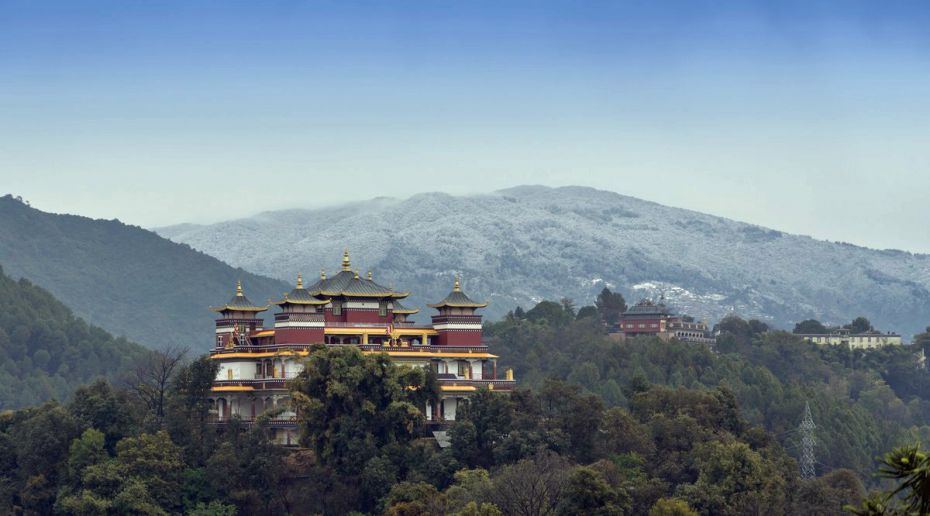
Snow in the mountains, a view from Kopan Monastery, Kathmandu, Nepal, February 2019. Photo by Ven. Lobsang Sherab.
Arriving at Kopan Monastery, the FPMT monastery in Kathmandu, around midnight, the group was greeted the next morning with a thrill—they discovered Lama Zopa Rinpoche was in residence at Kopan for Losar (Tibetan New Year) and would be there through to the Day of Miracles.
Lama Zopa Rinpoche advised in “Practices for Pilgrimage”: “How do we make pilgrimage as meaningful, useful and beneficial as possible? The main point of pilgrimage is to subdue our minds. By eliminating mistaken thoughts, not allowing the mind to be under the control of delusion, the mind is better able to actualize the lam-rim realizations, from guru devotion up to enlightenment.”
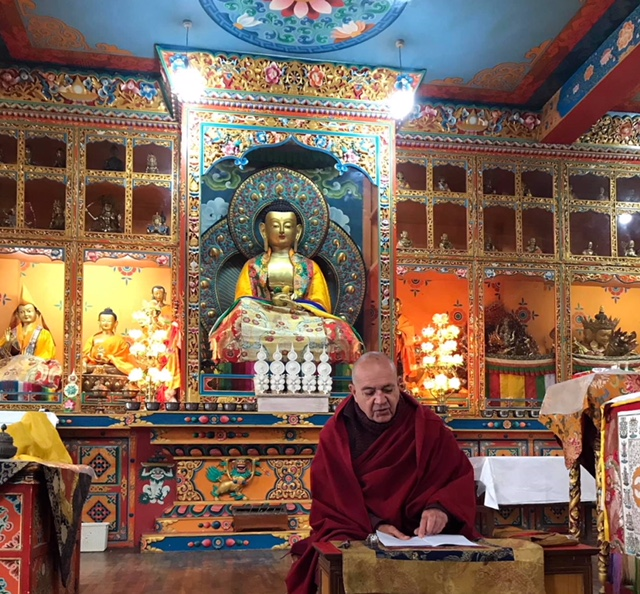
Gen Thubten Dondrub leading a short retreat on Orange Manjushri in the Tantric College Gompa at Kopan Monastery, Kathmandu, Nepal, February 2019. Photo by Sandy Faber.
Gen Thubten Dondrub began the pilgrimage with a strict pre-warning to those about to join him, saying, “You are not on a holiday.” We would be visiting the holy sites in Kathmandu, the Kathmandu Valley, and Maratika Caves, where we would recite prayers, mantras, and engage in practices including tsog offerings.

Gen Thubten Dondrub leading practices and tsog offerings, Sankhu, Nepal, February 2019. Photo by Peter Wagner.
Due to the kindness and great effort of Judy Wagner, Buddha House spiritual program coordinator, a portable altar, water bowls, and offerings were set up at each holy site—even if the tsog had to be guarded from cunning monkeys!
To fulfill Lama Zopa Rinpoche’s advice of not wasting time, Gen Thubten Dondrub made the most of our lengthy bus and jeep rides through Kathmandu traffic, leading Tara and Vajrasattva practices in the morning and dedications during the rides home.
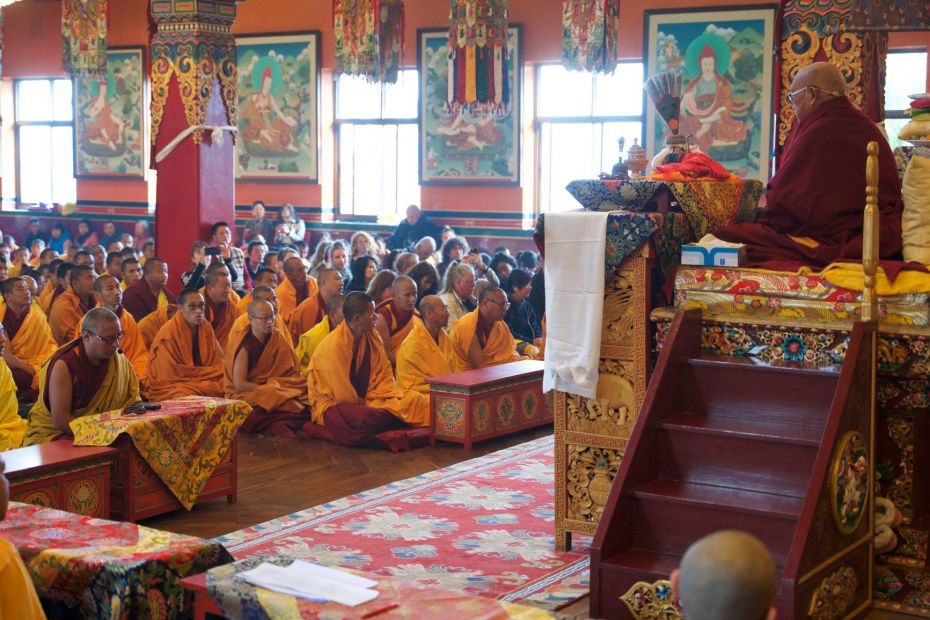
Lama Zopa Rinpoche offering the White Umbrella deity empowerment at Kopan Monastery, Kathmandu, Nepal, February 2019. Photo by Bill Kane.
Lama Zopa Rinpoche advised in “Practices for Pilgrimage”: “Devotion is very important in pilgrimage, otherwise we are no different from a tourist—taking pictures of that place, that rock, that cave, with no change to the mind, the heart.”
The tight itinerary was subject to change and impermanence; each day news came through of special pujas, initiations, and prayers being offered by Lama Zopa Rinpoche in Kopan’s main gompa.
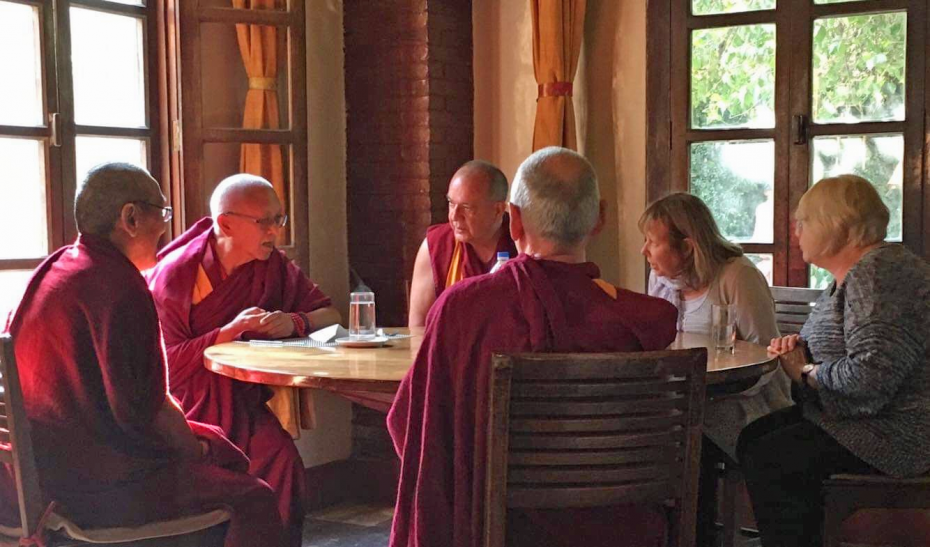
Lama Zopa Rinpoche deep in conversation with Khen Rinpoche Geshe Thubten Chonyi, Ven. Roger Kunsang, Buddha House resident teacher Gen Thubten Dondrub, director Lyndy Abram, and spiritual program coordinator Judy Wagner at Hotel Vajra, Kathmandu, Nepal, February 2019. Photo by Mark Kinnear.
Gen Thubten Dondrub and Peter Wagner, pilgrimage coordinator and Buddha House student, did an excellent job navigating the changes; all of our planned site visits were fulfilled around Rinpoche’s schedule.
Buddha House and Gen Thubten Dondrub hosted a lunch for Lama Zopa Rinpoche; Ven. Roger Kunsang, FPMT CEO; Khen Rinpoche Geshe Thubten Chonyi, Kopan Monastery and Nunnery abbot; Western Sangha; and the group of pilgrims. We shared lunch at Hotel Vajra in Kathmandu, which included singing “Happy Birthday” to Tenzin Ösel Hita using Facetime!
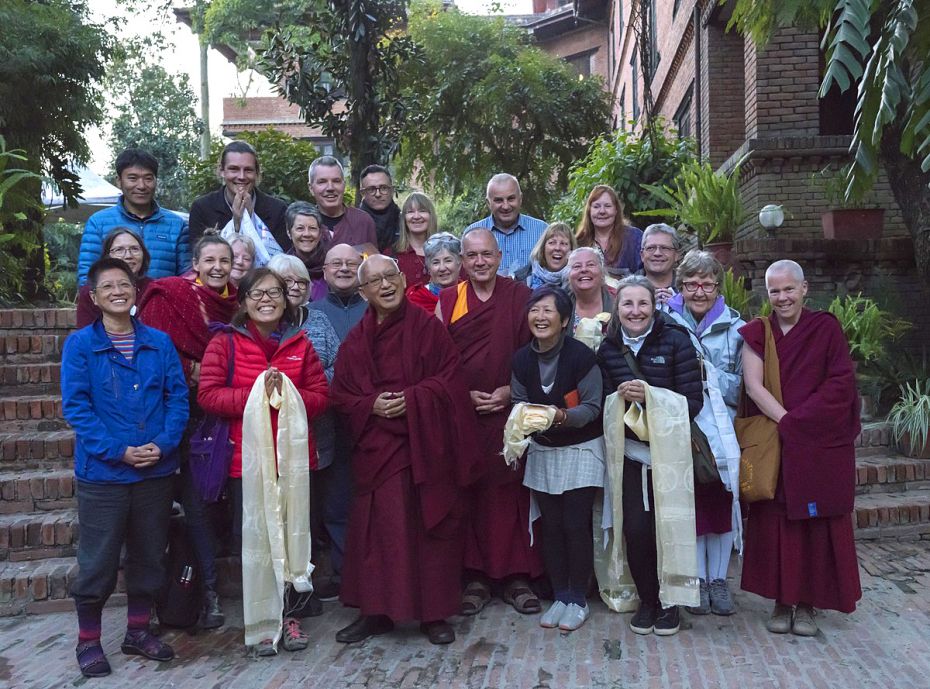
Lama Zopa Rinpoche and pilgrims at Hotel Vajra, Kathmandu, Nepal, February 2019. Photo by Ven. Lobsang Sherab.
This lunch came about due to an offer by Lama Zopa Rinpoche to spend the day with the pilgrims. The day commenced with Rinpoche bestowing the Bodhisattva Vows at Jamchen Lhakhang Monastery, a Sakya monastery at Boudhanath Stupa, and finished twelve hours later after a lengthy circumambulation of Swayambanath Stupa with Rinpoche giving many explanations, offerings, prayer recitations, and dedications along the way.
How amazing—wow, wow, wow!—for the pilgrims to meet and spend time with the precious Guru.
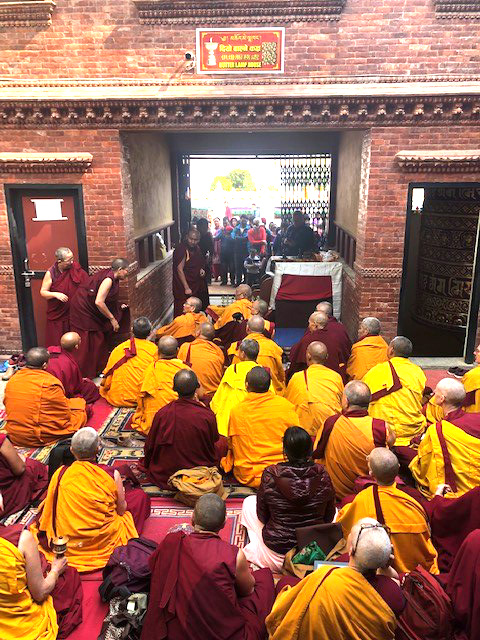
Rinpoche bestowing Bodhisattva Vows at Jamchen Lhakhang Monastery, Boudhanath Stupa, Kathmandu, Nepal, February 2019. Photo by Frank Maraz.
Lama Zopa Rinpoche advised in “Practices for Pilgrimage”: “Actually, on pilgrimage it’s very good to have difficulties because they purify the mind. We have to understand that difficulties purify the negativities; it’s like when we do Vajrasattva retreat and become sick. Think, ‘I am going to this place to purify my mind—to purify all the negative karmas and defilements—and to collect extensive merit, in order to have the realization of lamrim.’
“With such a motivation, when we experience problems or difficulties, these become worthwhile. … Yet if hardships are experienced with the thought of the eight worldly dharmas—with attachment clinging to this life—then there is no special benefit; they only become torture.”
The trip was not without difficulties for most of the pilgrims. From chest to stomach complaints, including knees, hips, and backs, the pilgrims took their turns taking on their purifications with acceptance, knowing how much hardship the great masters of the past bore to practice Dharma.
Lama Zopa Rinpoche advised in “Practices for Pilgrimage”: “One lama made the comment that when the great, holy beings—buddhas, bodhisattvas, and yogis—go on pilgrimage, they bless the place. And when ordinary people go there, they receive blessings from that place. So pilgrimage means to receive blessings from the holy places to inspire our mind to transform into the path.”
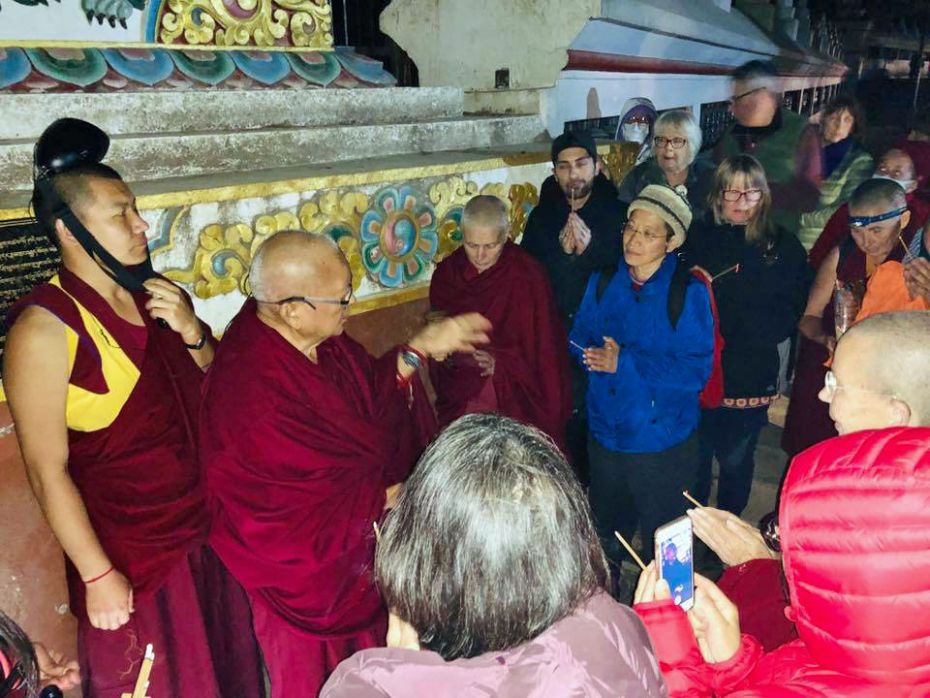
Rinpoche giving explanations, prayers, and making offerings with FPMT Australia pilgrims and Sangha at Swayambhunath Stupa, Kathmandu, Nepal, February 2019. Photo by Carole Migalka.
Many holy places were visited including Boudhanath Stupa; Namo Buddha Stupa; Swayambhunath Stupa; holy sites in Sankhu, Pharping, and Patan; and ancient city temples associated with the deities Tara and Vajrayogini.
Khachoe Ghakyil Ling Nunnery (Kopan Nunnery) was also a memorable visit. The nuns were very welcoming as we all stocked up on the incense that is made on site.
Gen Thubten Dondrub included Nagi Gompa in the itinerary; it is located high up in Shivapuri National Park with a panoramic view of the Kathmandu Valley. The national park and nunnery were covered with snow that morning. It was just magical. After completing our practices and prayers in the beautiful little gompa—and devouring a packed lunch from Kopan—the day cleared up, giving us a stunning view of the valley on our return journey.
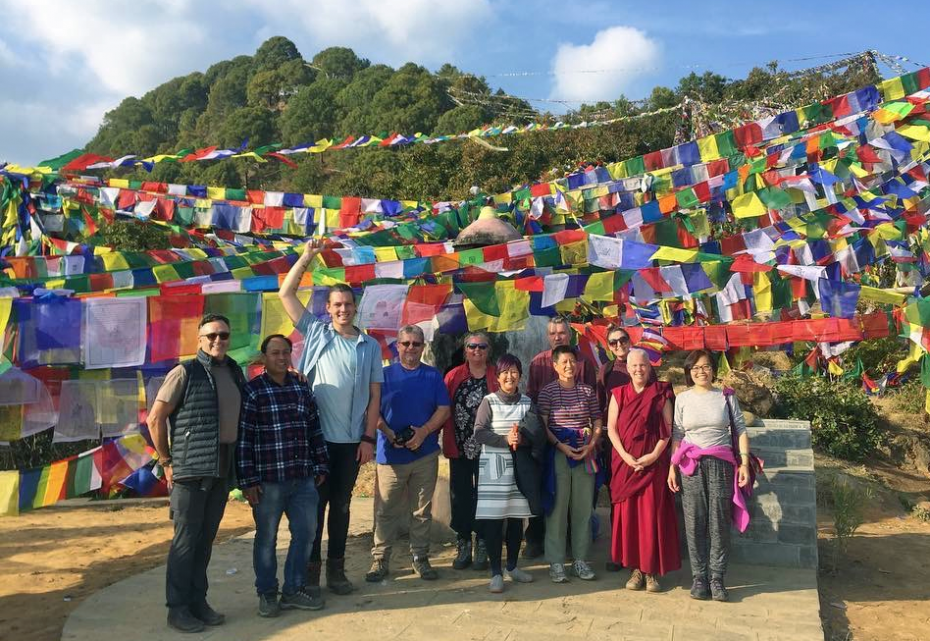
Ven. Joan Nicell with a group of FPMT Australia pilgrims in Pharping, Nepal, February 2019. Photo by Amber Bamjan Tamang.
Our itinerary concluded with a nine-hour jeep ride to the Maratika Caves, also known as Haleshi.
According to Condense Guide to Maratika—prepared by Maratika Lama (Ngawang Chophel Gyatso), a student of the Lawudo Lama, and blessed by Trulshik Rinpoche, one of Lama Zopa Rinpoche’s teachers—Padmasambhava said, “If one visits this great holy place called Haleshi or ‘Astonishing,’ one will not need to experience the lower realms.”
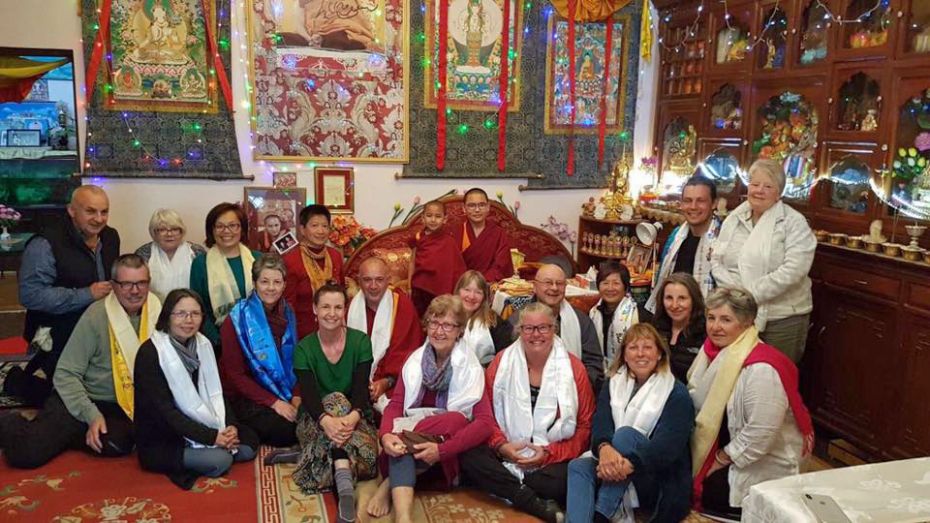
Thubten Rigsel Rinpoche and Tenzin Phuntsok Rinpoche with FPMT Australia pilgrims at Kopan Monastery, Kathmandu, Nepal, February 2019. Photo by Mark Kinnear.
Many thanks go to our compassionate and patient guide Amber Bamjan Tamang, owner of Three Jewels Adventures, for his flexibility and care during the entire pilgrimage. Amber is a Buddhist who holds a master’s degree in culture from Tribhuwan University, Kathmandu. Gen Thubten Dondrub has led four pilgrimages for Australian FPMT centers with Amber as the guide each time.
We also thank Amber’s wonderful team of experienced drivers, who maneuvered the traffic and rocky roads in Kathmandu and the Kathmandu Valley. They also took us through the rugged terrain going to and from the Maratika Caves, which was an experience in itself!
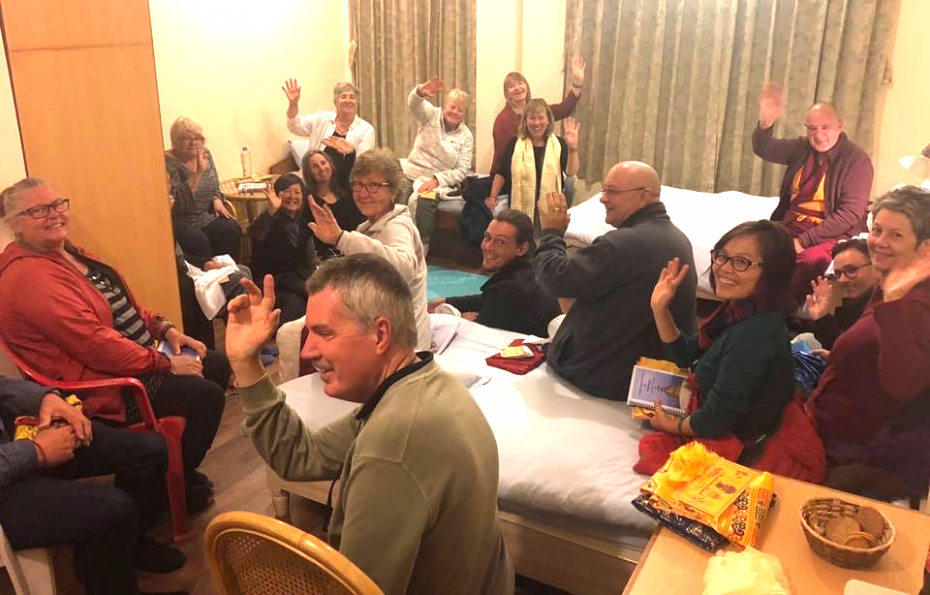
Gen Thubten Dondrub and FPMT Australia pilgrims doing practices on their last night in Nepal, Gen Thubten Dondrub’s room at Kopan Monastery, Kathmandu, Nepal, February 2019. Photo by Carole Migalka.
The “family feeling” (or “pamily peeling” as Lama Yeshe used to say) was truly present at Kopan and for the whole pilgrimage.
We were all so fortunate to have Lama Zopa Rinpoche in residence at Kopan during our visit; to be able to have tea, make offerings, and spend time with Thubten Rigsel Rinpoche and Tenzin Phunstok Rinpoche; and to have the opportunity to connect with pilgrims from other Australian FPMT centers and fellow worldwide travelers who were staying at Kopan, sharing experiences and stories.
Everyone at Kopan was so welcoming and helpful—especially Ani Fran with all her knowledge and assistance during our stay; the wonderful Ven. Joan Nicell for accompanying us to Pharping and leading our practices and prayers that day; Ani Tenzin Namdrol, who is in charge of Lama Zopa Rinpoche’s apartment, for her support with anything that we needed for our pujas and practices at the holy sites; and Ven. Lobsang Lourdup (“Bijay”) and the other monks in the office for all their assistance. They all keep that wonderful “family feeling” alive!
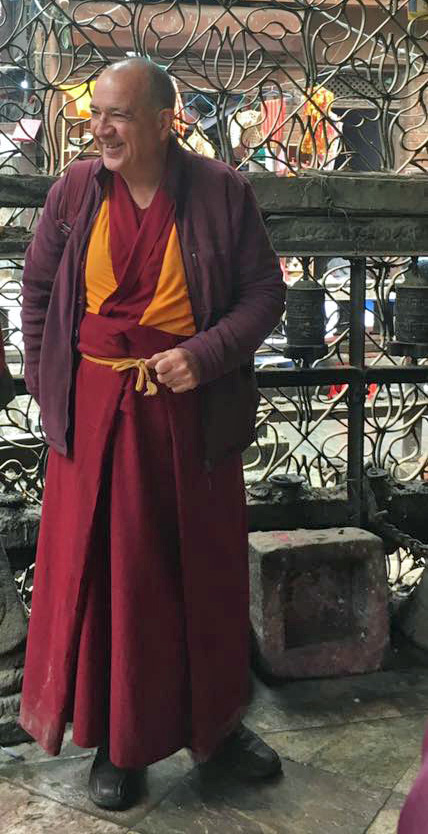
Gen Thubten Dondrub in Nepal, February 2019. Photo by Mark Kinnear.
Lastly and by no means least, a great big “Thank you!” to Gen Thubten Dondrub—for not only leading the pilgrimage—but also for constantly displaying his devotion to Lama Zopa Rinpoche, and his dedication to the FPMT organization through his actions and words.
Gen Thubten Donbrub is such a wonderful humble monk who first met Lama Yeshe and Lama Zopa Rinpoche at Chenrezig Institute back in the mid 1970’s. Gen Thubten Dondrub’s stories, and the references he makes to the lamas during his teachings, helps students feel a strong connection and that FPMT “family feeling.”
Gen Thubten Dondrub has led the November Course at Kopan eight times, teaching hundreds of students from all over the world and influencing so many lives, with some students even going on to take ordination. Staying at Kopan Monastery with this knowledge during the pilgrimage was truly amazing.
We would like to acknowledge and thank Gen Thubten Dondrub for everything he has contributed to help spread the Dharma worldwide over the last forty years. We are so very fortunate at Buddha House to have him as our resident teacher; he has made such a difference since he arrived in 2012.
By the look of all those smiles in these photos, it seems an abundance of blessings were received on the pilgrimage!
* In 2019 Gen Thubten Dondrub requested Buddha House students formally refer to him as “Gen Thubten Dondrub.” He shared, “Usually monks and nuns of the FPMT are referred to as ‘Venerable.’ I have always found this term uncomfortable as it is a very exalted term and is used in the Catholic Church to refer to someone who is in line to be canonized as a saint. When I was in Taiwan I learned that every monk and nun was addressed as ‘Fa Shr’ from the moment they were ordained. The term means ‘Dharma teacher.’ The closest Tibetan equivalent is ‘ge.gen,’ often abbreviated to ‘Gen’ or ‘Gen-la.’ It is polite and friendly. So when people ask how to address me, I suggest using that term. It seems much more appropriate than ‘Venerable.'”
For more information about Buddha House, visit their website:
http://buddhahouse.org
4
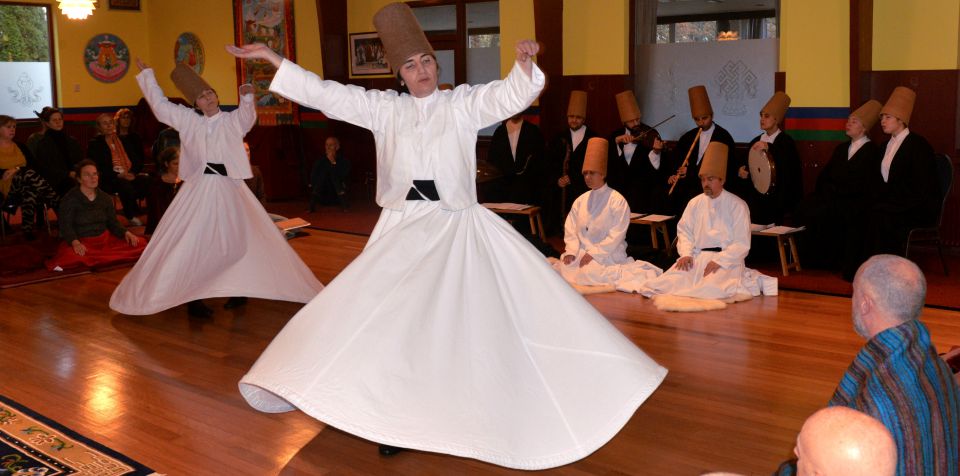
Sufi dervish dancers during an interfaith compassion retreat, Maitreya Instituut Loenen, November 2018. Photo courtesy of Maitreya Instituut.
Maitreya Instituut in the Netherlands hosted an interfaith dialogue that transcended the usual exchange of words. Buddhist and Sufi students came together to learn about each other’s traditions and to practice during a four-day retreat focused on compassion.
Interfaith activities are one of FPMT’s five pillars of service. Maarten de Vries, assistant director of Maitreya Instituut Loenen, describes the special event that took place in late 2018.
All human beings are like the various organs of a body. In the universe, everything is created as interdependent and in need of each other. Consequently, the one who has hurt another actually has hurt himself, and done himself great harm! — Rūmī, 13th-century Persian Sufi mystic
Just as the body, which has many parts owing to its division into arms and so forth, should be protected as a whole, so should this entire world, which is differentiated and yet has the nature of the same suffering and happiness. I should eliminate the suffering of others because it is suffering, just like my own suffering. I should take care of others because they are sentient beings, just as I am a sentient being. — Shantideva, 8th-century Indian Buddhist monk and scholar1
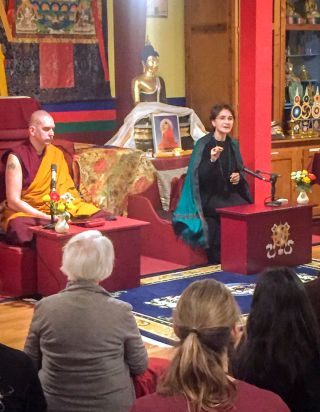
Ven. Losang Gendun and Sheikha Nur Artıran during an interfaith compassion retreat, Maitreya Instituut Loenen, Netherlands, November 2018. Photo courtesy of Maitreya Instituut.
In November 2018, Maitreya Instituut Loenen in the Netherlands organized a four-day retreat lead by Sheikha Nur Artıran, president of the Şefik Can International Mevlânâ Education and Culture Foundation in Istanbul, Turkey, and Ven. Losang Gendun, FPMT resident teacher of Maitreya Instituut Amsterdam. The purpose of the interfaith retreat was to create a space for a participatory dialogue between Islamic Sufism and Tibetan Buddhism, not through mere theological debate, but through the sharing of spiritual practice and bonds of friendship.
The theme “compassion” was approached through Buddhist meditation, Sufi contemplations, mantra and dhikr2 recitation, discussions, and aspirational prayer. Moreover, Nur’s group of dervishes performed sama, the famous swirling ritual done by Mevlevi Sufis following their founder Jalāl ad-Dīn Rūmī. The retreat was attended by thirty-five people from both communities and interested others.
“Nur and I met six years ago in Toulouse, France. We were invited by the Sufi organization Association Internationale Soufie Alâwiyya (AISA),” Ven. Gendun said. “Where many interreligious dialogues tend to carefully tread around sensitive subjects or become apologetic, our first conversation was uninhibited and frank. During Nur’s lecture I was struck by the amount of citations from Rūmī that have counterparts in Shantideva’s Bodhicaryavattara (A Guide to the Bodhisattva’s Way of Life). That realization set the tone of our ensuing and enduring conversations.
“Two months later, our first breakfast together in her community’s dargah in Istanbul, consisted of a three-hour long exchange on a broad range of topics. To the amusement of the people attending, every ‘Shantideva states’ was followed by a ‘Rumi says’—a format that the retreatants in Loenen are now well familiar with.
“During that first visit to Istanbul, Nur remarked how little authentic Buddhism exists there and went ahead to organize an occasion for me to lecture. From the start our relationship has been one not only of cooperation, but of participation, and so to lead a retreat together in Loenen was the natural result of six years of friendship and exchange.”

Participants of the interfaith compassion retreat at Maitreya Instituut Loenen, Netherlands, November 2018. Photo by Tülin Mevlana.
A person who lives according to the wishes and desires of his soul is like a dry leaf. Such people are swept up by the winds of every fancy and craving. However, people who are aware of the higher Divine power within themselves are like a high mountain. Is it possible for such a person to disperse in the winds of wish and desire? — Rūmī
Just as a plantain tree decays upon losing its fruit, so does every other virtue wane. But the tree of the Spirit of Awakening perpetually bears fruit, does not decay, and only flourishes. — Shantideva
There was a conference in Amsterdam, which was well attended, that preceded the compassion retreat. Very appropriately, a large delegation of the Dutch AISA community joined the conference and dedicated the evening with extensive recitations.
A sizable group of dervishes from Nur’s community and a large group of students from the Matireya Instituut center in Amsterdam went on to do the retreat in Loenen. The mornings opened with meditations on the four immeasurable thoughts and bodhichitta, followed by similar contemplations led by Sheikha Nur after breakfast.This was followed by an exploration of the Tara and Chenrezig mantras, and of the Sufi dhikr. Instruction was given on how to meditate on them, interspersed with communal chanting.
Without my foreknowledge, the dervishes had prepared a melody for the Tara mantra and lead us in its recitation accompanied by guitar and sitar. The rest of the days were spent contemplating, meditating on, and discussing various topics—such as impermanence and mortality, interdependence and selflessness, and love and guru devotion—from the perspectives of our respective traditions, not as arguments, but trying to substantiate and complement each other.
Saturday provided the highlight of the retreat with a breath-taking demonstration of sama, the musical ceremony of whirling dervishes, recounting the qualities of the prophets and Allah. Clothed in black funerary robes, signifying the ego’s death, the dervishes circumambulate their teacher as planets do the sun.

Sufi dervish dancers during the retreat, Maitreya Instituut Loenen, November 2018. Photo courtesy of Maitreya Instituut.
An aspect of the dervish’s training that comes remarkably close to the tantric practice of pure view is to perceive all things as manifestations of the divine, and all utterances as those of their sheikh, realizing that our suffering perspective is merely caused by our own ignorance of the true nature of things. Moreover they avoid the pronoun “I” and substitute it with “faqhir,” the poor and humble one, comparable to bhikshu or “beggar,” while addressing others with “can,” “beloved” or “soul.” This obviously opened fertile avenues to discuss. The final morning saw Shantideva’s famous argument for exchanging self and other broached, which seemed appropriate for the occasion.
An additional benefit of the retreat was the opportunity afforded to our two communities to meet, exchange and bond, in the hope of bringing them closer and undertaking more future initiatives together. Much like a what French feminist and intellectual Simone de Beauvoir said: it is in the face of the other that we truly get to see ourselves.
The retreat manifested my hope that our intimate way of sharing our spirituality would open the hearts of the participants to enjoy the specialness of their own lineage. And do this with freedom from grasping at it as an identity, but instead rejoice and participate in the beauty of a sister tradition. To share the fire of our candle never diminishes the light, the Buddha said.

Ven. Losang Gendun and Sheikha Nur Artıran during the interfaith compassion retreat, Maitreya Instituut Loenen, Netherlands, November 2018. Photo by Tülin Mevlana.
The retreat will become an annual event in the Netherlands and also will be hosted in France. Hopefully we can organize them soon in Turkey as well. We are working on translations of comparative selections from the works of Rūmī and Shantideva to support these efforts.
One participants said, “Such an interreligious way of working in a retreat has, in my opinion, really added value for both communities and for our spiritual work in the broad sense. This retreat goes further than what you often see at interreligious meetings, where one just brings forward thoughts from one’s own tradition. We went much further and built something together from a shared inspiration and intention. That was my impression. It seems more like an interreligious session as it once happened in a certain period of the Moghul electorate in India.”
Another participant reflected, “In these times where the world is rapidly and scarily heading towards ever more polarization and aggression against the ‘other,’ the coming together of these two traditions through teachers like Sheikha Nur Artıran and Ven. Losang Gendun is a hopeful beacon of energy, light, and above all love.”
We are the remedy of all problems, relief of the helpless. We are like the Sun on this Earth. We have come to give life to all, to be beneficial and helpful to the whole humanity. To be friendly to the people whose hearts have been broken and become destitute; We came to share their sadness and grief. We are born to bring them, who have fallen into contempt, who fell on the ground, and those who were disregarded, to the rose garden and grant them mirth. We are not the property of a few people, like gold. We are like oceans, mines; we are the property of everyone who live in this world. — Rūmī
A well-intentioned person who thinks, ‘I shall eliminate the headaches of sentient beings,’ bears immeasurable merit. What then of a person who desires to remove the incomparable pain of every single being and endows them with immeasurable good qualities? He satisfies with all joys those who are starving for happiness and eliminates all the sorrows of those who are afflicted in many ways. He dispels delusion. Where else is there such a Saint? Where else is there such a friend? Where else is there such merit? — Shantideva
1. The quotes from Rūmī were translated by Şefik Can International Mevlânâ Education and Culture Foundation. Quotes from Shantideva were taken from the translation of the Bodhicaryavattara by Vesna and Alan Wallace.
2. Dihkr may be short phrases or prayers that are repeatedly recited, similar to Buddhist mantras.
For more, visit Maitreya Instituut online; also, read other stories about Interfaith activities within FPMT.
- Tagged: in-depth stories, interfaith, interfaith pillar, maarten de vries, maitreya instituut, maitreya instituut loenen
24
An Adventurous Trip to Lawudo in Nepal
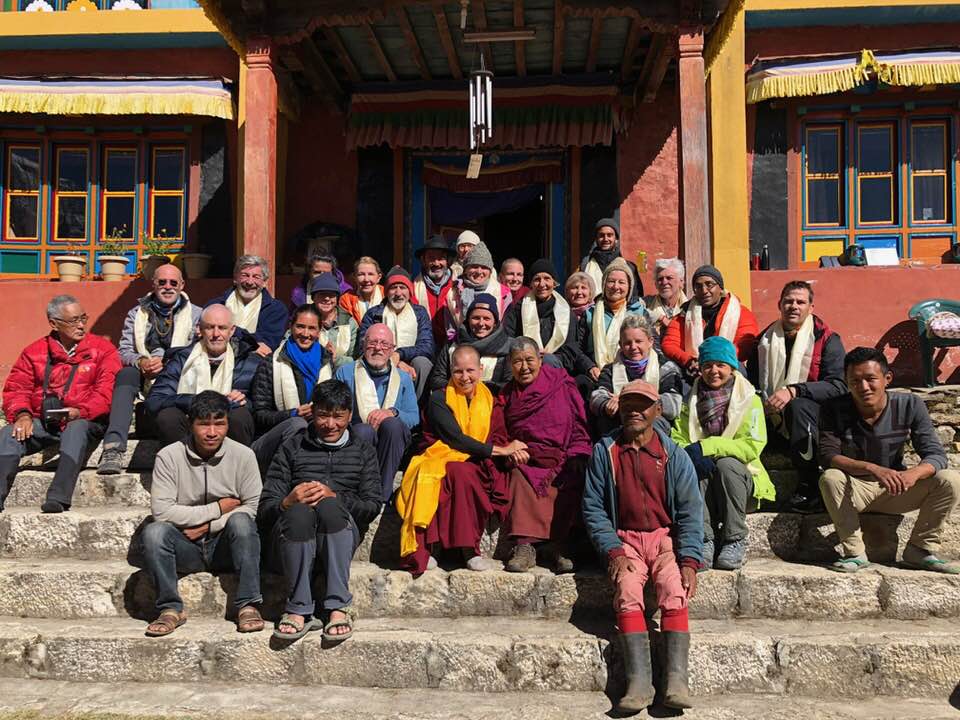
Ani Ngawang Samten, Ven. Amy Miller, and trip participants at Lawudo, Solu Khumbu, Nepal, October 2018. Photo courtesy of Ven. Amy Miller.
Ven. Amy Miller, an FPMT registered teacher, has been informally leading people to Lawudo in Nepal’s Solu Khumbu District since 1990. She shares about the October 5-22, 2018, trip she led for twenty-three people from around the world.
It was only a week before our journey to Lawudo, when my sister called me from England and mentioned how much she admired what I was undertaking—leading a group of twenty-three people up to a remote retreat center in Solu Khumbu District in the Mt. Everest region of Nepal.
When I hung up the phone, I realized I had been in denial about what we were planning to do. Of course the trip was well planned, thought-out, and supported, but when traveling to a high elevation in a remote area with incredibly challenging terrain, dire things can happen.
I swallowed my trepidation and forged ahead, landing in Nepal on September 28, 2018. I wanted to be rested and bright-eyed for the group’s arrival on October 5.
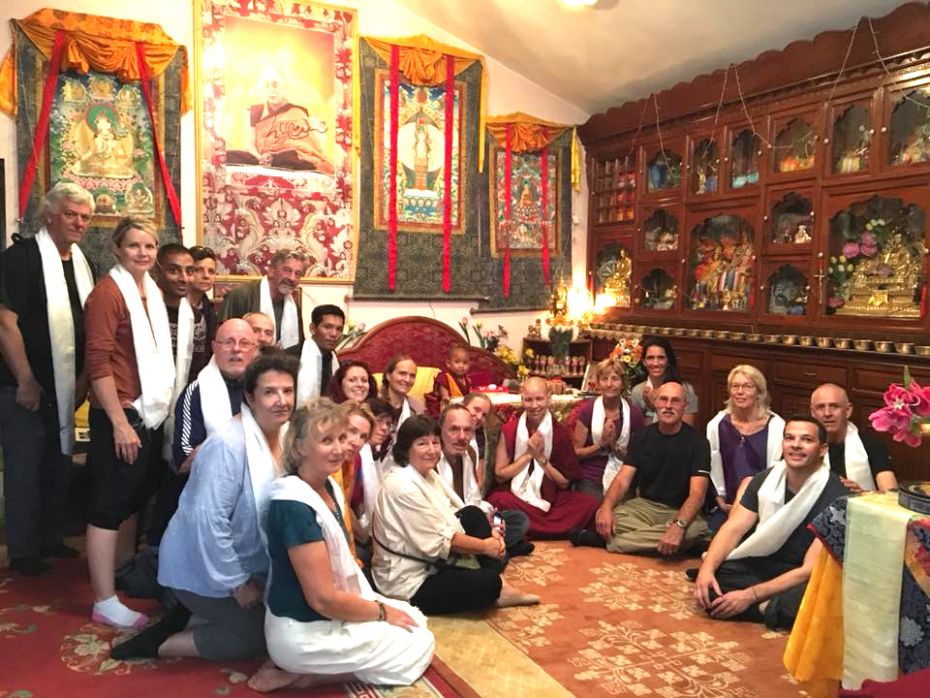
Tenzin Rigsel Rinpoche with Ven. Amy Miller and trip participants, Kopan Monastery, Kathmandu, Nepal, October 2018. Photo courtesy of Ven. Amy Miller.
We converged at Khachoe Ghakyil Ling Nunnery (Kopan Nunnery) for dinner. Our group came from Australia and Wales, from points all over the United States, from North and South America, and Europe, and they penetrated deep into my heart.
Within a week we were family, helping each other in a variety of ways: listening to each other’s coughs, passing around diarrhea remedies, tissues, and advice about the toilets. We shared laughs and compared our lifestyles that were incredibly varied. We were nurses and teachers; paramedics; mental health workers; yoga instructors; husbands and wives; mothers, fathers, and grandparents; nuns; aspiring yogis and yoginis; massage therapists; healers; retired civil rights workers; administrators; cleaners; and human beings who had an urge to explore and test the outer edges of the envelope, and reach this place called “Lawudo.”
After an introductory day walking the dusty lanes of old Thamel in Kathmandu—visiting the holy Chenrezig and Tara Temples near the Asan Tole market, the magical Prajnaparamita Temple, the magnificent Boudhanath Stupa, and Kopan Monastery where we enjoyed a lovely visit with Thubten Rigsel Rinpoche, the reincarnation of Khensur Rinpoche Geshe Lama Lhundrup—we prepared to fly up to Lukla, a small trekking village in Solu Khumbu District the next morning.
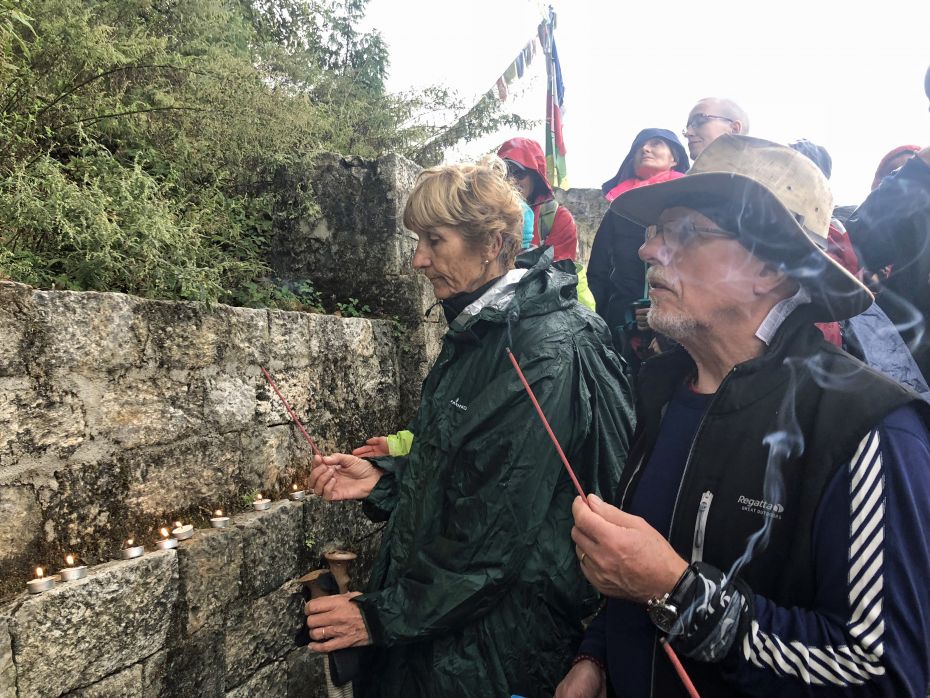
Trip participants making offerings to a naga tree outside of Lukla, Nepal, October 2018. Photo by Ven. Amy Miller.
It was a challenging time at the Kathmandu domestic airport, trying to get a group of twenty-five people up to Lukla in two planes. Somehow—after one group had already waited eight hours—the Red Sea parted. By 2:00 p.m. on October 7—with the clouds in Lukla still sitting high—the group landed on the mini landing strip in Lukla, and we were all ready for our walk.
Getting a late start, we offered tea lights and incense at the famous naga tree just outside of Lukla to aid our journey. We then crawled through some slippery rain—and eventually the dark—to arrive in Phakding, a small village in Solu Khumbu District, for our first night’s stay in the mountains. All was well.
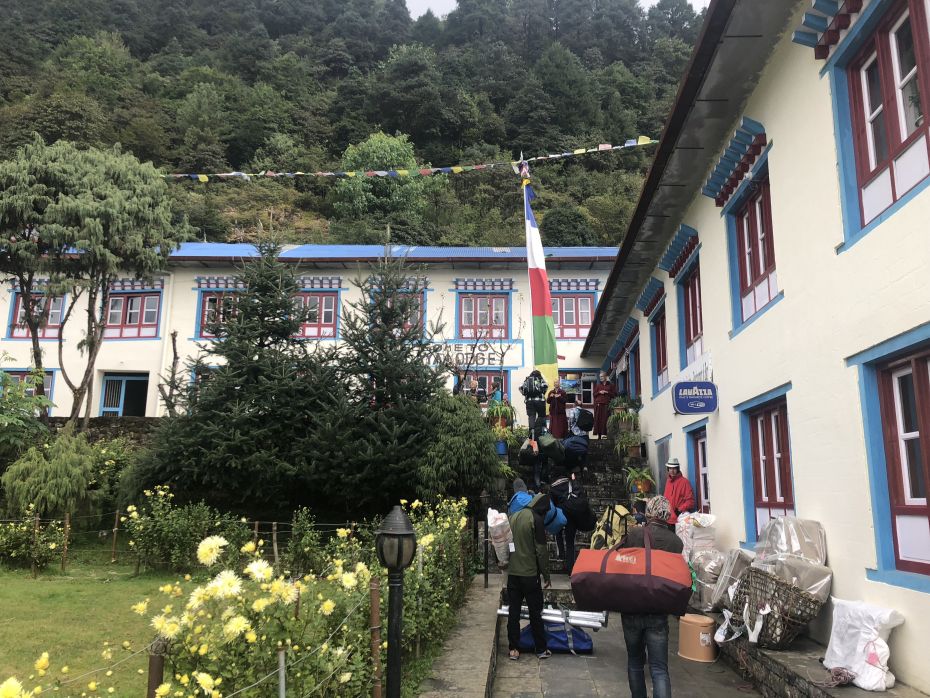
Himalaya Lodge, Lukla, Nepal, October 2018. Photo by Ven. Amy Miller.
The next day was our most rigorous with the Namche Hill enroute; most of us struggled our way to the top. We were exhausted and experiencing the altitude, but had three nights in Namche Bazaar and a hot shower (!) so there was time to re-energize.
Our lodge owners were lovely—Dawa who owns Himalaya Lodge in Lukla; old friends of mine who own Namaste Lodge in Phakding; and Nuru and Nawang who own Holiday Lodge in Namche—but the most phenomenal support came from Amber Tamang, our ground operator, and his amazing staff: Mingmar, Gausman, Pemba, and Sangay, along with a team of eight wonderful porters. We could not have done this trip without each of them.
We explored the rich trekking town of Namche—taking in views of Mt. Everest in the morning; hiking to the Everest View Hotel for lunch; visiting the Buddhist temple above the town; seeing museums; shopping for last minute items; and acclimatizing—all while becoming more and more bonded to each other.
The anticipation of Lawudo dangled in front of us, and finally on November 11, we were off ambling through the easiest part of the walk before the next big hill. We stopped in Teschio at the bottom of the hill for noodles, and then the final climb began.
A turn in the pine forest opened up a view; I gestured toward the massive expanse of a mountain and far above us: “Lawudo.”
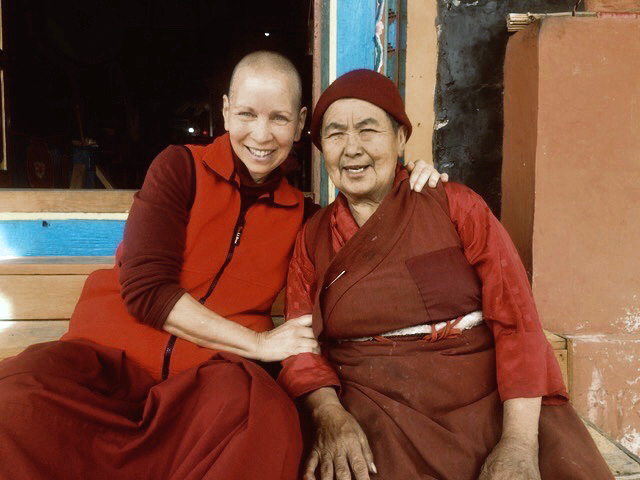
Ani Ngawang Samten and Ven. Amy Miller at Lawudo, Solu Khumbu, Nepal, October 2018. Photo courtesy of Ven. Amy Miller.
We arrived at Lawudo in the afternoon of November 11 to a wonderful greeting from Lama Zopa Rinpoche’s sister and brother, Ani Ngawang Samten and Sangay Sherpa who were coming across the yard. The support they gave us—the spoiling; the amazing team they hired; the delicious food—it was all quite stunning as it is such a hard place to live and work. We settled in and I was able to sit with everyone in the Lawudo cave that afternoon.
Our three-day silent retreat began the next evening, and everyone in our group joined whether Buddhist or not. It was heart-warming to feel the interest of everyone; how hard they worked at their meditations; and how the Lawudo family joyously supported us.
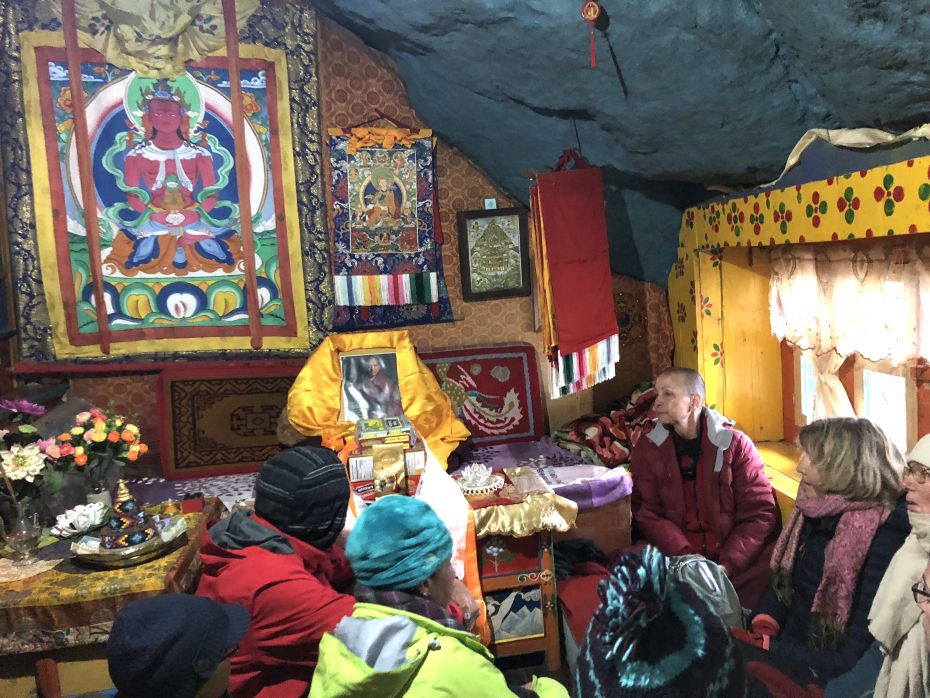
Ven. Amy Miller and other pilgrims in Lawudo Lama’s meditation cave, Solu Khumbu, Nepal, October 2018. Photo courtesy of Ven. Amy Miller.
At the end, much to my total surprise, Anila and Sangay offered a mandala to me (as if I was some holy being!), but I was able to convince Anila to move the mandala to Rinpoche’s throne as it was all a bit much for me. So kind!
The holy blessings of the guru; the concentration of the retreat in such a holy place; the tremendous effort made by the participants who were suffering from various colds and ailments; and the fantastic seamless support we received made it one of the richest experiences of my life. It felt like we were held in a sacred net of love.
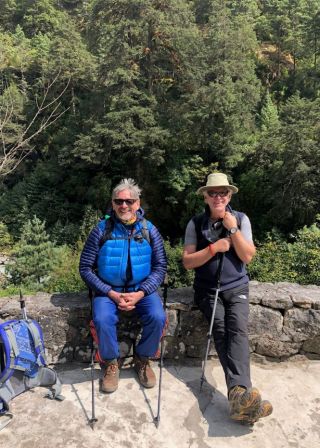
Trip participants taking a rest in Nepal, October 2018. Photo by Ven. Amy Miller.
The retreat finished the morning of November 16, and we went on some outings. We went on a twenty-minute walk behind Lawudo to Cherok to visit Pema Choden, a holy nun who lives in a cave, and walked a half hour down the hill from Lawudo to Thamo to visit the grand nunnery there and see some old friends.
On the way to Cherok we had the great fortune to pass and briefly talk with Cherok Lama, whom I have known since he was a child.
Ani Pema Choden, however is not one to open her home to twenty-some westerners. I was just hoping to borrow the keys to Merry and Harry’s caves, and show the caves to the group. She had other ideas, and ushered every last one of us inside for hot tang. Truly amazing!
We then hiked off to find the caves, and then slowly headed back to Lawudo for lunch, before heading down the hill to Thamo to visit the nunnery.
The nunnery’s gompa is over-the-top in beauty, and it’s wonderful that the nuns finally have an adequate place to live and practice. We were warmed up with tea while some of us sat in one of the nun’s rooms and the rest sat in the gompa during a puja. All were welcome, but as one pilgrim mentioned it was clearly a place of powerful women. No doubt!
The next day was a major trek to Thame—the birthplace of Lama Zopa Rinpoche—where we enjoyed lunch at Thame View Lodge. The lodge is now run by the brother of dear friends who live in Queens, New York, US, who are Rinpoche’s cousins. We were moved by the humble poor origins of Rinpoche’s birthplace. We visited Thame Gompa and the new stupa, modeled after the Boudhanath Stupa. We were fortunate to see wild mountain goats and returned to Lawudo for our last night.
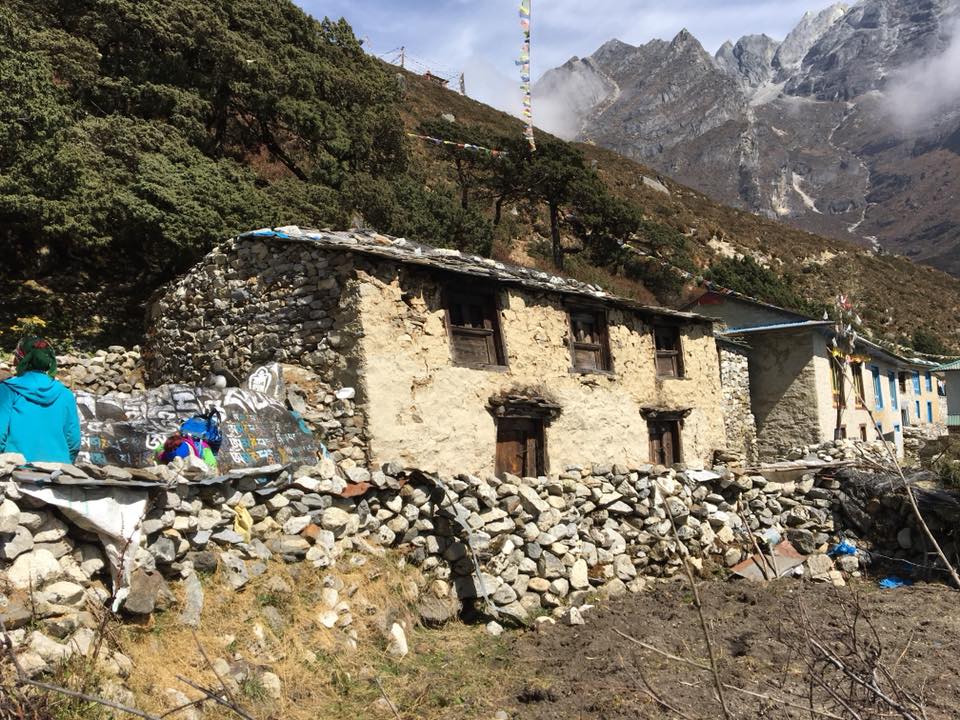
Lama Zopa Rinpoche’s birthplace, Thame, Nepal, October 2018. Photo by Ven. Amy Miller.
After one week, we said our farewells to Lawudo—to the amazing team; to Anila and Sangay; the holy cave; and to a few pilgrims who were either staying at Lawudo for retreat or heading off to other treks—and then we beat it back down the hill for lunch in Namche. It felt a lot easier descending.
We spent the night at Monju Guest House before heading back to Lukla the next morning. It was lovely to reconnect with two pilgrims who stayed in Namche—and other than our three guys who split off from the group—we were all together again.
Next was the day we were supposed to fly down from Lukla to Kathmandu. And it didn’t go very well. So we waited, and Amber called everyone he knew to try to get us down off the mountain. We were divided up so we could travel to Kathmandu by helicopters. Some people left in helicopters, some didn’t. Some people that we thought had gotten down to Kathmandu were still standing around in Lukla hours later. Some people got down to Kathmandu and then waited on the tarmac in Kathmandu for luggage that hadn’t arrived.
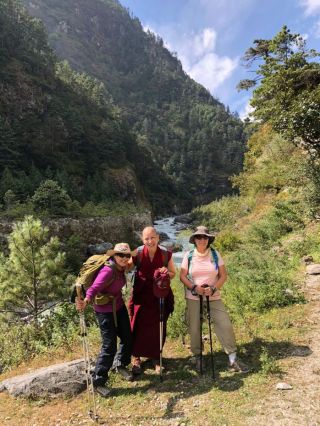
Ven. Amy Miller with trip participants in Nepal, October 2018. Photo courtesy of Ven. Amy Miller.
Twelve of us got stuck in Lukla overnight, and after much eager anticipation earlier that morning—thinking about being at the luxurious Hyatt Hotel in Kathmandu that evening—by 6 p.m. we were back at Himalaya Lodge in Lukla, dazed and confused, meekly ordering yet another veg fried rice.
Yet the resiliency of the group prevailed, and for the most part everyone just dealt with what was happening without complaints or negativity. Our group energy—the family feeling—was a true boon for keeping our spirits high and our sense of humor intact. After all, Lama Zopa Rinpoche’s interest is often in how disciples bear hardship. Not that all of the participants were disciples, but I think we were doing our best to bear the hardships.
Amber’s efforts, along with lodge owner Dawa, were fully admirable. We would not have made it down to Kathmandu so early the next morning had it not been for their efforts. It seemed once we were down at the Hyatt Hotel, ensconced in the hotel’s overwhelming breakfast buffet, most of the airport fiasco went away. Many commented on how the experience really made them appreciate the ease of our lives in the west.
So now most everyone has moved on to return home or onto other journeys. I have never felt such gratitude for being held by all the powers that be, so we could make this trip and stay safe and relatively healthy.
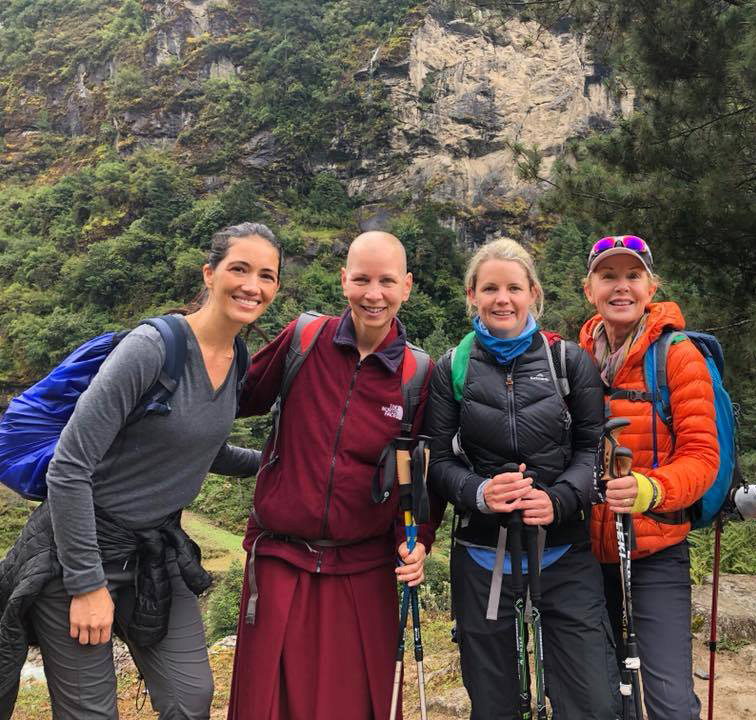
Ven. Amy Miller and trip participants in Nepal, October 2018. Photo courtesy of Ven. Amy Miller.
There is much to digest, which I hope to do back on the mountain. I am hoping to fly back up tomorrow morning, and will try to make it to Thamo nunnery for two Nyung näs, and then back up to Lawudo for a six-week retreat.
I will no longer have to count to see if everyone is with us, and will no longer have to make sure the spirits of those slower on the trail are still upbeat, and that everyone has food and is warm enough. It will be a party of one, but I will miss them all. I have decided it’s best that I carry them all in my heart. During my retreat, if they need extra support, I will make sure Anila keeps them safe and warm in the folds of her robes.
Watch Ven. Amy Miller’s nine-minute video about a previous trip:
https://youtu.be/0fEKPCFPxuI
For more information about Ven. Amy Miller, visit her website:
http://www.amymiller.com
- Tagged: in-depth stories, lawudo, nepal, pilgrimage, solu khumbu, ven. amy miller
1
His Holiness the Dalai Lama Teaches in Bodhgaya
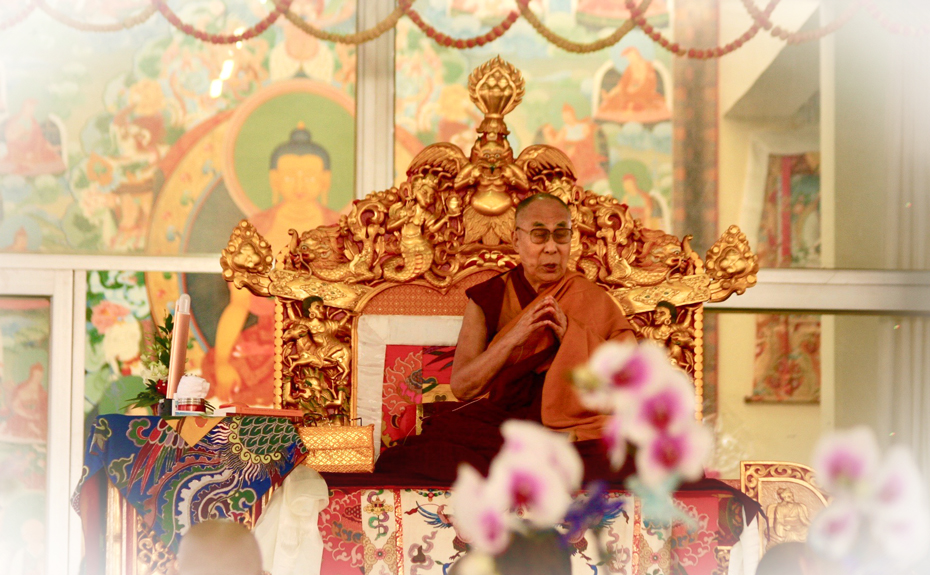
His Holiness the Dalai Lama teaching in Bodhgaya, India, December 2018. Photo by Cynthia Karena.
Few things are more precious than being able to see His Holiness the Dalai Lama teach in Bodhgaya, India, the location of the Buddha’s enlightenment. Australian student Cynthia Karena, a regular contributor to Mandala, traveled to India in December 2018 for teachings with His Holiness and shared this report with us.
I’m in Bodhgaya to see and hear His Holiness teach. He begins teaching on Christmas Eve with The 37 Practices of a Bodhisattva and will finish with the Manjushri empowerments.
Most of us are lucky that we don’t have mountains to cross by foot to be in the presence of His Holiness.
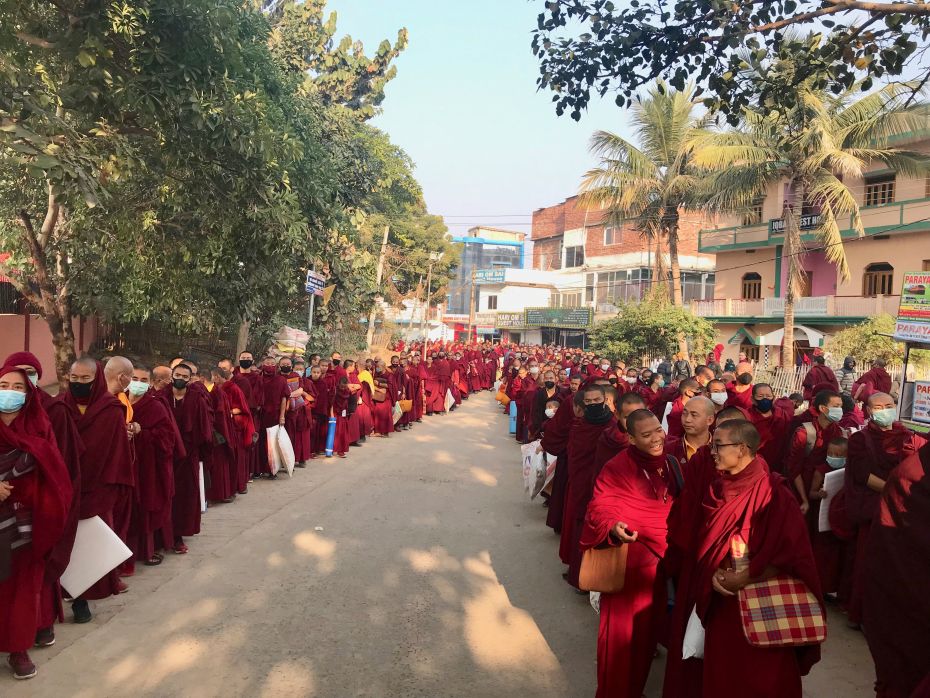
Ordained Sangha attending the teachings with His Holiness the Dalai Lama, Bodhgaya, India, December 2018. Photo by Cynthia Karena.
But the obstacles still come our way; it’s never that easy, especially in Bodhgaya, where it is in equal measure wonderful and dispiriting. Wonderful in that there is of course the stupa and the energy surrounding the place where the Buddha actually gained enlightenment. To be there is amazing. And dispiriting because invariably there is the “Bodhgaya blessing” (a cold and cough), not to mention stomach bugs.
Seeing beggars is interesting, and I mean interesting in how we individually relate to them.
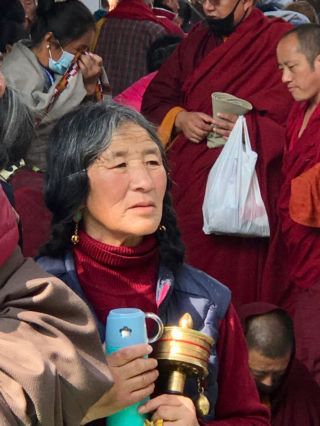
A Tibetan woman attending the teachings with His Holiness, Bodhgaya, India, December 2018. Photo by Cynthia Karena.
If this was a Kalachakra initiation, a Bodhgaya location would attract hundreds of thousands of people, but this year the crowds are in the more manageable tens of thousands. Estimates ranged from 40,000 to 50,000 at peak attendance.
A couple of practical tips given by His Holiness, mentioned before in teachings elsewhere, played on my mind this year. His Holiness spoke about giving with respect, which changed the way I give to the beggars lining the streets of Bodhgaya. I also noticed a Tibetan security guard having a light-hearted chat with one of the disfigured beggars and then shaking his hand. For me, it transformed the thought of beggars solely wanting money; some also, of course, want that human connection.
His Holiness also mentioned learning from “our Christian brothers and sisters who have helped so many people in need with health and education facilities.”
Root Institute does social service well with its school and health center, as well as MAITRI Charitable Trust with its programs. Since His Holiness has mentioned this a few times, I’m wondering how this type of service can be done elsewhere, in addition to visiting schools and raising money or donating goods to people in need.
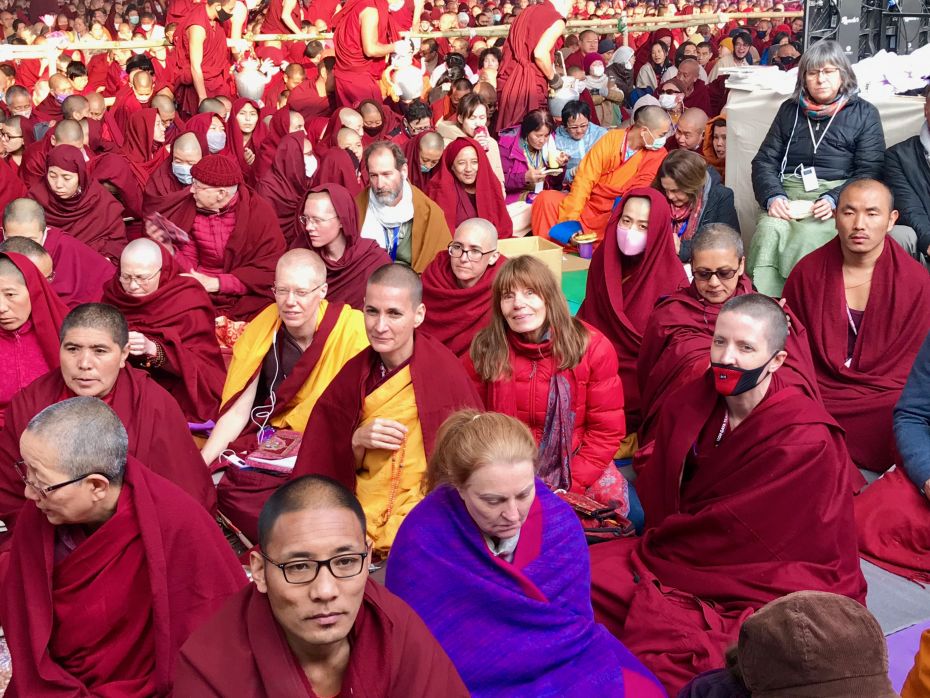
Many FPMT students attended the teachings with His Holiness in Bodhgaya, India, December 2018. Photo by Cynthia Karena.
At the long life puja for His Holiness, watching the oracles arrive and leave is a fascinating spectacle, with their colorful costumes, movements, head gear, and facial expressions.
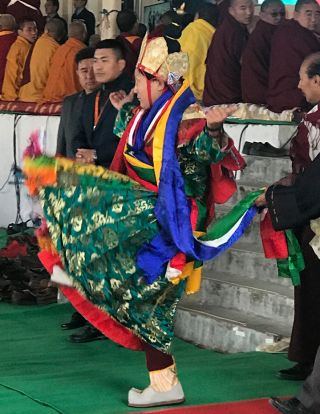
Nyenchen Thangla oracle at long life puja for His Holiness the Dalai Lama, Bodhgaya, India, December 2018. Photo by Cynthia Karena.
I scooped up some seeds that the Nechung Oracle, the State Oracle of Tibet, threw around as he left to give to the eager monks behind me. I kept a few, as I was told they are for protection. So apparently there is more to Buddhism than study and meditation!
Before leaving Bodhgaya, we did a couple of pilgrimages, to the Mahakala Cave and a couple of days later climbed the grueling 2,000 steps up the holy mountain of Gurpa, where legend says that when Kassapa, one of the Buddha’s disciples, meditated and had rocks closed around him, only to be released when the future Maitreya Buddha arrives.
In January next year His Holiness returns to Bodhgaya to finish the empowerments that he was not able to complete in Bodhgaya this time.
Learn more about His Holiness the Dalai Lama at DalaiLama.com. Offering service to His Holiness the Dalai Lama is one of Lama Zopa Rinpoche’s vast visions for the FPMT organization.
Cynthia Karena has a science degree and a masters in education. She is a freelance journalist and documentary researcher in Australia.
FPMT.org and Mandala Publications brings you news of Lama Zopa Rinpoche and of activities, teachings, and events from over 160 FPMT centers, projects, and services around the globe. If you like what you read, consider becoming a Friend of FPMT, which supports our work.
2
The Karmic Bond That Connected Us All in Mongolia
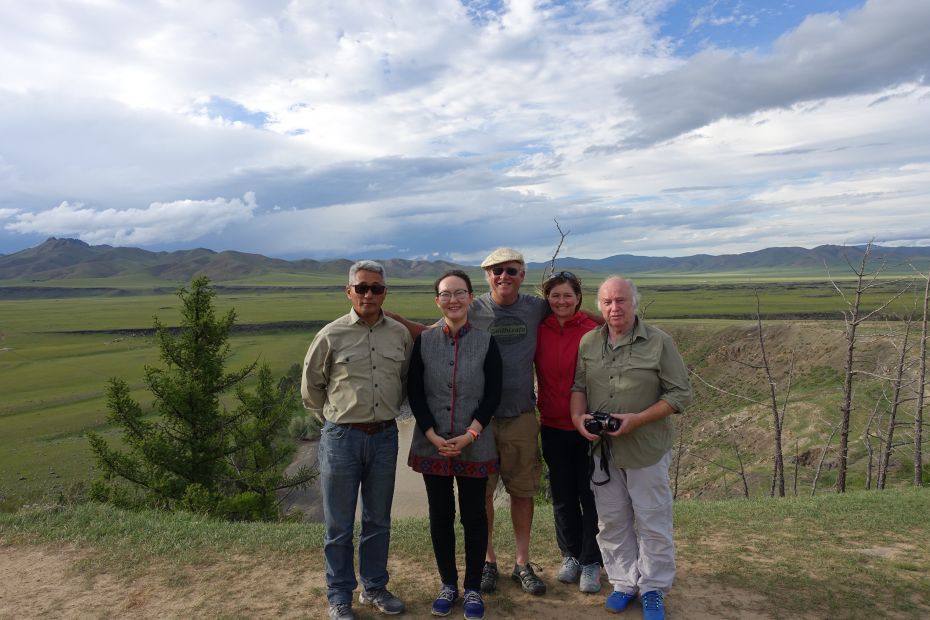
Feature image: Elena, and Cees on pilgrimage in Mongolia, August 2018. Photo courtesy of Ianzhina Bartanova.
Ianzhina Bartanova, director of FPMT center Ganden Do Ngag Shedrup Ling in Ulaanbaatar, Mongolia, shares about an August 2018 fourteen-day pilgrimage the center organized to holy sites in Mongolia.
Ganden Do Ngag Shedrup Ling placed an advertisement in the January-June 2018 issue of FPMT’s Mandala magazine inviting readers to join us for an August 2018 pilgrimage to the holy sites in Mongolia. It was the first pilgrimage for Western Buddhists organized by Ganden Do Ngag Shedrup Ling. Three courageous students from Bulgaria, Holland, and the US arrived in Mongolia in mid-August for the eleven-day pilgrimage, which later expanded into fourteen days.
The capital of Mongolia, Ulaanbaatar, is impressive: tall modern buildings, busy traffic, expensive cars on the roads, fancy restaurants with international cuisine including vegan and vegetarian options, comfortable hotels, and smiling people.
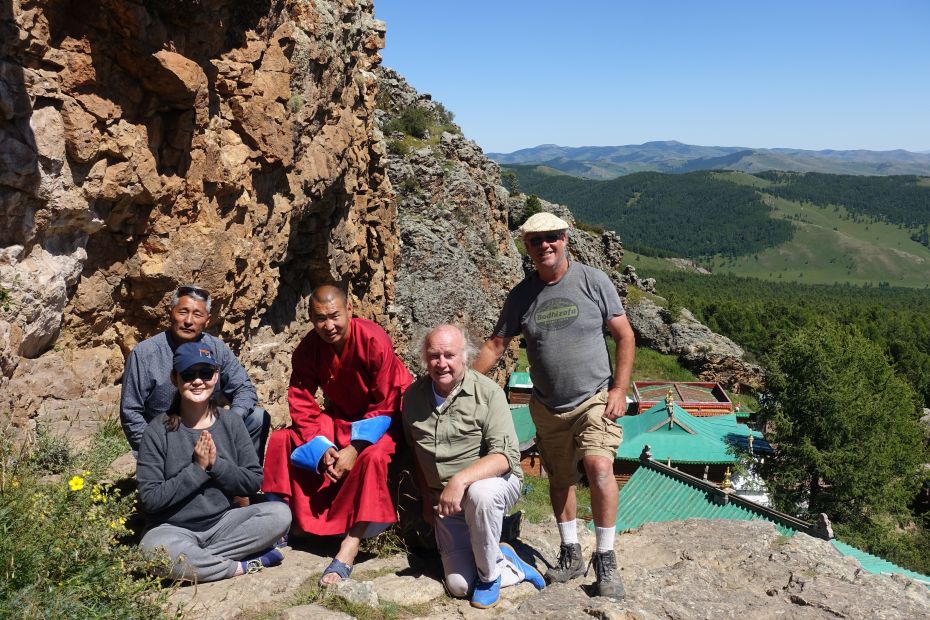
Driver Oyunbaatar, Ganden Do Ngag Shedrup Ling center director Ianzhina, a lama from Tuvkhun Monastery, Cees, and Bill in Mongolia, August 2018. Photo courtesy of Ianzhina Bartanova.
But the real jewels of our pilgrimage were the Mongolian monasteries, some of which were destroyed and then restored. A few survived the Communist purges of the 1930s and are home to some hidden artifacts, which were buried in the ground. Like the canvas for a masterpiece, Mongolia’s natural environment provided a framed backdrop for the holy sites, which appear like beautiful jewelry.
Together with the pilgrims, we visited approximately ten monasteries, took in a few natural sights, and made some visits related to Buddhist museums. When developing the itinerary, we recognized the importance of sharing some cultural aspects and traditions so our guests could have a richer experience of Mongolia. Therefore, we included some secular activities such as a traditional music show and a sightseeing visit to the largest Genghis Khan equestrian statue.
Our journey commenced in Ulaanbaatar at Gandan Tegchenling Monastery, the center of Mongolian Buddhism. It was the only Buddhist monastery preserved during the Socialist era. Joseph Stalin had the wish to demonstrate to the whole capitalist world that there was religious freedom in a socialist country.
Another special feature is that many monasteries in the countryside are located on hills or on top of a mountain. With each visit, we were able to enjoy not only the spiritual heritage of the place, but also breathtaking panoramic views.
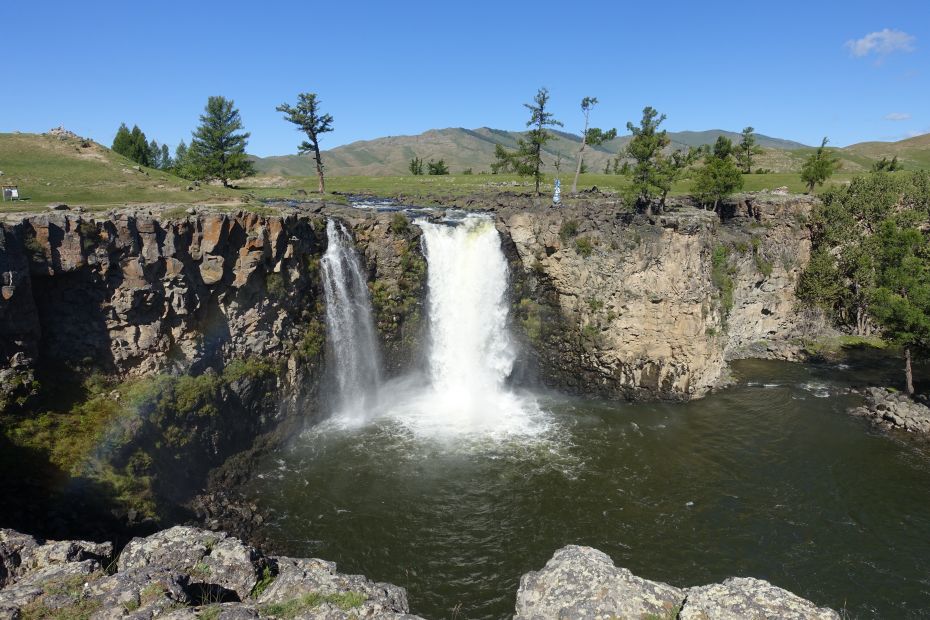
A large waterfall in Mongolia, August 2018. Photo by Ianzhina Bartanova.
The peak experience of our journey was visiting Tuvkhun Monastery, on top of Shireet Ulaan Uul mountain. Tuvkhun Monastery was founded by the great bodhisattva Zanabazar, the first Jebtsundamba, the “Dalai Lama” of Mongolia. We were able to feel the powerful and blessed energy of the monastery.
During our spiritual practices we experienced some obstacles, which we viewed as helping us to purify our collective and individual negative karmas. Major lessons of the pilgrimage were around purification of negative karma and the accumulation of merits. We practiced patience by sitting up in a vehicle for twelve hours. Our backs and buttocks were well and truly massaged by the end!
Actually we could call ourselves very fortunate because we were able to see the flood in the Gobi Desert! It was an unimaginable and almost impossible natural phenomenon—a rare sight! Due to the flood in the Gobi Desert, the only road leading to Khamar Monastery had been washed away. We had no alternative but to turn back after one full day of driving. Most of the group returned to this destination at a later time, when the ground had dried. This is the reason our pilgrimage was extended for a further three days.
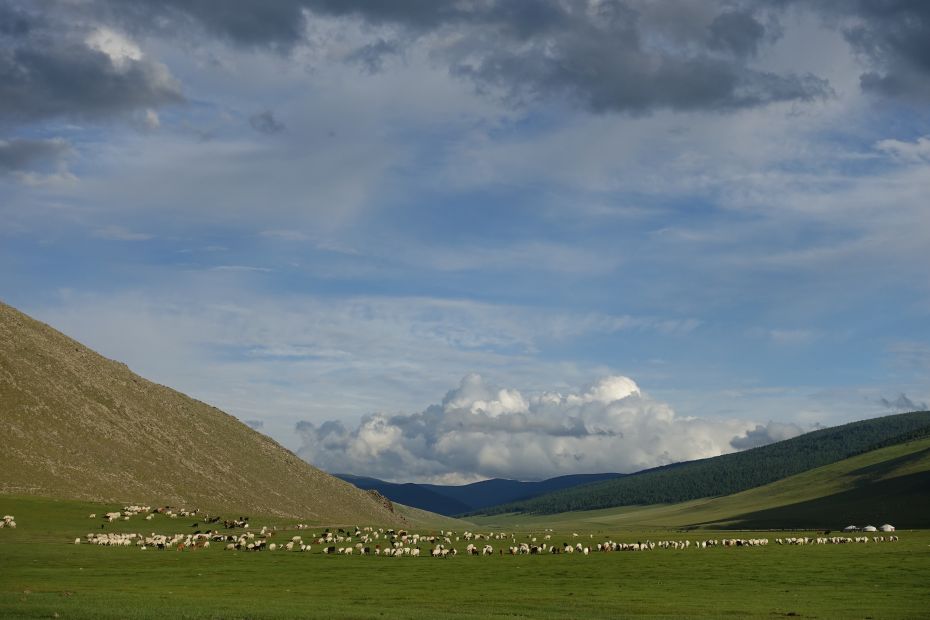
A valley with grazing animals, Mongolia, August 2018. Photo by Ianzhina Bartanova.
There were some other obstacles, such as tensions and closed restaurants. However, reflecting upon how the pilgrimage impacted myself, I can say that all challenges were not an issue providing a correct motivation was maintained for our activities. Serving the Guru is the best one. Through correct devotion and service to the Guru we can purify hundreds of eons of negative karma and benefit many sentient beings around us.
Lama Zopa Rinpoche said, “Pilgrimage needs faith. The more faith, the more happiness. Otherwise, you are just like a tourist looking at ruins.”
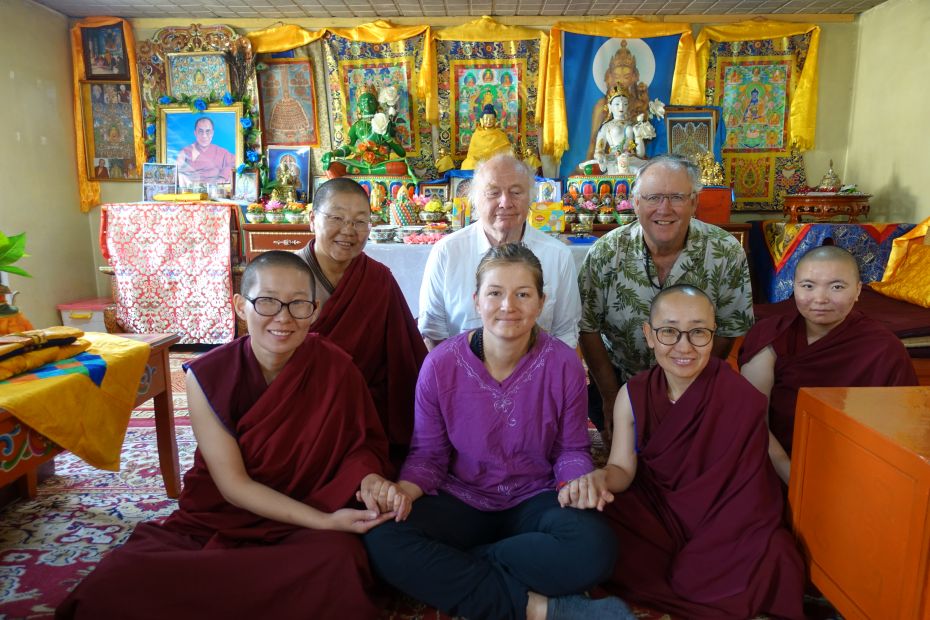
Ani Dechen, Ani Baljid, Cees, Elena, Bill, Ani Nyima, and Ani Choden at Ganden Do Ngag Shedrup Ling, Ulaanbaatar, Mongolia, August 2018. Photo by Ianzhina Bartanova.
Following Rinpoche’s advice, we recited Dharma prayers and did practices at every place we visited. We recited the names of the Thirty-five Buddhas, lamrim prayers, and the great bodhisattva Zanabazar’s special prayer. Ven. Thubten Gyalmo, our resident teacher, kindly guided us through setting a proper motivation at the beginning of our pilgrimage and a making our dedications at the end.
It was very interesting to observe the play of our respective karmas in such a short time. On the tenth day of our pilgrimage, we were blessed with an audience with Jhado Rinpoche! A wonderful surprise for us all! As novices on the Dharma path, we couldn’t imagine that Rinpoche would find time in his very busy schedule to talk to us.
By the end of the pilgrimage we had all become great friends. We are not sure if our paths will cross again. However, we admit that there was a strong karmic bond that connected us all in Mongolia.
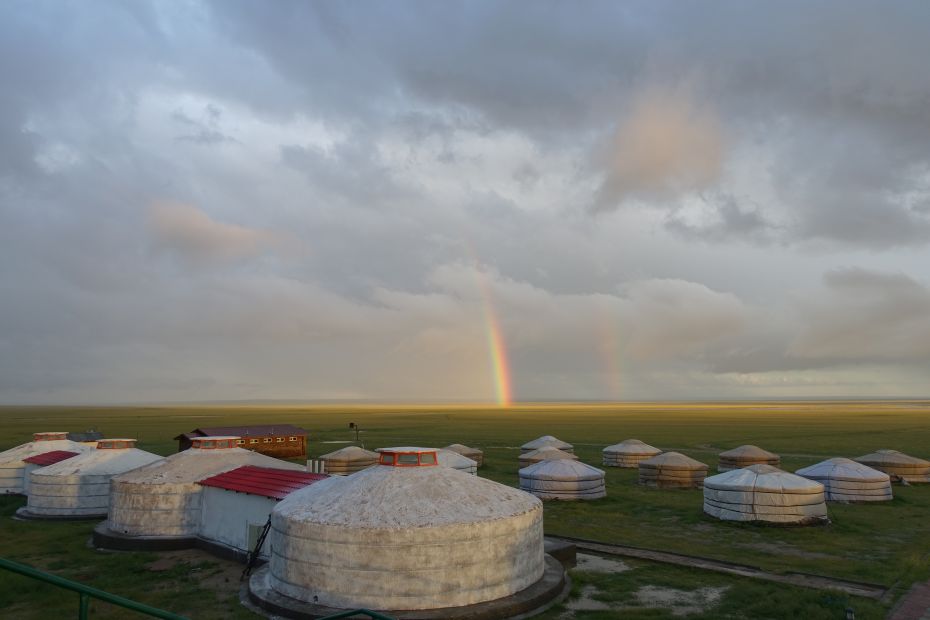
Ger camp in Mongolia, August 2018. Photo by Ianzhina Bartanova.
I will conclude my story with one special highlight. One night when we were in the middle of nowhere, in an eco ger camp without electricity and water, we saw an exquisite night sky full of bright stars. I had the impression that I could reach up and touch the sky, and all of these stars were bound together like one shiny net. So likewise were we linked together in the net of samsara.
For more information about Ganden Do Ngag Shedrup Ling, visit their website:
http://www.fpmtmongolia.org/shedrub-ling-center
- Home
- News/Media
- Study & Practice
- About FPMT Education Services
- Latest News
- Programs
- New to Buddhism?
- Buddhist Mind Science: Activating Your Potential
- Heart Advice for Death and Dying
- Discovering Buddhism
- Living in the Path
- Exploring Buddhism
- FPMT Basic Program
- FPMT Masters Program
- FPMT In-Depth Meditation Training
- Maitripa College
- Lotsawa Rinchen Zangpo Translator Program
- Universal Education for Compassion & Wisdom
- Online Learning Center
- Prayers & Practice Materials
- Overview of Prayers & Practices
- Full Catalogue of Prayers & Practice Materials
- Explore Popular Topics
- Benefiting Animals
- Chenrezig Resources
- Death & Dying Resources
- Lama Chopa (Guru Puja)
- Lama Zopa Rinpoche: Compendium of Precious Instructions
- Lama Zopa Rinpoche: Life Practice Advice
- Lama Zopa Rinpoche Practice Series
- Lamrim Resources
- Mantras
- Prayer Book Updates
- Purification Practices
- Sutras
- Thought Transformation (Lojong)
- Audio Materials
- Dharma Dates – Tibetan Calendar
- Translation Services
- Publishing Services
- Teachings and Advice
- Find Teachings and Advice
- Lama Zopa Rinpoche Advice Page
- Lama Zopa Rinpoche: Compendium of Precious Instructions
- Lama Zopa Rinpoche Video Teachings
- ༧སྐྱབས་རྗེ་བཟོད་པ་རིན་པོ་ཆེ་མཆོག་ནས་སྩལ་བའི་བཀའ་སློབ་བརྙན་འཕྲིན།
- Podcasts
- Lama Yeshe Wisdom Archive
- Buddhism FAQ
- Dharma for Young People
- Resources on Holy Objects
- Ways to Offer Support
- Centers
- Teachers
- Projects
- Charitable Projects
- Make a Donation
- Applying for Grants
- News about Projects
- Other Projects within FPMT
- Support International Office
- Projects Photo Galleries
- Give Where Most Needed
- FPMT
- Shop
Translate*
*powered by Google TranslateTranslation of pages on fpmt.org is performed by Google Translate, a third party service which FPMT has no control over. The service provides automated computer translations that are only an approximation of the websites' original content. The translations should not be considered exact and only used as a rough guide.According to the Buddhist view, there is no human problem that cannot be solved by human beings.
